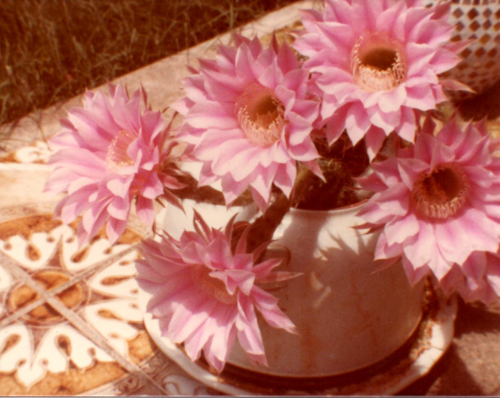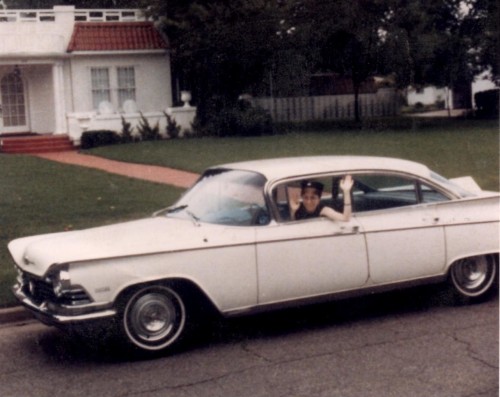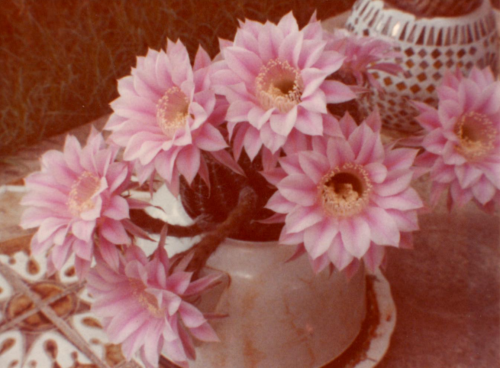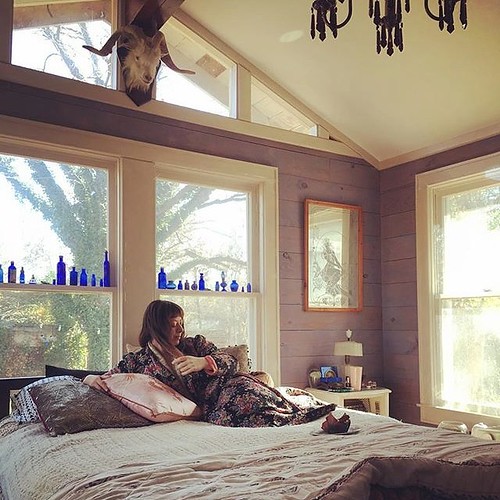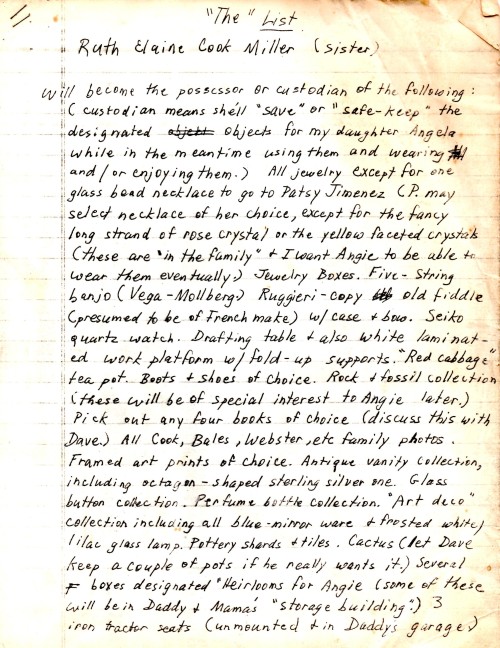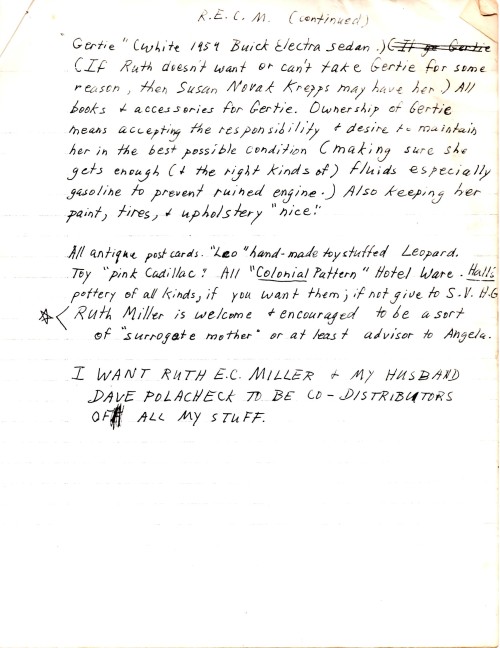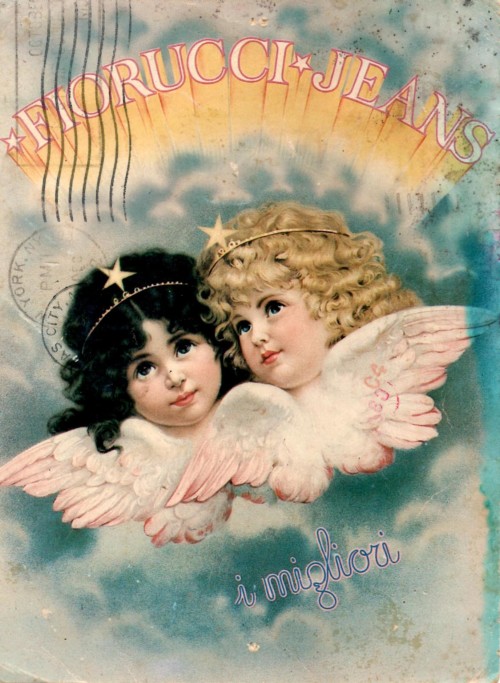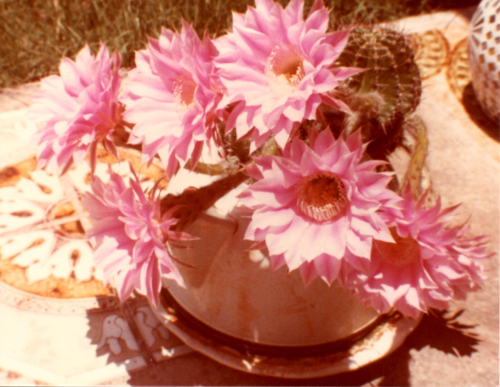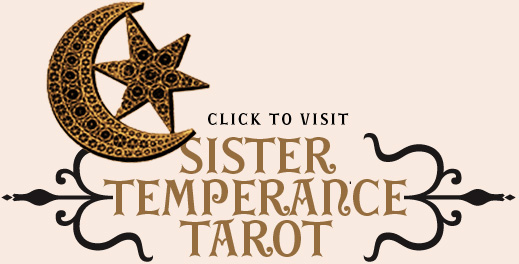The Wizard’s Jar
by angeliska on August 9, 2023
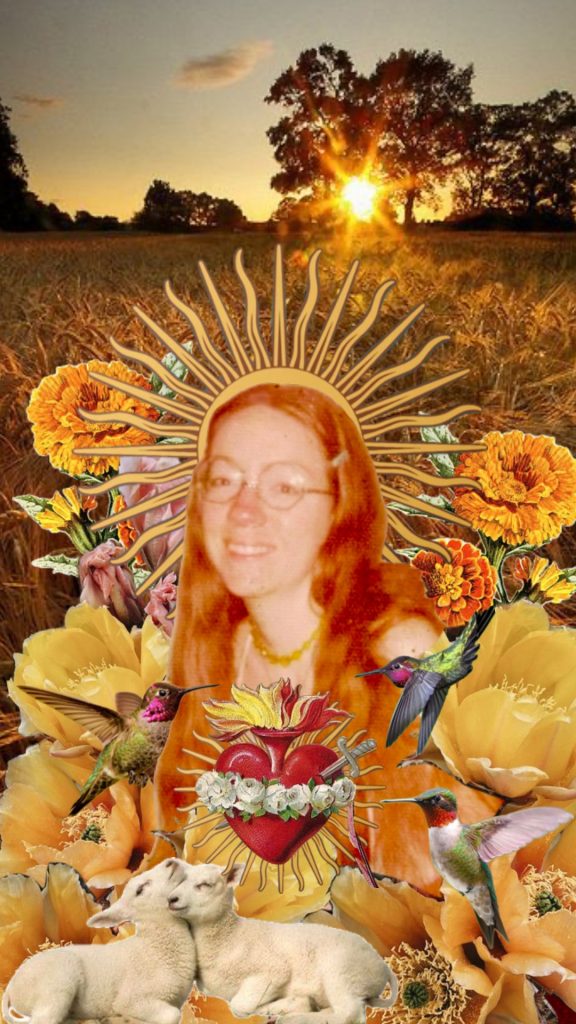
August 8th rolled around again this year, as it does — a battering ram of intense heat, like living in a furnace, with no respite from rain in sight. I’ve been recovering from Covid, so having a fever and congestion in the midst of the longest stretch of days over 100 degrees feels especially heavy. I’m staying inside, hiding out in front to the fan on high blast in my dark, cave-like living room. I gave myself permission to take it easy yesterday, rest as much as possible, and not push the inspiration for this writing.
Some years, I have a clear sense of what I want to say and convey — and others, like this one, remain more oblique. I took space and quiet to just let myself feel, reading old letters my mom wrote to my grandparents years ago — thick sheaves of lined notepad paper, filled with her even, meticulous hand detailing accounts of car trouble, money worries, bad colds, inclement weather, and promises that she had stopped smoking grass. I thumbed through her gorgeous scrapbooks, perfect time capsules of the 1970s, her friendships, interests, and a document of her falling in love (and shacking up) with my dad.
I’m 44 this 8/8, and in my sickened state have been musing on various threads of thought around aging, the halving and doubling of significant numbers, and the meanings we attach to them. My mom died at 38, which has always seemed impossibly young, but especially now that I find myself firmly ensconced in a version of middle age that she never got to experience. I’ve written before about her fixation on Hank Williams and John Keats — on all the starry-eyed, haunted troubadours who died young (and stayed pretty), and who became legends, through not only their genius, but their tragedy. They never got the opportunity to become mediocre, boring, or saddled with extra weight, debt, and ignominy.
I’m starting to fully recognize that aging truly is a privilege, though — and all its heartbreaks and challenges are infinitely preferable to dying at 25 of tuberculosis in Rome, or of an overdose in the backseat of a Cadillac in the early hours of New Year’s day at age 29, or wasting away from cancer at only 38 in your grandmother’s old house in a ghost town (which is the way my mother went).
My grandmother was 40 years old when she had my mother, her first of four children. I think there was a lot about the times they were living through, and the cultural divides of the 1960s and 70s that probably made my grandparents seem even older than they were, being country people, who though were very open-minded, never got especially “groovy”. The last time they might’ve seemed young, color film hadn’t yet been invented, so all the images of their (hard-bitten Great Depression era) youths were in black and white.
My mom never got to see them become truly old, though — her parents both outlived her, doubling her lifespan and living into their 90s. Their care fell to my Aunt Ruth, my mom’s sister — who I’m now (blessedly) getting to see age and become the beautiful crone my mother never got to be. There’s something about the changing relationships when your parents become true elders, and you are truly no longer a child, or even really young. It seems the natural way, painful as it is, for children to grow up, and come to bury their parents one day. No child should have to bury a parent, and it’s such a terrible grief for any parent to have to bury their child.
As I have worked on healing my wounded inner child over the years, I find myself softening — especially in relationship to my parents. I was more hard-edged and raw in lots of ways, even a year ago. My body is softening (despite my half-hearted efforts to firm and tone it), and my heart is gentling slowly — melting into the places that were scarred over with grief, rage, blame, and shame, for far too long. It just started feeling too heavy to hang on to, to carry. I am trying to feed and nurture that softness in me, because it makes me more available for connection. For love.
Becoming more available and present for the relationships in my life matters to me more and more, as the sand in the invisible hourglasses we all have floating over our heads seems to fall faster and faster.
Most of us don’t have much of a choice of when, where, or how we finally cross our finish line — and it could always be the day after tomorrow, or decades from now. But as we get older, it starts feeling closer, and more inevitable. Not only that, but the mortality of our living parents and elder relatives looms in an uncomfortable way. I still lay awake at night, consumed with anxiety at the idea of my folks passing — and know that I have to prepare for everything that will mean. I hope it’s a long, long time from now — but none of us have forever.
All my elder relatives managed to avoid becoming seriously ill or dying from Covid, thank goodness —though the past few years have been riddled with terror for me, at the thought of any of them on ventilators. I’ve lost two uncles in unexpected and terrible ways, and my stepmom has been struggling with serious health issues this year. It’s been really scary, and I’m not even in a caretaker role for anyone I love, currently.
————
Since I began writing this piece (which I had to put on hiatus while I recovered from Covid), my stepmomma Karen went into the hospital with breathing issues, and has since entered home hospice care. The reality of losing her is devastating to me, for everyone in our little family — and most especially to my dad, who has already experienced the loss of a partner decades ago (and can still barely talk about that). We’re all just trying to make every moment we have with Karen count, because we don’t know how much longer we’ll have her here with us.
The other evening, my dad gathered us together at Karen’s bedside to share a story of how they met — which weaves into the story of how my dad and mom met, too. I’ll do my best to braid them together here, but there are a lot of timelines that keep getting tangled up and bleeding into one another. But perhaps that’s just part of the complex nature of time and destiny…
It all makes me think of a quote from the novel Mating by Norman Rush, where the narrator is discussing a Russian way of thinking about fate, and time:
“He said, There is a school of thought, a heresy from the madhouse of heresies in the ninth century, that says God is good and is in control of every individual thing that happens, every event, but that unfortunately the devil is in control of timing. Hence, gaffes. Hence, the actually existing world.”
In many ways, it seems the devil was on our side — because there are so many aspects to the way our lives all became connected and intertwined that I just cannot explain. I owe my very life to that mysterious timing.
To tell the story properly, I’ll have to back up, to a few months ago…I was driving with my dad, taking him on some errands to get prescriptions filled and such, when we started talking about the nature of fate, and whether believed in it.
My father has been expressing to me over the past years that he believes strongly that we are being divinely guided — that nothing is an accident or coincidence. He told me the story of how he came to meet my mother, all the (seemingly) random events that had to come together for them to cross paths. My own existence is wrapped up in that story — because would I even be here if none of this had happened in exactly the way that it did?
The story goes something like this (I’m retelling from the memory of what he told me, so I may get some details wrong, but I’ll give it my best shot)…
One bright day, sometime after the heyday of the Summer of Love, on the streets of San Francisco, my dad was busking with his folk trio, “Old Scratch and His Hard Times String Band”. It was him, Mark Ross, and Clarke Buehling — but beyond playing music with my dad that day, they’re not part of this story. Just down the road, another folk musician was set up on a street corner — but despite being both extremely talented and totally gorgeous, no one was listening to Natalie Zoe. Her block was a ghost-town, which was unusual for that area, normally a great spot for busking.
After awhile, she decided to pack it in, and go see where everyone was — and once she could hear the jangle of a banjo and saw the audience forming around my dad’s band, she figured it out. Old Scratch had been stealing her crowd! But she had to give them credit — they were pretty darn good, and she stood watching them until they took a break. Nat struck up a conversation with my dad about them being her competition, and my father (bold as brass) flirted it up with her, and got her phone number. He says this normally wasn’t his move, but I’m not sure I believe him! He’s always had a predilection for folk-music playing women, and I exist because of at least two of them he was enchanted by (spoiler alert, for those who don’t already know, Natalie Zoe is not my mom!)
Long story longer, they hit it off, jammed together, and decided to travel around the country in Natalie’s Volkswagen Bus, playing music for tips as they went. The hippie pair ended up in Milwaukee, Wisconsin of all places (oddly, my paternal grandfather’s birthplace), staying with some friends and trying to plot their next move. It was starting to get colder, and that year’s version of the Summer of Love was fading fast. The van wasn’t going to be fun to live in through an icy northern winter, and after weeks on the road, the relationship was beginning to fray at the edges.
Some friends of friends they were hanging out with mentioned they’d heard that Austin, Texas was a really happening place, where the winters were mild, everybody was turned on, and jam sessions and buskers could be found on every corner. That checked all of their boxes, so they pointed the VW bus southward, and eventually Natalie Zoe and my dad were wandering around the streets of Austin, exploring the head shops and coffeehouses around the University of Texas campus.

One afternoon, towards the end of June, Natalie Zoe wanted to pop in a funky vintage store on San Antonio Street in an old house called The Wizard’s Jar. My dad had no interest in vintage clothing or curios, and though he and Natalie were pretty much on the outs when it came to their romantic association, he humored her and came inside to look around while she delved into the racks of old dresses and fringed frippery.
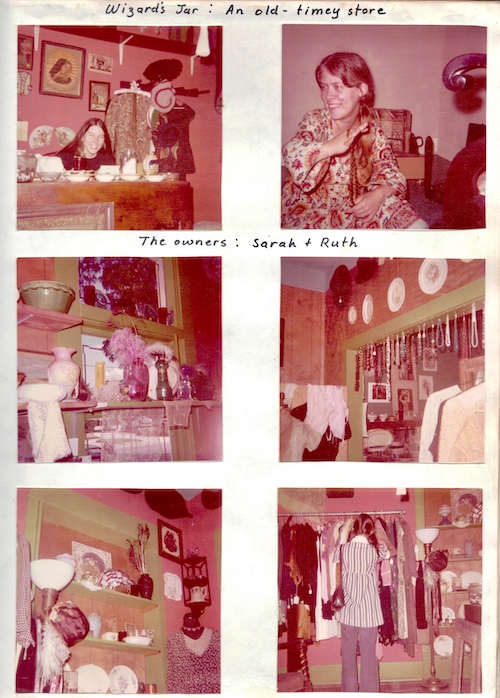
One of the owners of The Wizard’s Jar was Sarah Green, one of my mom’s dear friends, who later became my godmother.
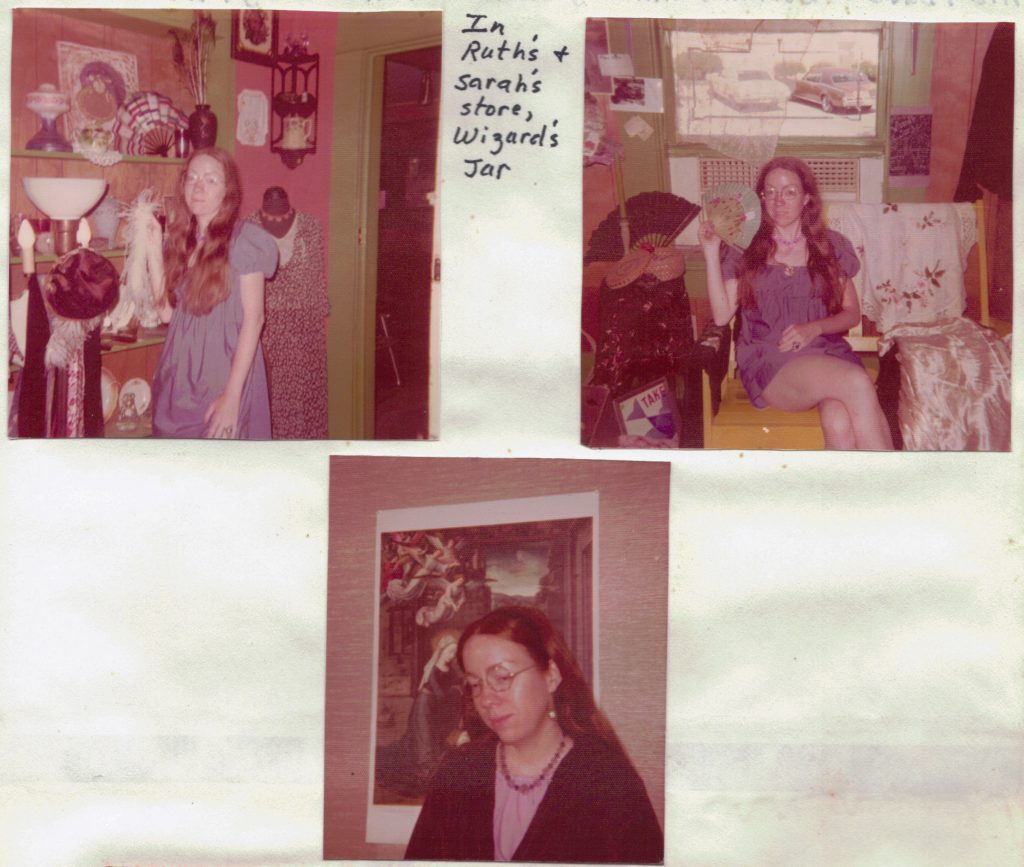
Beckoned by an old-time tune being played, my dad turned a corner and found a strange red-haired woman playing autoharp in an old rocking chair. He had been lured by a freckled hillbilly hippie’s siren call! Another moment of blessed boldness had them exchanging phone numbers, and the rest was history. Was it love at first sight?
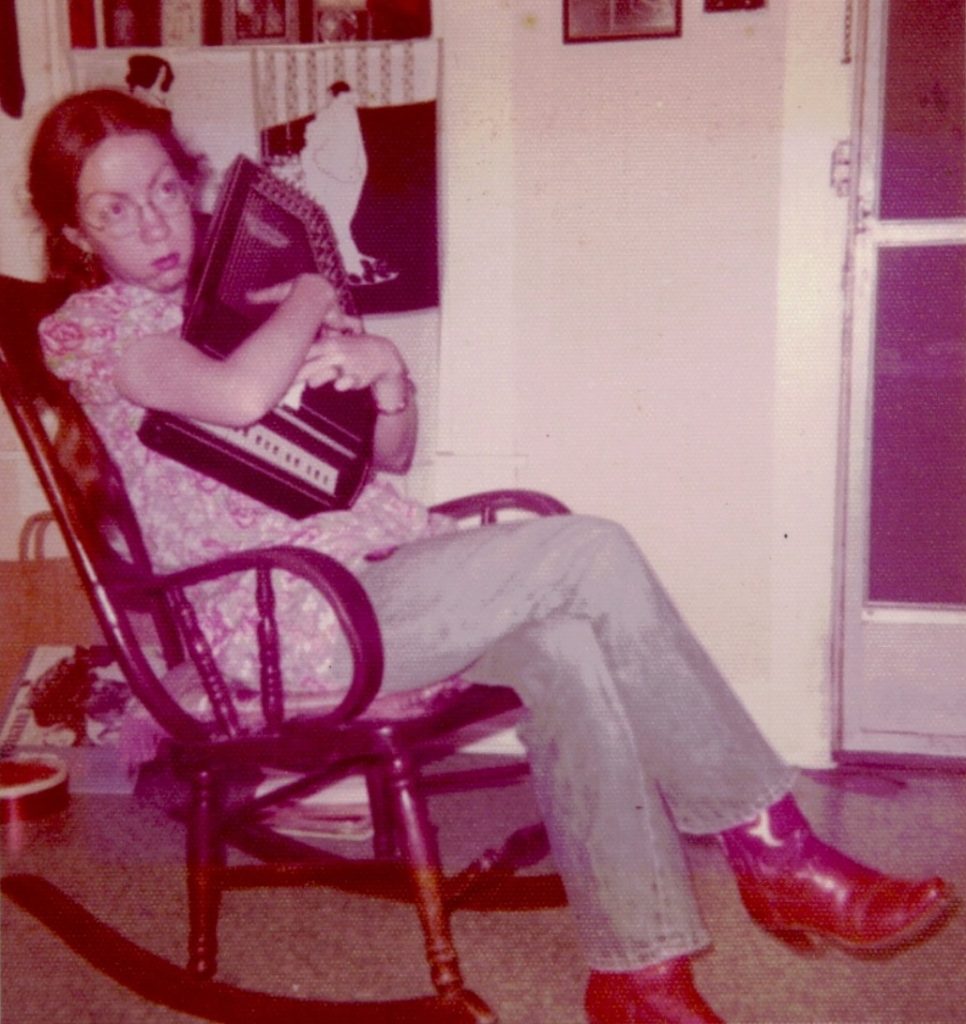
My parents were very much one another’s “type” at the time (my dad’s type is lovely women who play music, and my mom’s type was definitely hairy hippies with a love for stringed instruments!). Maggie and Dave definitely had an affinity and deep appreciation for one another, and a deep love developed. They moved in together, got married, and eventually — I made an appearance on their scene.
If one thing had been different, if this choice that led to that choice had somehow been altered — could it all still have happened in just that way? Would my dad have decided to leave California and come to Texas without that spontaneous trip with Natalie Zoe? And if he had, would he have run into my mother somewhere else (at the right place, right time — when ideally they were both more or less free to pursue one another?)
What an odd twist of fate that Natalie Zoe would bring my New Yorker (by way of Los Angeles and San Francisco) dad to Austin, Texas — of all places? And that they would just happen to bop into the shop where my mom was hanging out that day? They all remained friends after this loverly switcheroo, and my mom and dad later attended Natalie’s wedding to a hippie dude named “Aumla”, which I don’t think lasted very long — but the photos are quite epic!

It warms my heart that my mom put these photos in her scrapbook — and that she and my dad were invited to the wedding of his ex-girlfriend and her new man, which took place under a patchwork chuppah, on the banks of the Pedernales River.
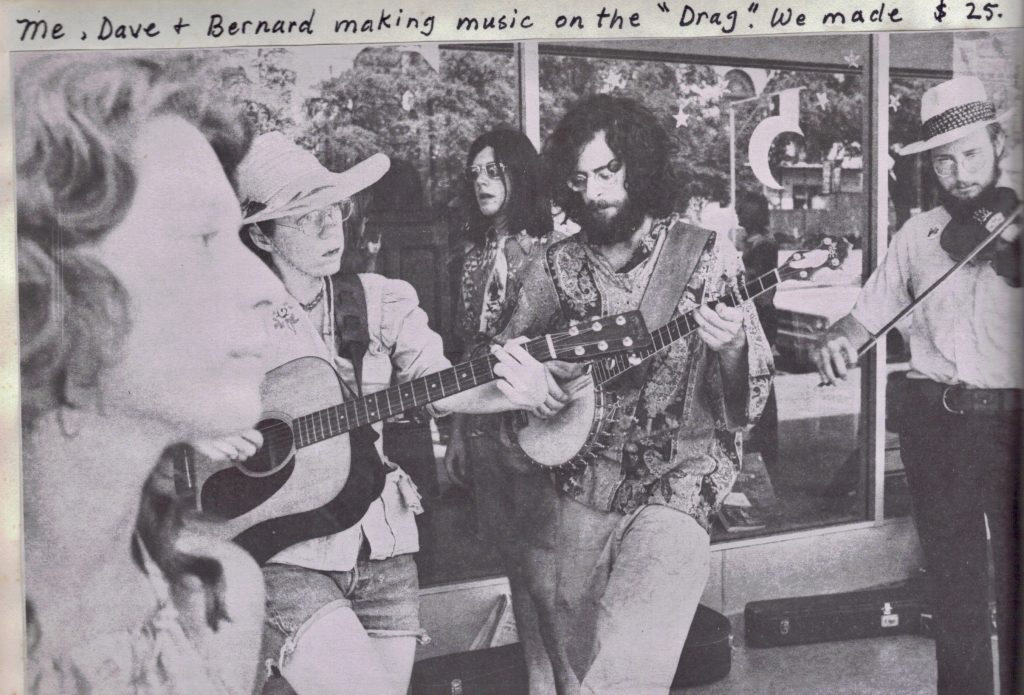
Here are my folks busking on The Drag (the strip of businesses across from UT that used to be bustling with vibrant street culture, music, and an artist’s market). Busking was the thread that indirectly brought my parents together, and playing music together was a huge part of my dad’s relationships with both my mom and stepmom.


I’m not exactly sure why my mom ripped away parts of her own face in these photos, but still liked them enough to glue in her scrapbook. Probably because she hated her nose — which was sort of a square Irish “potato nose” that some folks in our lineage inherited from one ancestor or another. Later in her life, she saved up for a nose job and got it “fixed”, which I think made her happy enough with her appearance to stop shredding up photos of herself.
I do still like these, though. It was from a happy time in the beginning of my parents’ relationship, when they were wild and free and horny and living in Austin, Texas at the absolute height of its heyday as a counterculture paradise — long before they got married, had to get real jobs, accrued bills and debt, and way before I was ever a twinkle in their eyes.
It’s possible that that particular twinkle was kindled the afternoon they dropped LSD together. The acid was just starting to kick in when a frantic knocking at their door revealed two of their friends (a married couple) with their toddlers in tow. The couple needed an emergency babysitter for a few hours, and asked my folks if they’d be willing to watch the kids for a bit. Not knowing how to explain that they were high as all hell, they agreed — because, 1. It’s really impossible for some reason to explain to people who are not tripping that you are tripping, and B. How hard could babysitting (on acid) be? Luckily, the afternoon was a lot of fun for everyone involved, and everybody remained safe and sane. A starry-eyed Maggie and Dave took the kids to Shipe Park down the road, and played on the swingset until sunset — and I’m sure giggled at everything a LOT.
I have a theory that all children are naturally tripping all the time anyway, so I think it makes sense that they got along so well. Later, when the parents came to retrieve their progeny, my future parents looked at one another and said, “Having kids could be really fun! We should think about doing that one day!” I’ve always imagined that I was conceived that very evening — but my father says otherwise. Regardless, it does make sense that the inspiration for my creation was psychedelically influenced (which explains a lot). Unfortunately, it turns out that parenting is a lot more difficult when you’re not having a perpetual daytrip, and where you’re relieved of your responsibilities at the end of the day.
The strains of their responsibilities (me among them), definitely took a toll on my parent’s marriage, and they started to have problems as the golden glow of the 1970s waned, and the crushing reality of the 1980s recession bulldozed Eden (and put up a parking lot). I honestly don’t know if they would have stayed together, had my mother survived cancer. She was threatening to leave (and take me with her), before she got too sick, and they slept in separate rooms, towards the end (I was told it was because my dad snored.) Maybe they weren’t one another’s true soulmates — but I’m grateful for the sweet times they had together, and the DNA they blended up to make into me.

———-
Now here comes the rest of the story — the one that was related to me the other night. We gathered at Karen’s bedside — she’s grown very weak, and is having a hard time projecting her voice, but despite being pretty high on morphine, she was able to help my father tell this tale…
While I was at my parents’ house, I was looking through old family photo albums, hoping to find some photos of Karen from the 70s, to share in this writing, but most of the ones from that era seem to have been sadly lost in a fire. The images I have of her are from after our family joined together, or from when she was a little child. Neither of the photographs I have from the era I’m writing about here really do justice to how beautiful she was (and is), but I want to share them here.
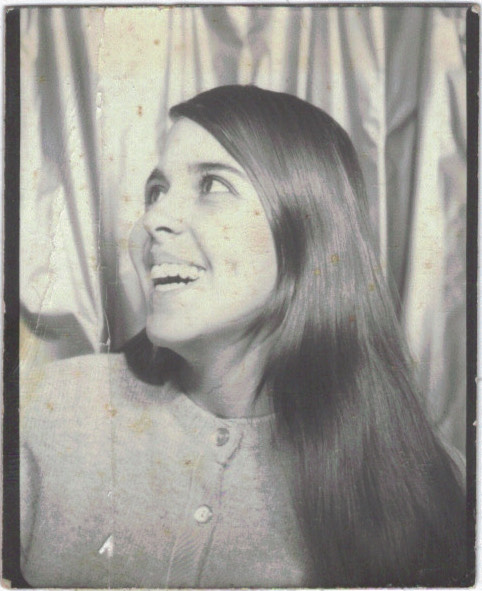
A photobooth snapshot of Karen, probably from just after high school. I love this one, and have it framed by my bedside. I love her smile.
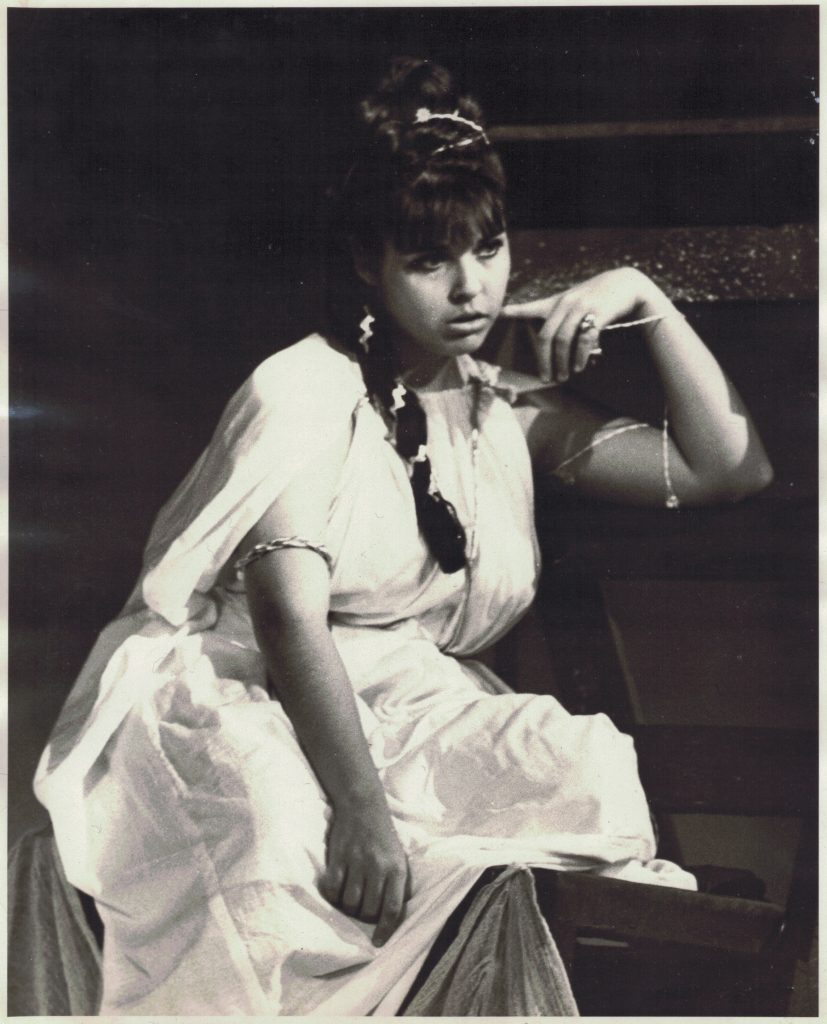
Karen as “Libra” in college play or production of some kind. She was a total babe (and didn’t really know it).
During the same time that my parents first met, Maggie (my mother) and Karen (who would later become my stepmother) were good friends at the Craft Center in the Student Union at the University of Texas, where they were both studying art. My mom made jewelry there, while Karen made ceramics on the pottery wheel. One day, Karen remembers Maggie coming in and telling her, “I met someone really special! His name is David — I think this could be a thing…”

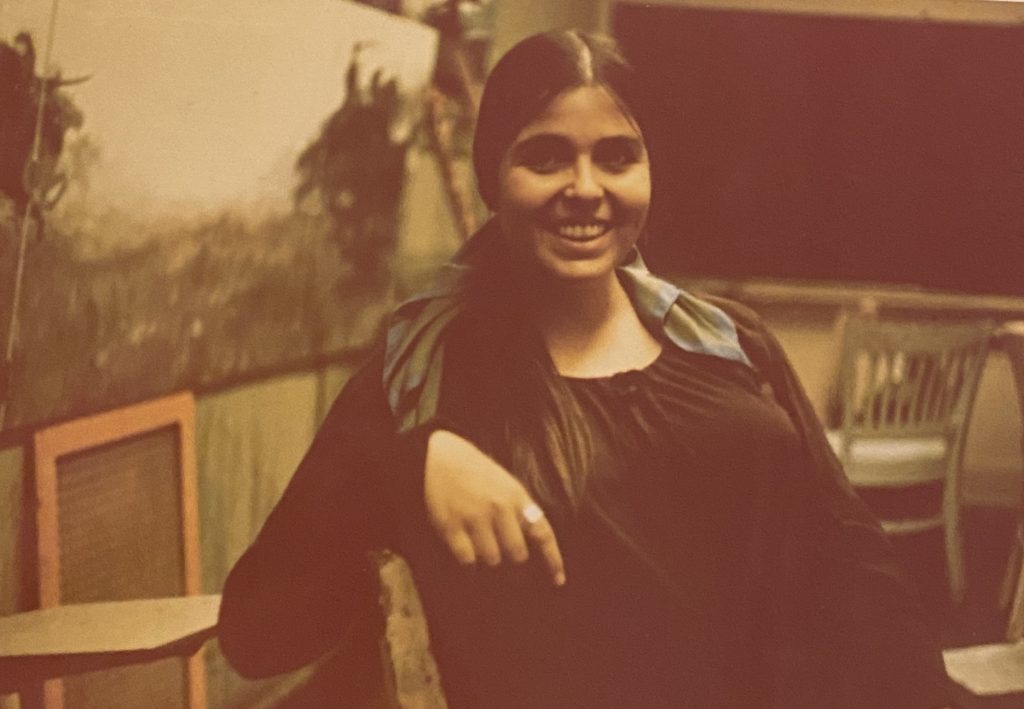
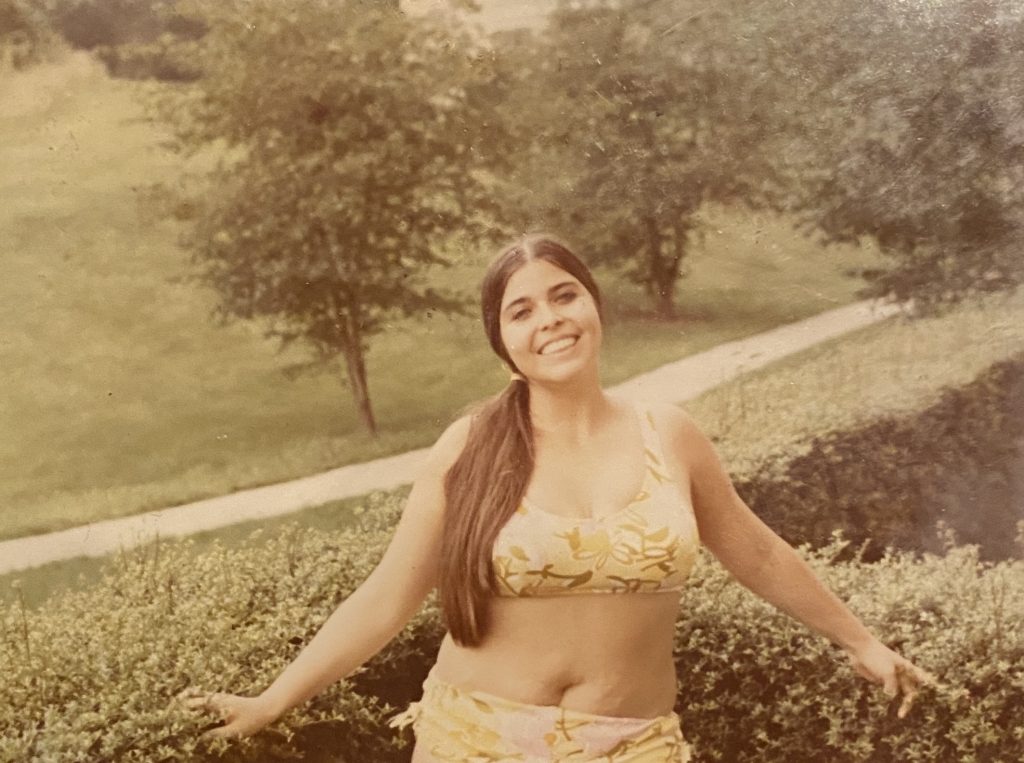
I’m grateful to have these images of Karen from around that era, too. Isn’t she absolutely gorgeous?
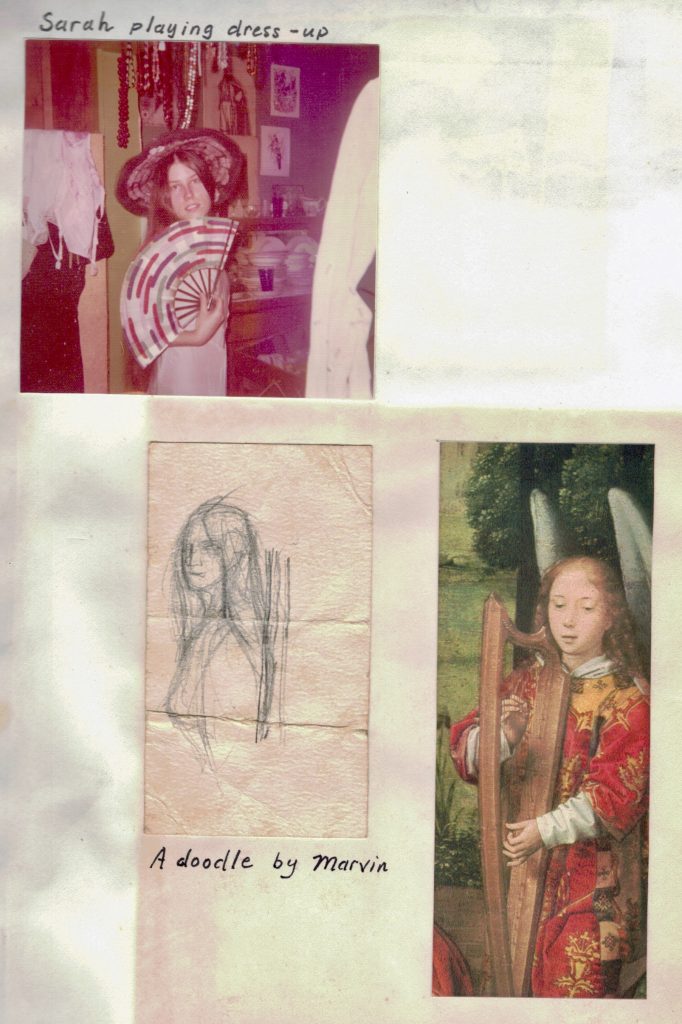
Another page from my mother’s scrapbook, with my godmother Sarah playing dress up at The Wizard’s Jar, and a doodle from Marvin, who would later become Karen’s first husband. How did my mom end up with this scrap of paper, and why did she decide to save it like this? I imagine maybe Marvin was visiting Karen at the Craft Center, and sketched her. My mom was a magpie collager — collecting friends and images she found intriguing and beautiful. I think it’s a pretty incredible synchronicity that this snippet ended up glued into her book.
A few months later, Karen married Marvin. She invited Maggie (and her new fella Dave), and asked if they would come play some music for the wedding. The celebration was out by the lake at their house, but my folks arrived late — after everyone was filing out, post ceremony. Maggie takes Dave in to meet Karen, and as their eyes met for the first time, something unusual occurred… It had never happened to either of them before (or since) — but my dad describes it as a bolt of energy that passed between their gaze. Both their eyes got really big, and it felt like a jolt of electricity – a kind of recognition. Neither of them said anything about it to anyone at the time, it being, of course pretty awkward timing to experience such a thing! It was Karen’s wedding day, and Maggie and Dave (though not married yet), were in a serious relationship. Karen says now that she knew already that her marriage was doomed, and that she was marrying the wrong person for her — and their union was very much a tumultuous one. But if they hadn’t gotten together, my stepbrother Ian wouldn’t exist, or his daughter, my niece Connie.
Many years later, after my mom had died, and Karen and Marvin had divorced, my dad and I were living in Austin again. This one morning, Karen and Marvin’s son Ian (who would later become my stepbrother), burst into Karen’s bedroom, wearing a bright red shirt and sweatpants and shouting that a cardinal was flinging itself against the window in the living room. Incidentally, after my mother’s death, I always associated sightings of cardinals with her spirit, visiting me.
If Ian hadn’t woken her up yelling about the cardinal (while dressed like a rowdy cardinal!), she would have slept in — but since she was up, she remembered that she was supposed to call in to KUT (a local radio station) to ask John Aielli (a famed radio host and Austin cult figure) to make an announcement for the Native American Student Coalition event that was happening in a month. Karen was the contact and point person, so her number was announced for anyone to call, wanting more information.
Meanwhile, my dad was driving to work with the radio on, (tuned in to KUT, of course) and heard the announcement where they mentioned Karen’s name. They had run into one another several months before, but he hadn’t gotten her contact information. This was long before the internet and social media made it easy to track someone down and reach out, and not everyone wanted to be listed in the phone book. Dad managed to memorize her number and called later to invite her to a special event.
My father has always been a spiritual seeker, but he was baptized in the Episcopalian faith when he was with my mother. That path brought him a lot of comfort (and still does), but for a time, he was trying to discern at that time whether he had a calling to become an Episcopal priest. Dad wrote a liturgy to request divine guidance to help him know his true path, and he shared it at the church we went to at the time, St. Michael’s. For some reason, he decided that he wanted her to be there, and to support him in prayer.
Laughing now, all these decades later, he tells me, “Well, obviously, the guidance was: NO! Not a good idea!”. Instead, he ended up marrying Karen, at that very church (though their first wedding ceremony was on the sacred grounds in Brackettville, in a traditional Native American Medicine Wheel ceremony).
So to sum up (because I realize this might be kind of a confusing story!): if the cardinal hadn’t been knocking, Ian wouldn’t have woken Karen up, she would have overslept, and wouldn’t have remembered to make the radio announcement in time, and my Dad wouldn’t have gotten her number, memorized it, and wouldn’t have invited her to what was really quite an intense first date. After that event, Karen started journaling after they reconnected, and wrote, “This is the man I’m going to marry”. And so she did.
A while after they started dating, my dad brought up their first meeting, and told Karen what he’d experienced when their eyes met — and she said, “I know. I felt it too.”
When I asked Dad if he thought it they had know one another before in past lives, he said, “It’s just as likely than any other explanation, and probably more likely than most!”
————
Our blended family was one marked by trauma and grief, from the beginning. My dad was a widower, raising a little girl on his own. He dated a bit before finally reconnecting with Karen, but nothing really clicked. Not long after they married, Marvin, Karen’s first husband and Ian’s father, killed himself. I remember hearing Karen wailing with sorrow, from behind my parents’ closed door. Suddenly we had a household with two shattered pre-teens who only wanted the parent they’d lost to come back, and for everything that they had once known to go back to normal. But our new normal was a huge struggle, and one that Ian and I were in deep resistance to. Neither of us really wanted they new family structure that had been thrust upon us — but our parents really loved one another, immensely. So, despite the emotional dysfunction, massive tragedy — and a fairly incompetent family therapist (who often just made matters worse), there was a big love glueing all our broken pieces together.
For years, I stubbornly resented my dad for choosing his own happiness and destiny over my comfort. There are a lot of things that could have gone differently in how our families came together, and though a lot of that really fucked me up — I also know that my parents were absolutely doing the very best they could, with the tools they had. I’ve grown a lot, healed a lot, and forgiven a lot. At a certain point, you just have to let that shit go — or it will eat you alive.
Forgiving myself is harder. I was just a little kid, but my god — I was SO hurt and angry, for so long. All Karen wanted to do was cover me with her love, but I was a prickly little pain-beast, unused to being loved on by a mother-figure (my mom was not really the super affectionate, demonstrative, touchy-feely kind), and so I rejected and pushed her away, again and again.
It took a long time before I was able to heal enough to work on repairing our relationship. And now it all feels like it’s too late — to have the kind of time with her that I wish I could get back. I’m losing my mother all over again, and I can’t stop crying — thinking about how she’s truly the mortar that holds us all together. I’m afraid our fractured, wounded little family will implode and disintegrate without her here to hold us together.
All I want is to treasure every moment I still have with her — knowing she could slip away at any moment. There are still so many questions I want to ask, stories I want to hear. Things I wish we could go do together. And all I can really do is try to be present, love on her and give her all the kisses and hugs now that I wish I’d let myself melt into more when I was little, especially back when I needed them most…
My dad and I were messaging on my mom’s death day, and I was asking him questions about the details of this story, and about fate, or destiny — which he says he believes in more and more, the older he gets. He also shared this wisdom, which I’m trying to take to heart:
“Is regret a useful emotion? But really, could we have acted differently than the way we did in a given situation? After all, we are who we are. The Cosmos is unfolding as it is and not otherwise and we are part of that unfolding. A parent gives a child a choice rather than impose a decision, but the choice is always constructed in such a way that the outcome is inevitable.”
And when I asked him if he had regrets, he said:
“Yes. A million things really, to change in hindsight — but it is all a fantasy. What we have done is what we felt we had to do.”
It’s somewhat ironic that even though I make my living as a tarot reader, who people seek out specifically to inquire about finding their “person”, I have no idea how all that really works. Some days, I think it must be truly rare, to find the person meant for you, who truly compliments you, and with whom you can create a harmonious life. Or, maybe you found that person, but then they get sick and die — or the connection sours. People change, grow apart. Every day, I’m getting older — and I hope, in some ways, wiser. But I don’t feel any closer to finding the person I’m “meant” to be with. All I can hope is that the blessing of my ancestors’ love will guide us towards one another — because I sure would love to meet them, one day.
I’m grateful to have been able to witness these two unions — of the people who created me, raised me, cared for me… All of whom were lucky enough to be at the right places, at the right times, and knew to act on their instincts, and desires. Or were patient enough to wait for one another, when the lives they built with their first partners crumbled. I do think all my parents (my dad, and my mom, and my stepmom) were in some ways divinely appointed to be with one another. And I believe that my dad and Karen found in one another each other’s bashert (or soulmate, in Yiddish). I kind of stopped believing in soul-mates for awhile, but after really sitting with these stories, I think I can’t NOT believe in them.
It’s so complicated though, in these modern times — where we have a myriad of technological ways to connect, and yet, seem more disconnected from one another (in some ways) than ever. How do people even meet and fall in love now? If you’re not on the apps, you just have to wait and hope you run into one another — maybe at the vintage shop your girlfriend dragged you into, or while you’re in the middle of getting married to someone else, or because you happened to live in a small enough town, where everyone knew one another. My aunt Ruth (my mom’s sister) met my uncle Jimbo because of my dad — because my dad was giving Jimbo banjo lessons, which Ruthie happened to be over visiting my mom. Perhaps divine interventions were simpler in the 1970s, when everyone was just more tuned in and available — hanging out playing music all the time, or smoking weed at each other’s houses.
I think the main thing is that you have to be open to it — to the risk of heartbreak and ruination that falling in love with another human might bring you. You can’t protect yourself from it, and get to experience that intimacy and sweetness at the same time. And you must be bold — ask for that phone number (or memorize it off the radio), and take a leap.
You’ve got to trust that you’ll be guided to the right places, at the right times — but in order to do that, you actually have to leave your house and go out and be around people sometimes. You’ve got to put yourself in The Wizard’s Jar — which is not just a long-gone funky shop in an old house, but a container for possibility, filled with a potion made of hopes and dreams and longing, and stirred up by the wizards (or is it the devil — always in charge of timing?). Maybe it’s our ancestors, our past life selves, our highest healing teams. Maybe it’s the spirit of my mother, in the form of a bright red cardinal, knocking at the window. I like to believe we each have a posse of protectors, guardian angels or whatever you want to call them — who are guiding us towards the people we’re meant to be, and those we’re meant to be with.
It’s said (in Irish proverbs) that those who sing, pray twice — so perhaps one way to entreat those beings to assist you on your path in to raise your voice in song, on a regular basis? It seemed to work for my parents (all three of them), anyway. I’ve tried most everything else — meditation, candle spells, dating apps, to no avail, so far. Maybe I just need to sing more, and my beloved, my bashert will hear me from far away, and come running. I pray my mother, and all my well and vibrant ancestors will help give us a little nudge in the right direction, towards each other.
The poet Maggie Smith said, “Why worry about being alone? Maybe love is making its way toward you right now, but from a great distance. You don’t know how quickly it’s moving, how circuitous the route might be. It could arrive next week or years from now. Be patient. Keep moving.”
and
“Know that the only way to avoid pain is to opt out—to refuse to invest in your work or your relationships, to avoid loving anything you could lose. When you show up, you show up for all of it—the joy and the pain. As you reach for one, you risk the other. But reach. Keep moving.”
And the poet Rainer Maria Rilke wrote:
“Believe in a love that is being stored up for you like an inheritance, and have faith that in this love there is a strength and a blessing so large that you can travel as far as you wish without having to step outside it.”
I hold these sentiments very dearly, as I stand as the precipice of another enormous loss. But I have to trust that love (romantic love, mother love, all the love) doesn’t end when the relationships and bodies hold them transforms. That it’s possible for all this love to expand, and radiate. That it’s vast enough to hold us always, to guide us, and to continue teaching us all the best ways to be human, on this earth.
That is my prayer, here, in Austin, Texas — at the end of this grief-filled August. I pray that my family will be held and supported as Karen makes her journey across the river, and that she will be rejoined with her loved ones who have passed on, and hopefully greeted also by Maggie, her old friend, with whom she shared a beloved.
I like to imagine my mothers, who will at some point be together once more — watching over my dad, our family, and me.
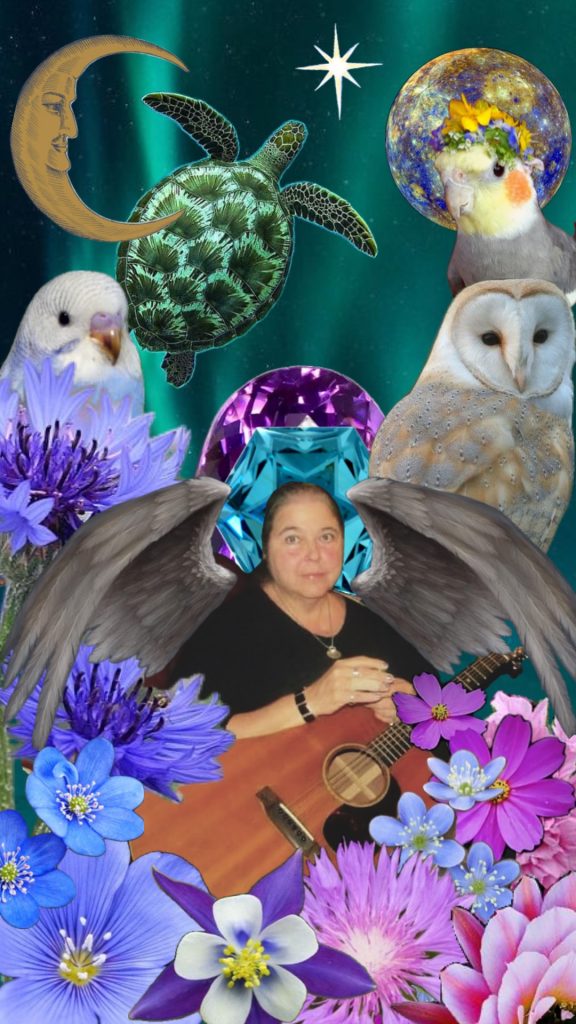

I inherited my love for collage making from my mama. I have been encouraged as an artist and writer constantly by my stepmomma. There are so many ways to create altars for honoring and remembrance, for grieving and healing — this writing, and these images are shrines of love.
For the woman who left this earth through the lion’s gate, and the one who waits on the shores for her boat to arrive.
Honey heart, hummingbird sweetness. Turtle woman, owl grandmother.
I surround them with flowers, with jewels, with nature’s mysteries — for spirit feeds on beauty.
If you’d like to read more about this journey
of grieving, honoring, and remembering
my mother on her death day,
here is an archive of my writings about her:
HAZY WINDOWS
THE AUGUST RITUAL
FALLING STARS + CACTUS FLOWERS
DOUBLE ETERNITY
MY ANGELIC INHERITANCE / THE HOLOGRAPHIC WILL
38 ON AUGUST THE 8TH
30 YEARS – SEIZURES
888 – HONEY BABE, I’M BOUND TO RIDE – DON’T YOU WANNA GO?
WILD BLUE YONDER
NO ROOM IN MY HEART FOR THE BLUES
FAMILY VACATION – HANK WILLIAMS’ GRAVE
STAR-CROSSED TROUBADOURS
Foxes in the Rain
Triumvirate Lemniscate
Gustav + Mama – August 8th
TWO DECADES OF MARDI GRAS MEMORIES
by angeliska on February 28, 2023
I’ve been partaking in Nick Jaina’s amazing Memoir Class (seriously go check it out if you’re ready to jumpstart your memoir writing, it’s been absolutely fantastic!) and I’ve been focusing on writing about my years in New Orleans before Hurricane Katrina blew me back west, and what I learned from living there. I’ve been contemplating especially how much I’ve grown as a costumer from my many years of making Mardi Gras magic.
As I prepared to finally return to Carnival after a long pandemic hiatus, I took a moment to organize the last 17 years of my Mardi Gras Day costumes (I’ve missed a total of three, out of the last 20 years) and to dream about what visions I want to call into being next!
I feel moved to share here a visual walk-through of what I’ve learned in the past two decades of costuming and reveling – and trust that I’ve been writing a LOT about all this, and will have much to share soon – so definitely stay in touch if you want to read more about this masque and mummery adventure I’ve been on for half my life now…
I moved to New Orleans in 1999, but because I was young and stupid, I often ended up working on Mardi Gras and somehow missed the memo for a few years that it would be my most favorite day! I was twenty years old, and more impressionable than I’d like to admit, so for a little while there, I got turned around into believing that Mardi Gras was too messy, too touristy, too crazy for me. What was I thinking!? Eventually I figured out how wrong I was, and from there – never looked back.
Costuming is not only an art – it’s a form of shamanic embodying, of the spirit or archetype you’re drawn to and desire to create and put on for one day, dancing it out into the streets, into the crowds, to be experienced, admired, glorified, and thoroughly CELEBRATED.
You have to play with it, experiment, do a lot of trial and error, make mistakes, and find your sweet spot! Everyone has their own approach and method to costuming, but for me – I consider a costume a success if it makes a big impact (and yes, I judge this by how many steps I can walk before someone flags me down wanting to photograph what I’ve created!), and if my fellow friends on psychedelics have their minds blown by the colors, details, and overall fabulosity of what I’ve put together.
It’s also got to be not only totally extravagant and elaborate, but simultaneously comfortable enough to walk and dance in, party vigorously, and use the bathroom in from early in the morning to late at night – without falling apart, becoming too cumbersome, or making me totally miserable.
I love challenging myself, and now I work on some of these for years, gathering ideas and materials long before the entire look comes into fruition. I plan, make sketches and lists, source trim and appliqués from distant lands, and plot my debut Mardi Gras morning.
It cracks me up sometimes to examine how seriously I take all this – to the point that I’ve long had Mardi Gras anxiety dreams, (where my costume isn’t ready, is extremely ugly, or full of rats, or too big to get out the door!) but I think this just shows my true commitment to sparkle motion!
You can see a clear progression in my journey to understanding all of this, which no one really taught me, but that I had to figure out for myself – and by observing and being wowed by the costumes of so many of the badass masquers I always look forward to seeing out on the streets each year.
I love the way we inspire and surprise each other, and always try to out-do whatever we pulled off last year, in one way or another. As the quality of the photos taken gets better and better with each year, so too do my costumes.
In continuing my costume retrospective, I’ve been learning so much about my own process by laying everything out year by year like this. It surprises me that I never thought to do so before, but twenty years feels like an appropriate time to reflect back, and see how far I’ve come as a costumer and carouser!

2003: Green Antoinette – I wore tattered green and black Victorian shredded finery and took my 89 year old Grampa out in his wheelchair for his first proper Mardi Gras, and in some ways, mine too.
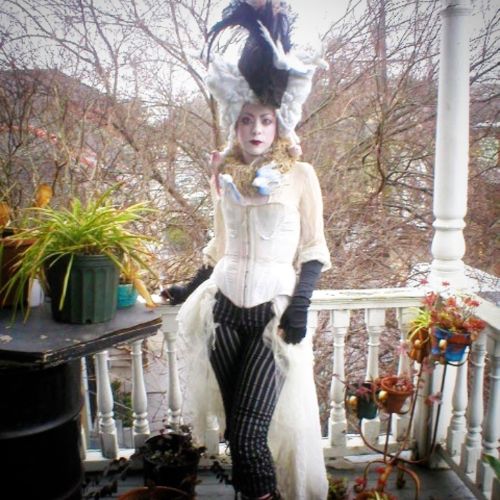
2004: Pirate Antoinette – Same wig (thank you Alisan – she got a lot of wear!) but I’m starting to get this idea a bit better now… That corset was so gorgeous, and I borrowed the bird’s nest neckpiece from Pandora.
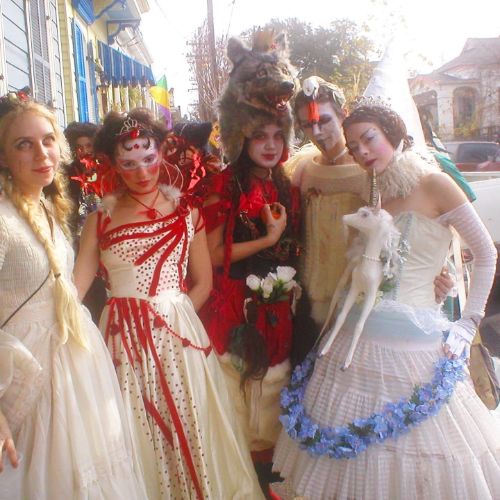
2005: Unicorn Princess — I’m full committed at this point, and living with Pandora was a big influence and delight, when it came to costuming and carousing! This was the first (but not the last) time I got into using taxidermy bases to attach animal bodies to my bodice.

2006: Phoenix – the first Mardi Gras after Katrina. A bit on the nose, and I was definitely falling apart by the end of the day, but what a joyous day!
2007: I couldn’t go this year because Helen’s murder had me gripped in really intense PTSD (plus everything from Katrina was really catching up to me, and I was not okay) I still regret not going, though. 💔
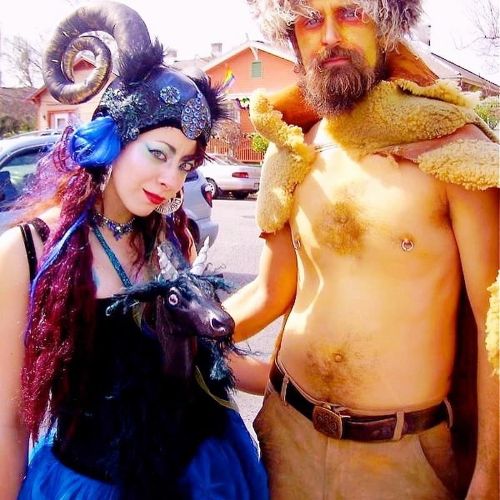
2008: Dark Capricorn – Honestly not my best work. I ran out of time and had too much fun partying! But I redeemed the Capricorn magic in 2020, so NO REGRETS!
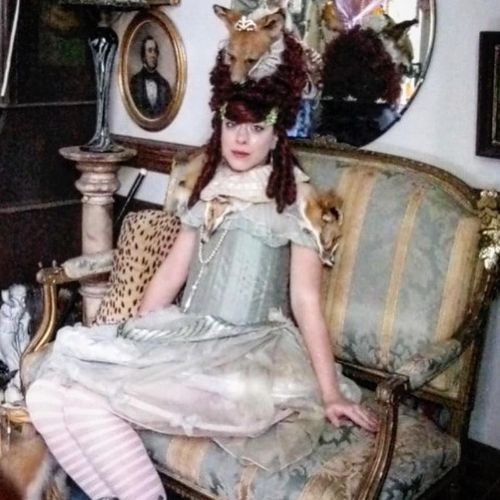
2009: Foxy Queen Elizabeth — This was such fun to make and wear! But why did I choose such subtle maquillage? I think I ran out of time, and sweated or cried most of my glitter off. Whatever, I had the skin for it back then!
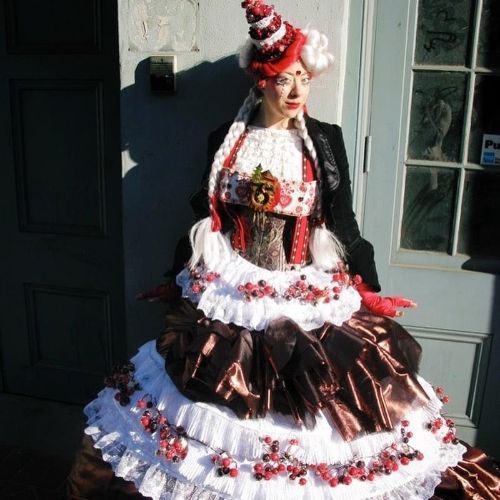
2010: Black Forest Cake – Here’s where I’m really hitting my stride! I LOVED wearing this costume, so so so much.
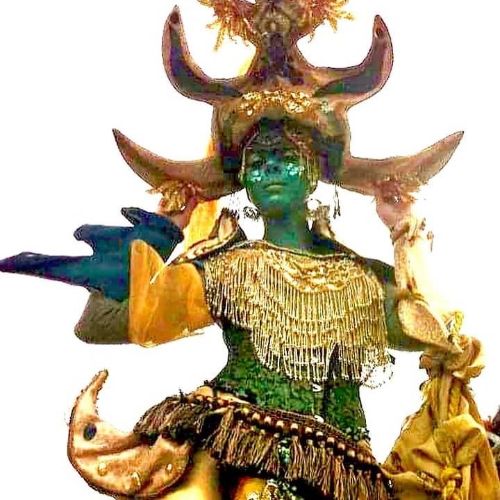
2011: Green Tara – Another joy to wear, though much of it was put together from vintage pieces someone made in the 60s or 70s. It was here that I realized how much I love being green.

2012: Peacock – I was very pleased with how this one turned out! All the peacock feathers came from the flock out at Lone Grove, and were gathered by my Aunt Ruth.
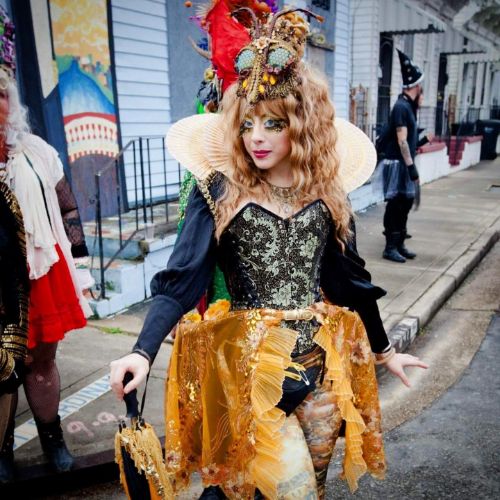
2013: Bee Queen – Though I was very proud of this costume, but I think I learned here that black is just… not a showstopping color for Mardi Gras! I wish I’d leaned harder into the honeycomb shades, and that my very detailed (and way too heavy) headpiece had been more visible! Buuuut I loved embodying the Bee Queen, even if I couldn’t bear to wear her into the night!

2014: Rainy Gras! This was the year of the absolute most miserable weather on a Mardi Gras I’ve ever experienced (as I wasn’t there for Freezy Covid Gras of 2021! I decided not to wear my Marine Antoinette costume because it wouldn’t be warm enough, and I didn’t want to waste it on a day when it might not be seen under a coat and umbrella, so I switched gears, pulled together a last minute LEWK I’ll call ummm…Copper Eyes! I had warm layers on, and borrowed some sparkly layers and Pandora’s red rainboots and was SET! It was kind of a Bummer Gras (for a lot of reasons), but I learned some really valuable lessons that day:
1. Costume commitment is important, but comfort is key, and you’ll have way more fun if you’re dressed for the situation. Be flexible, and prepared to change it up last minute, if you need to. There will be sunnier and warmer Mardi Gras days to wear your bikini thong thot flossy costume, I promise. You can still have a fabulous day, even if your look isn’t totally on point. And – NO ONE is looking at your shoes! Clip some bows on your rubber booties and be grateful for the gift of warm dry feets!
2. Choose your krewe wisely. I got ditched by the river for the last time that year, and found myself alone, in the Quarter, way too high in the freezing rain. Plus, I was clutching an order of cold-ass Bloody Marys for people who decided not to wait for me to return with them (or let me know where they went!) I experienced a simultaneous Mardi Gras meltdown and Mardi Gras miracle, as I spotted my beloved Jonno and company, and was blessedly invited to roll with that lovely krewe of sweeties, utterly saving my day, and cementing my eternal love for Jonno and his cohort of bearded babes. They were thrilled to share my Bloodys, and we had some marvelous and unexpected adventures that I never would have gotten to experience had that not occurred, so – it was actually a blessing!
P.S. When I say krewe here, I don’t mean it in the formal sense of organized MG krewe, but just the peeps you roll deep with throughout Carnival. Lowercase krewe for me indicates the folks who will wait up for you when you need to go slow, make sure you don’t get lost, safety pin you back together when you’re falling apart, wait with you in the bathroom line, help you out when you are too altered to function, and generally just have your back throughout the chaos and magic of the best (and most intense) day of the year! If you find them, show up for them in the same way, because that kind of love and loyalty is GOLD!
3. Southern Hospitality is a REAL THING, and oh my lord, it is something to be treasured. Before that dismal, miserable freezing weather Carnival, I’d always eschewed going in people’s houses during the day of Fat Tuesday, except for a quick pee or a waterbottle refill or something. I always wanted to be outside on the street, where all the action was!
But holy moly, what a blessing it is for the people that choose to host others in their gracious homes on that day – often allowing heavily costumed strangers into their parlors and onto their balconies to rest their hooves, graze their snack tables, drink their booze, and maneuver their complicated selves onto their toilets. The trust involved is remarkable. There’s an unspoken pact of respect that locals really understand, and it’s very, very special to witness.
I’ve gotten to hang out in some of the most exquisite mansions in the French Quarter, filled with fascinating artwork and wonderfully interesting people. It’s so humbling to be the recipient of such kind largesse, and it’s a dream of mine to one day have a home in New Orleans again (when I am ancient and somehow extravagantly wealthy) where I could return the favor.
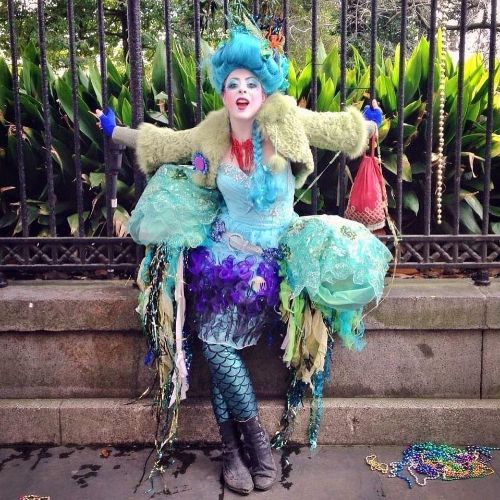
2015: Marine Antoinette – A triumph! This costume survived the massive fire at the Mudlark Public Theater and lived to be worn with great delight the Mardi Gras after! It was wonderful to have a mostly finished costume for once, too – so I could enjoy myself with less stress of being up hot glue-ing into the wee hours on Lundi Gras! The jellyfish panniers were especially fun to wear, and my wig is a custom glory from Coco Coquette.
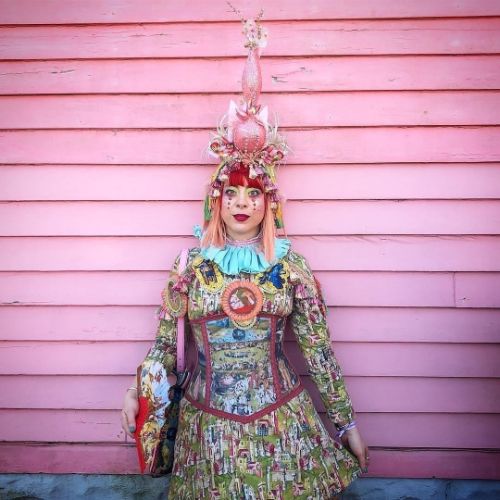
2016: Hieronymous Bosch’s Garden of Earthly Delights – I was particularly proud of this one, especially the headdress (which has lots of little surreal details, and is a replica of the pink tower in the center panel of the painting. I did have a minor Mardi Gras meltdown Lundi Gras night because I felt lumpy and dowdy when I tried everything on, but I made a last minute wig shift, and somehow that completely changed everything!
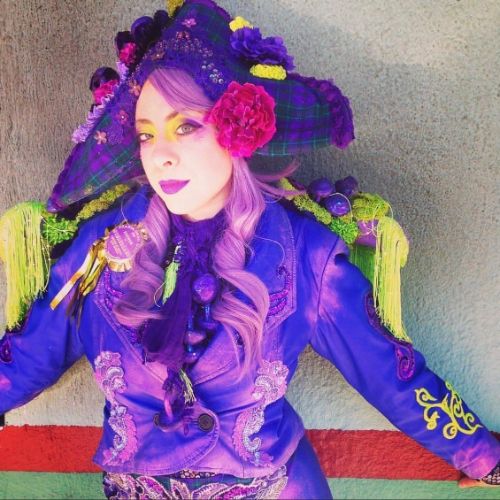
2017: Amethyst Deceiver: The Amethyst Deceiver is a bright purple mushroom, and my inspiration for this costume was fungus, spies/double agents, and kind of a mycological revolutionary/military theme… I think it was a bit too conceptual, with a lot of fiddly details that were falling apart (hot glue doesn’t really work when sticking appliques to smooth leather, FYI), but it was fun to prance around in, even if my look might’ve translated to…the Purple Pie Man villain from Strawberry Shortcake!
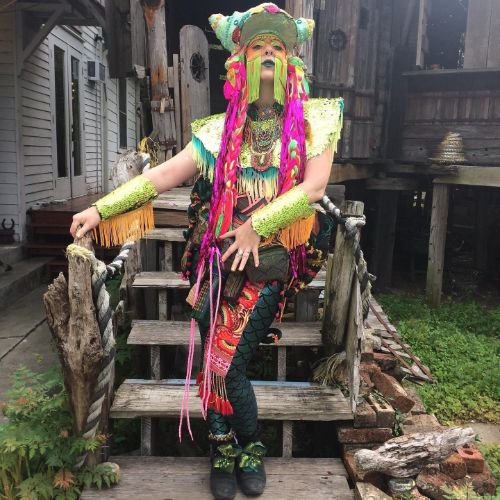
2018: Karma Chameleon: This year we did a Shamanic Neon Animals theme, and had a Wild Hare, a Lion, a Spider Queen, an Owl, and a clown! I’d had a vision of being covered in chameleons, and becoming one with them – so this was an expression of that experience! Again, I’m not totally sure that my concept translated, but I had a blast wearing it!

2019: CHAKRA KHAN: Solar Plexus / Yellow – this was a major group costume where we all dressed as the colors of the rainbow / chakras! I was the Maṇipūra मणिपूर chakra, and I loooooved embodying this energy and color! We had gone to India that January for my 40th birthday and found lots of intricate trims and bits for our costumes. It was pretty amazing to be part of this rainbow krewe, and everyone looked stunning on their own as well.
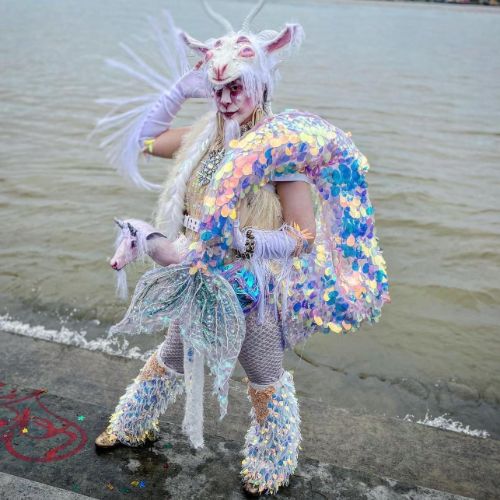
2020: Holographic Horoscope: Capricorn – We were iridescent embodiments of our zodiac signs! This was an opportunity to redeem myself after my Capricorn costume fail of 2008, and it felt like another triumph! I was an albino Capricorn with double horns and double eyes! I loved making this – especially my goat headdress, and mermaid tail (an aspect I ran out of time to make the first time around!) My scaly leggy warmers did start to fall down right after we left the house that morning, but some careful safety pinning kept them up the rest of the day (though the bottoms of them were soooo gross after wading through Mardi sludge all day, but that’s kind of impossible to avoid!) This was the last Mardi Gras we got to have before Covid hit (I got super sick by that Thursday, and was ill for 3 months!), so I’m grateful that we really got to live it up, and have such a luminous, perfect day.
2021 & 2022 had to be missed out on due to Covid, the big freeze here in Austin, grief and emotional/financial poverty 💔, but Mardi Gras 2023 was incredible and our theme was FANTASTICAL BOTANICAL – Medicinal Plantasy on Parade! I embodied HUACHUMA / San Pedro Cactus, which was a very spiky social distancing costume, and I hope to share those images here soon. I’ve also got visions brewing for 2024, but I’ll keep mum on that for the moment…
Also included are a few choice costumes from Eris Parades of yore, including the Feast of Appetites where we had cupcake shaped umbrella lanterns, and I was covered in fake candy, a glowy-bug witch moment, and a Sea Priestess lewk:
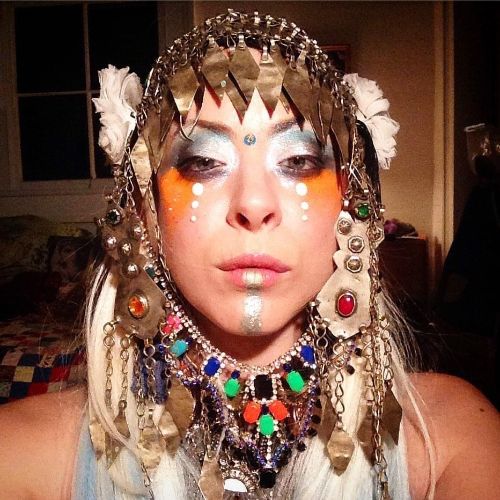

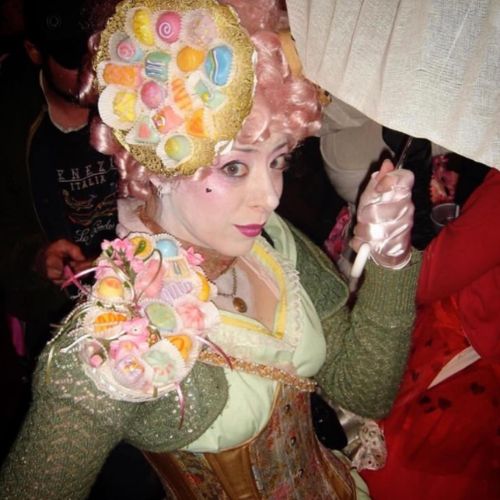
I hope these images and stories will inspire and delight you – and fuel your glue-gun fantasies for your own future costuming! Laissez les bons temps rouler!
GRIEF RITUAL
by angeliska on November 27, 2022
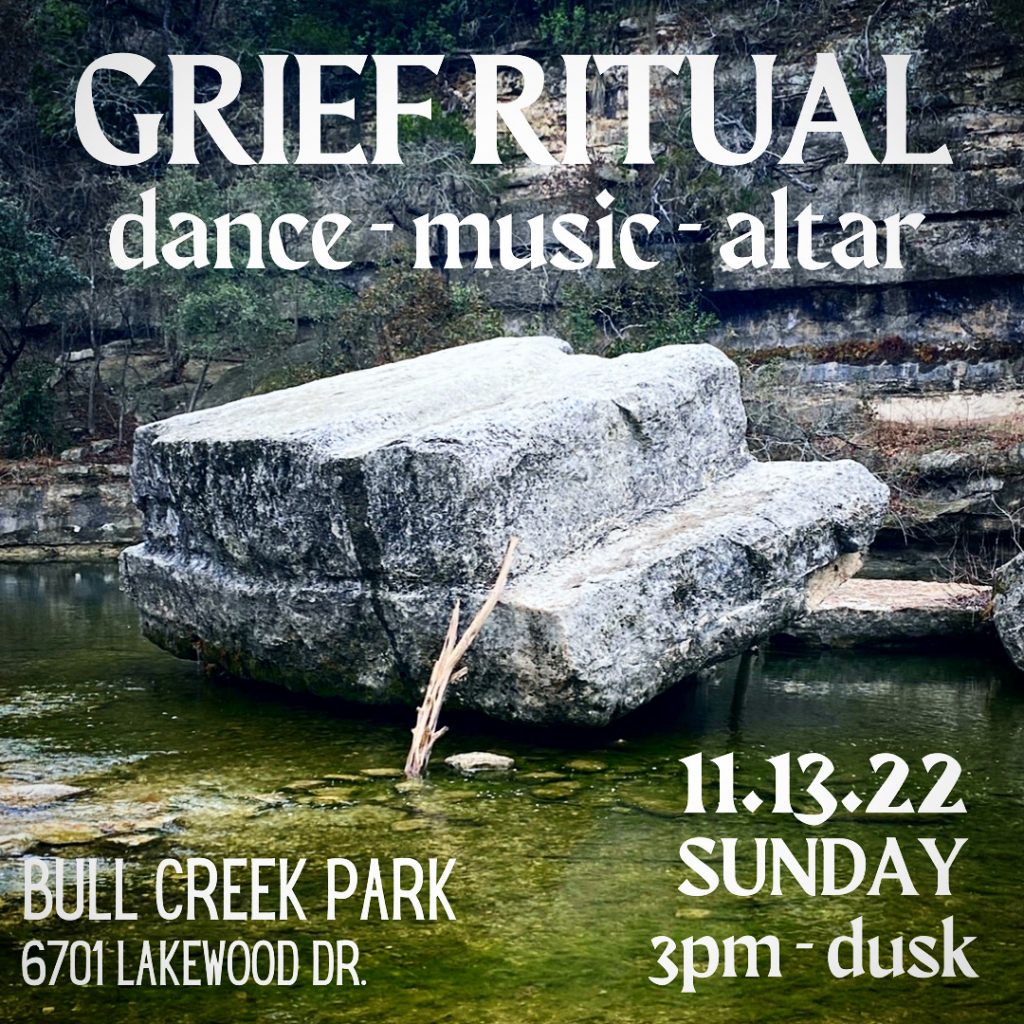
A COLLECTIVE GRIEF RITUAL
music – dance – altar
11.13.22
at BULL CREEK PARK
6701 Lakewood Dr.
ATX 78731
free / donations for the artists welcomed
featuring dance by:
Kelly Goetz
Jonathan Hiebert
Debra McAdoo
Amy Morrow
Ellen Stader
Caroline Wright
& music from:
David Quick
Biomusic by Plantonics
Wire sculptures by
Denver
conceived of and curated by
Angeliska Polacheck
This was a co-created, site-specific collective grief ritual featuring live improvisational music and dance, moving in harmony with the landscape of Bull Creek Park and the spirits who inhabit that land.
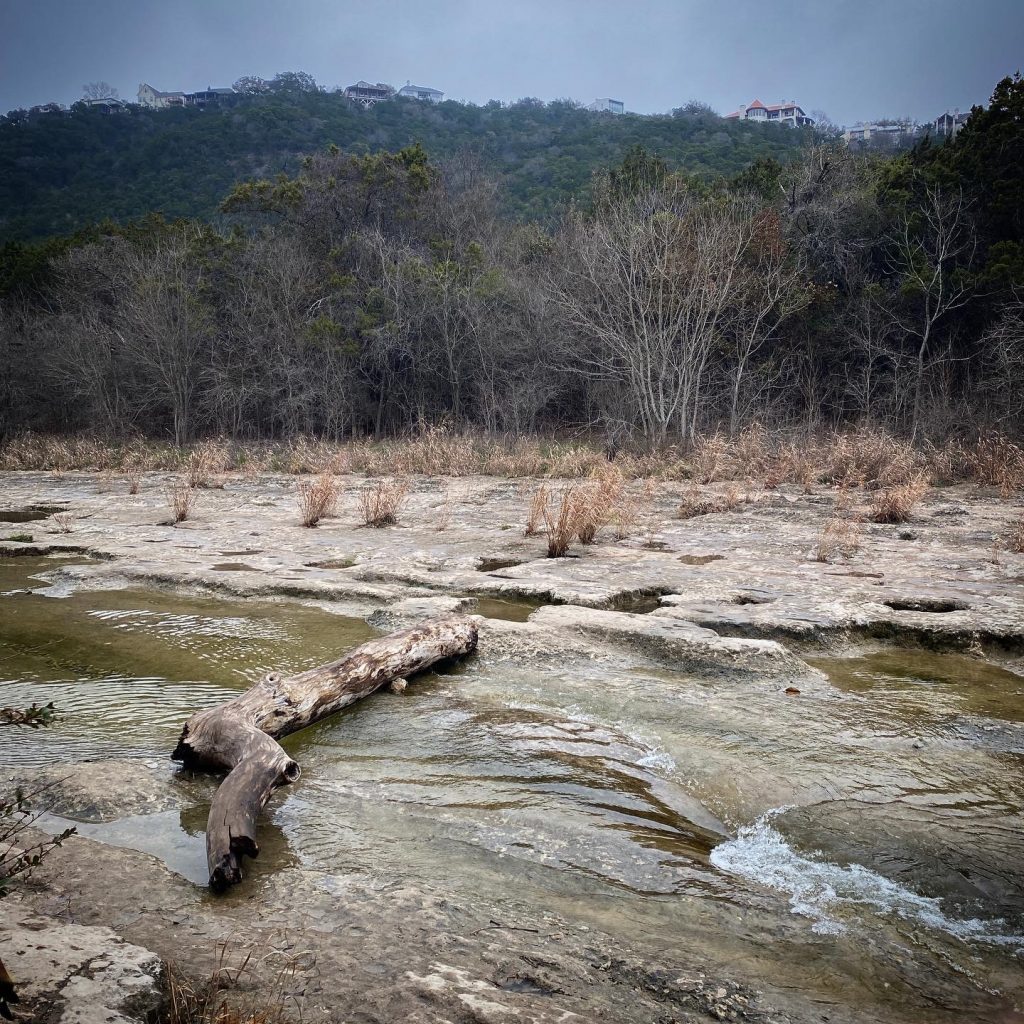
As a society, we have become bereft of collective spaces to mourn. Grieving usually happens only in private, and we have developed so much shame around the heavy feelings deep loss can bring.
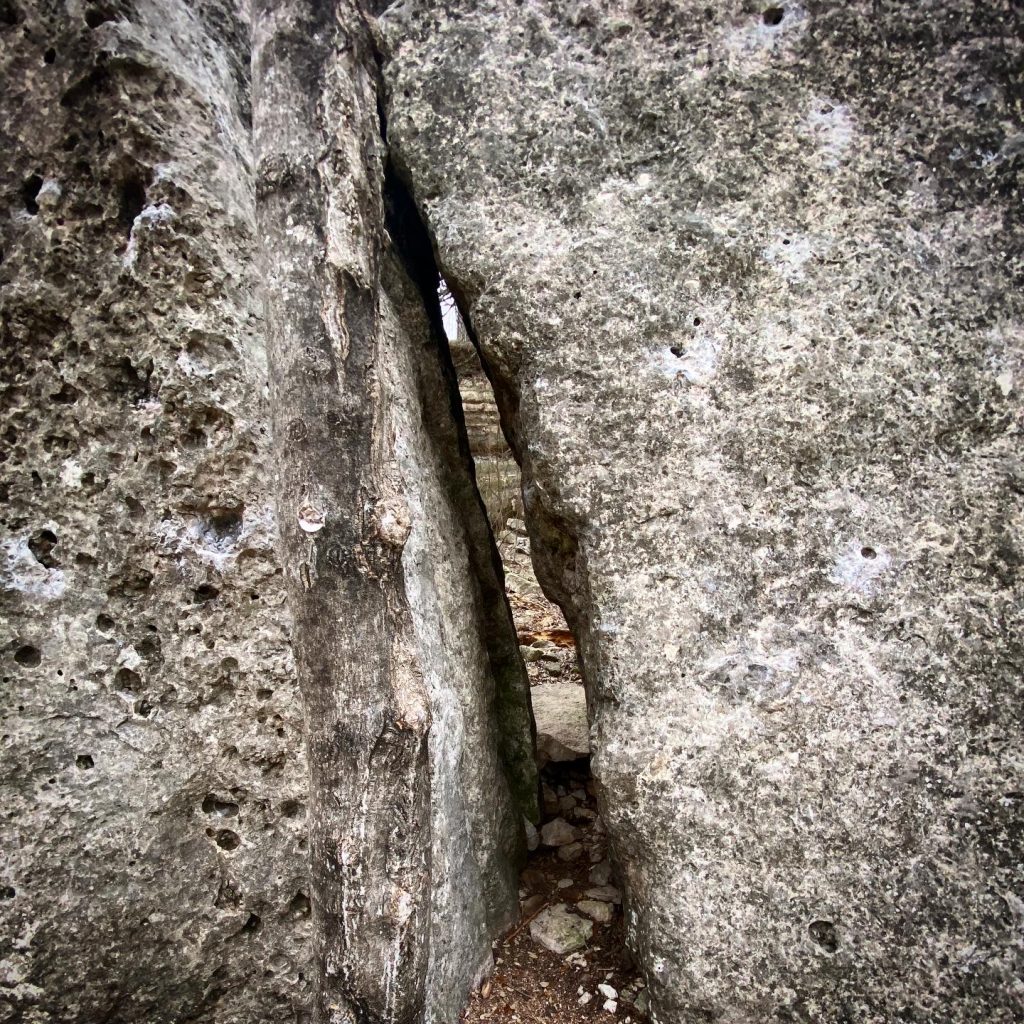
This ritual of art, music, and dance was a way to crack open our hearts, and feel all the things that are too weighty to carry on our own.
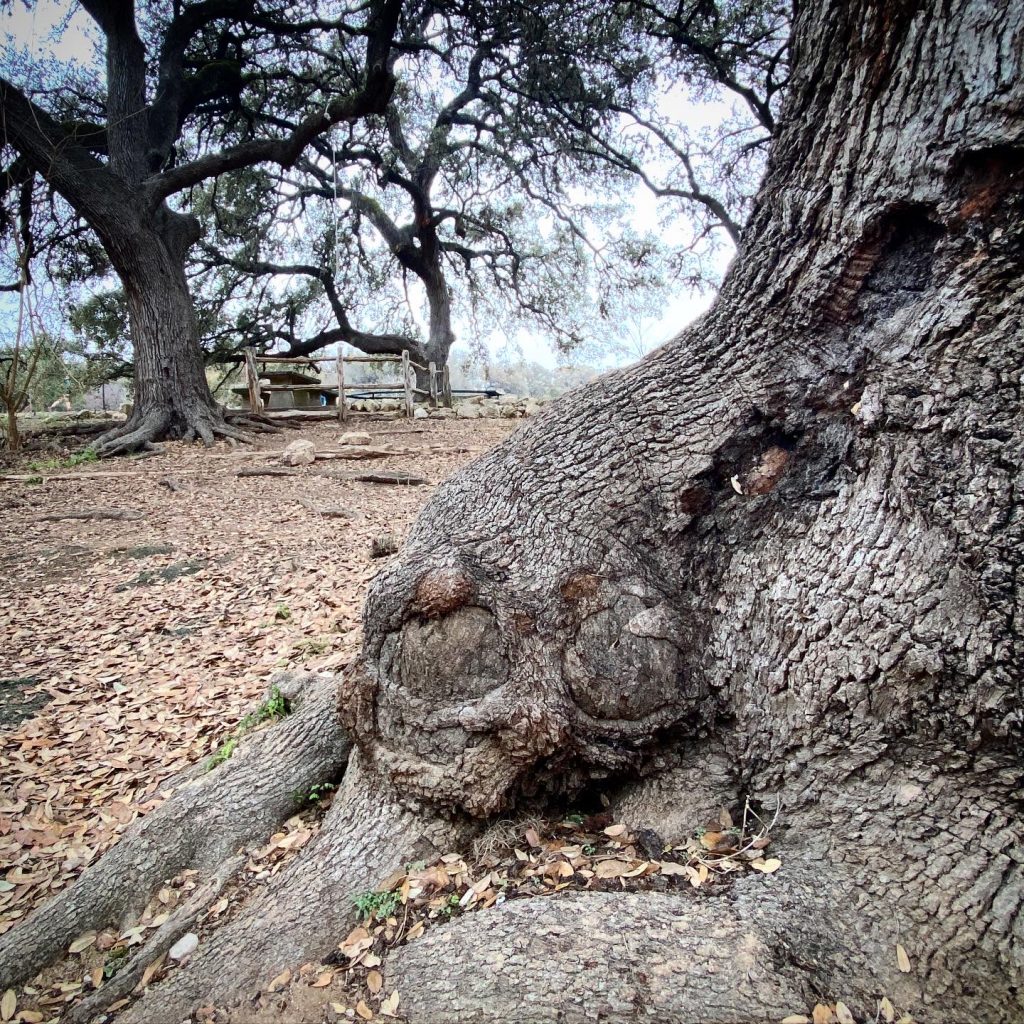
We have all been through so much since spring of 2020: millions dead to Covid, and millions more disabled by Long Covid. We’ve witnessed (and participated in) civil unrest and anti-racist uprisings, speaking out for collective liberation and dignity.
Our entire government and the notion of democracy has been under attack by deluded fascists who staged a violent attempted coup. Reproductive freedom and rights are once again restricted, as the bodies of women and uterus-having folks are controlled and dehumanized by right-wing politicians.

In February of 2021 here in Texas, we lost human, animal, and plant lives to a devastating freeze – and experienced unnecessary suffering and fear due to the greed-driven neglect and mismanagement of our power grid. Massive forest fires have raged and hurricanes ravaged other states, reminding us of the constant terror and sorrow of climate collapse.
And nowhere is all of this truly held and acknowledged. We are expected to carry on and keep calm – go to work and continue to shop and do our chores and participate in late-stage capitalism as if we’re not living through the chaos and upheaval of a mass death event and multiple other apocalyptic scenarios.
The most vulnerable people in our communities were hit the hardest by the effects of these simultaneous tragedies – most especially our unhoused neighbors, Indigenous, Black and Latine people, our precious elders, the chronically ill, medically vulnerable, and physically and intellectually disabled people. So many were considered disposable, and allowed to perish under terrible circumstances. We honor their memories, so that they might not be forgotten.
Many of us went through complex losses that got lost under the weight of greater tragedies – businesses folded, opportunities and dreams were dashed, relationships and friendships fell apart, friends, family members, colleagues and pets died. This is space to bring and hold anything and anyone you are grieving – and to know that you don’t have to do it all alone.
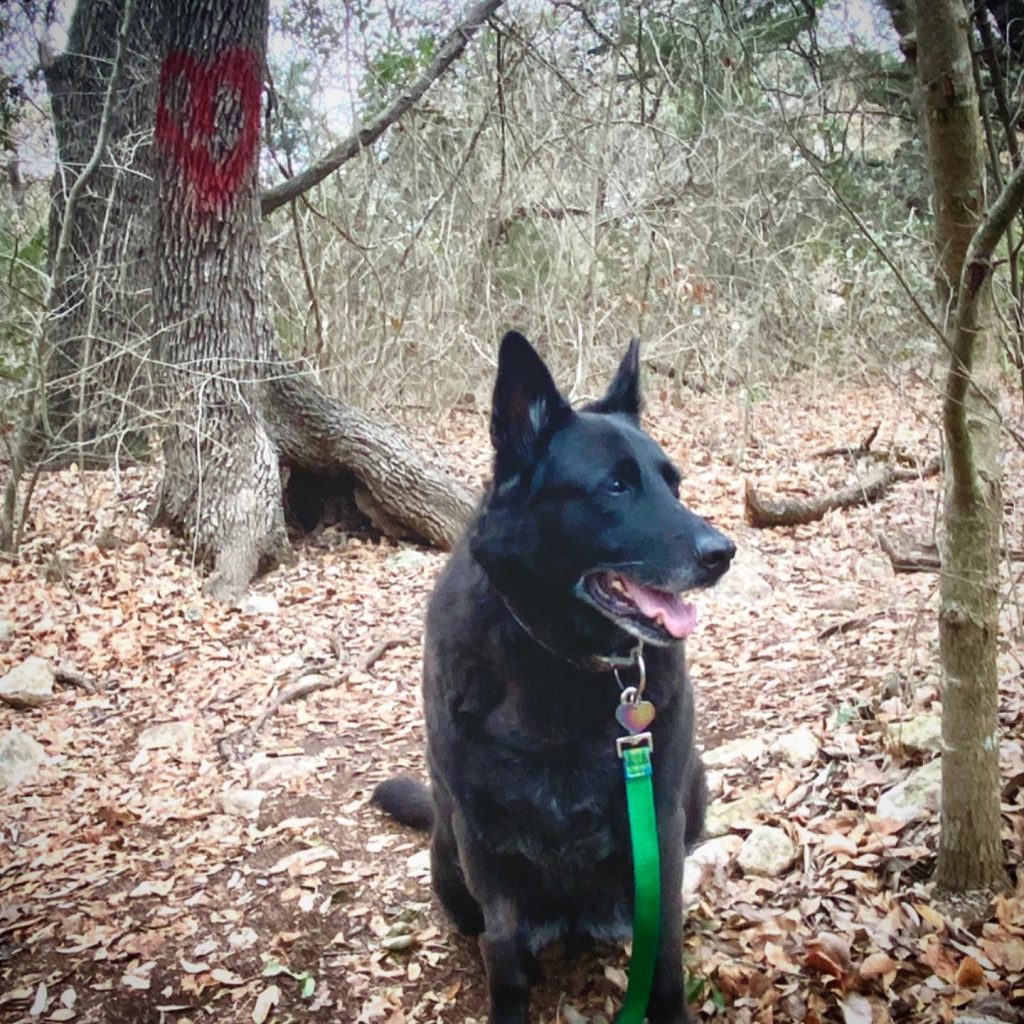
I conceived of this project in spring of 2021, after the ravages of Winter Storm Uri. My beloved dog Grrizelda had been diagnosed with an aggressive form of cancer, and I was taking her to receive chemotherapy at vet’s office off 2222, near Bull Creek. We would get barbecue afterwards, and sit at the park, watching the water and eating brisket. The prickly pears were frozen and melted looking, and the desolate landscape spoke to the raw grief I was feeling, knowing that my best girl’s time on this earth was growing shorter.
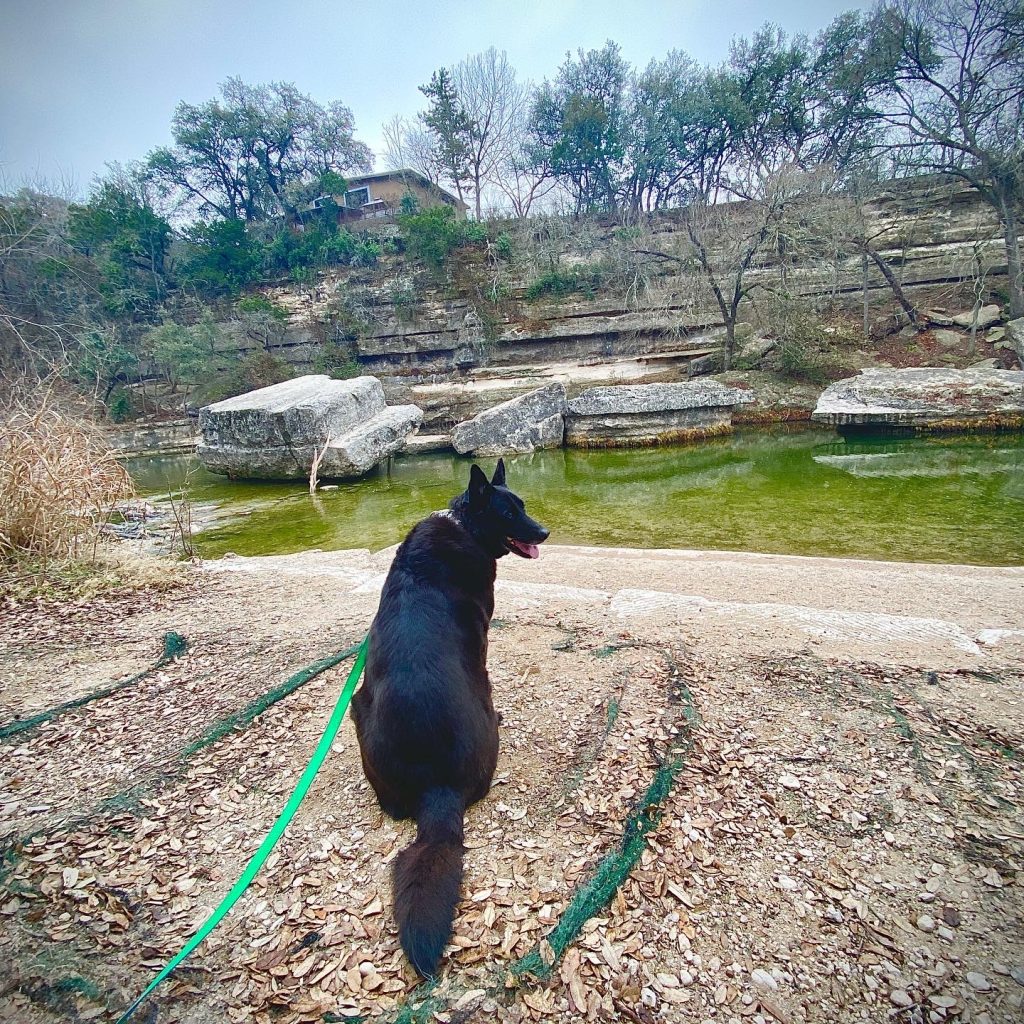
I had a vision of dancers moving in the water, and a collective altar around the big oak tree there. Dance always cracks my heart open, and allows me to cry. Altars are a way of honoring and witnessing all those who we are mourning. This ritual is the fruition of that vision – a seed planted, and hopefully the beginning of a way of gathering and grieving together that we can nurture to grow and continue, in the years to come.
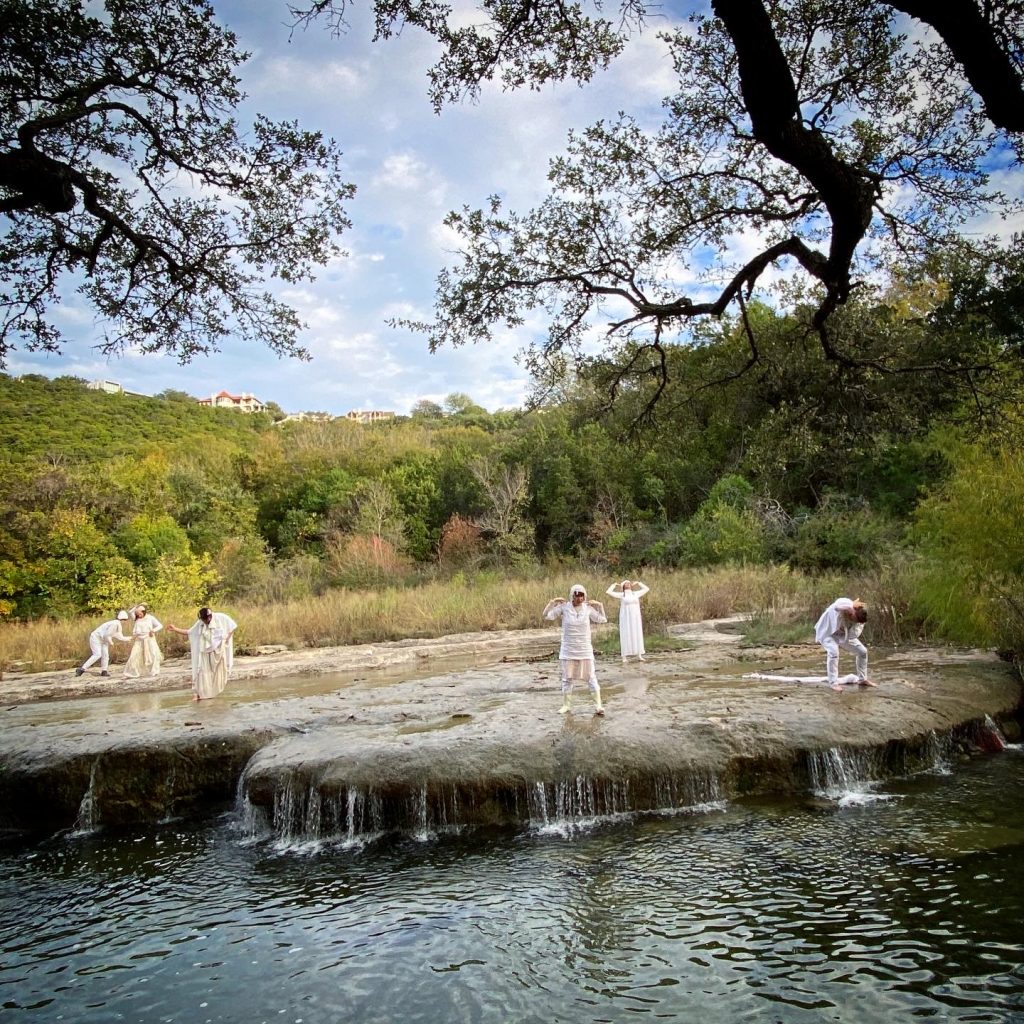
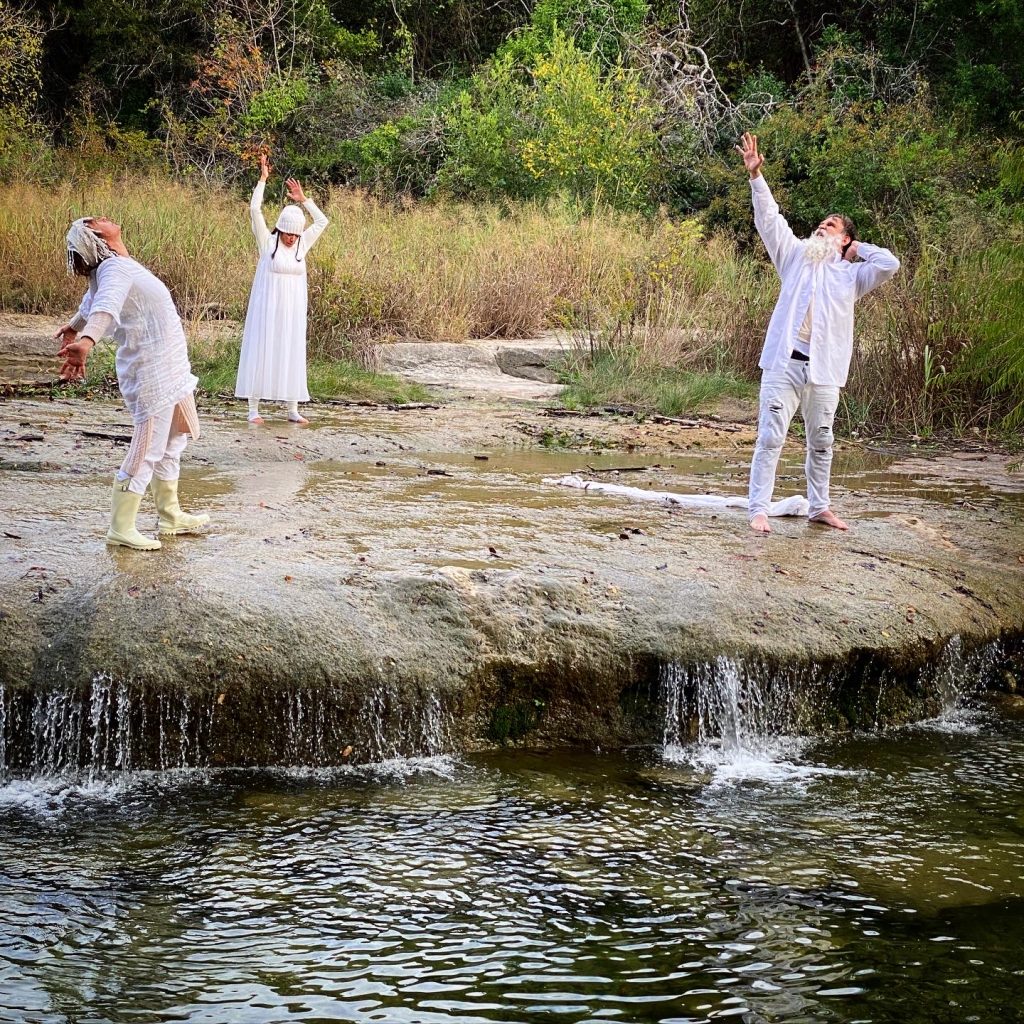

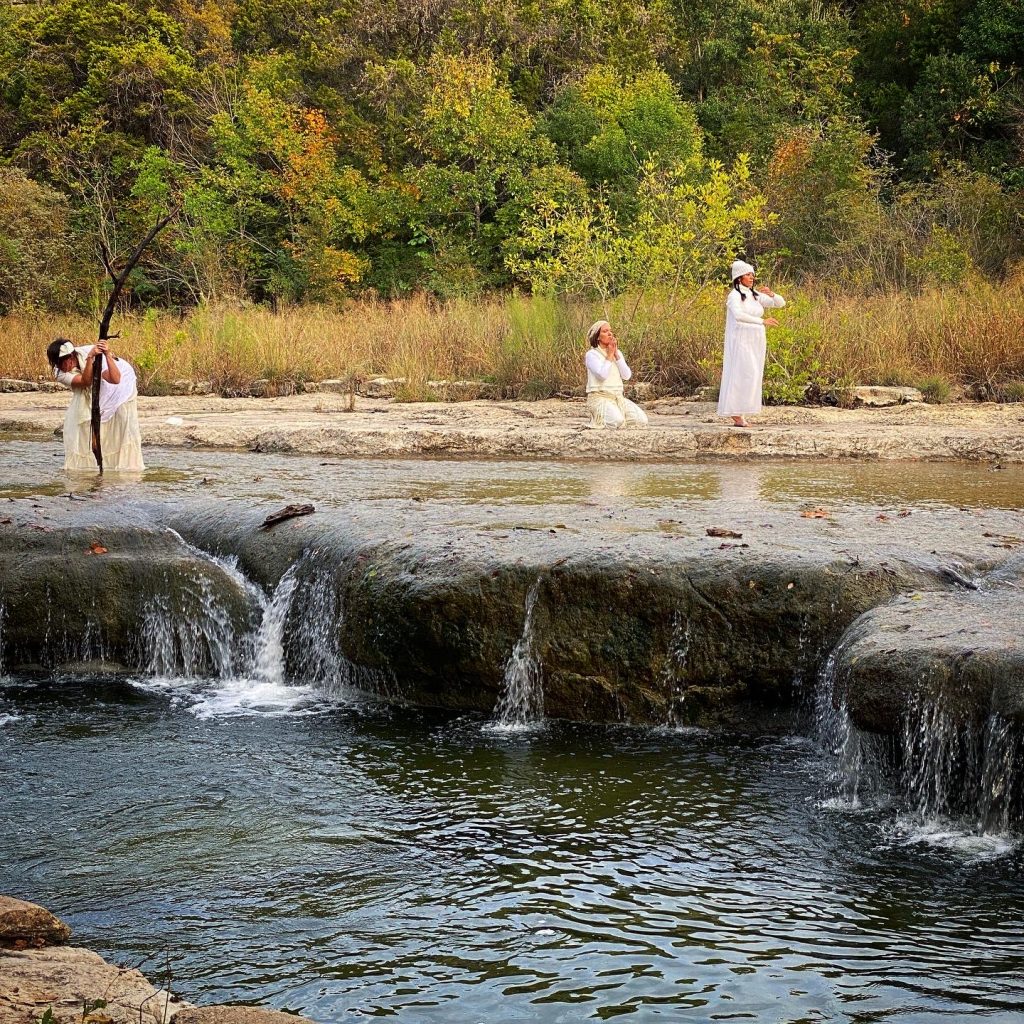
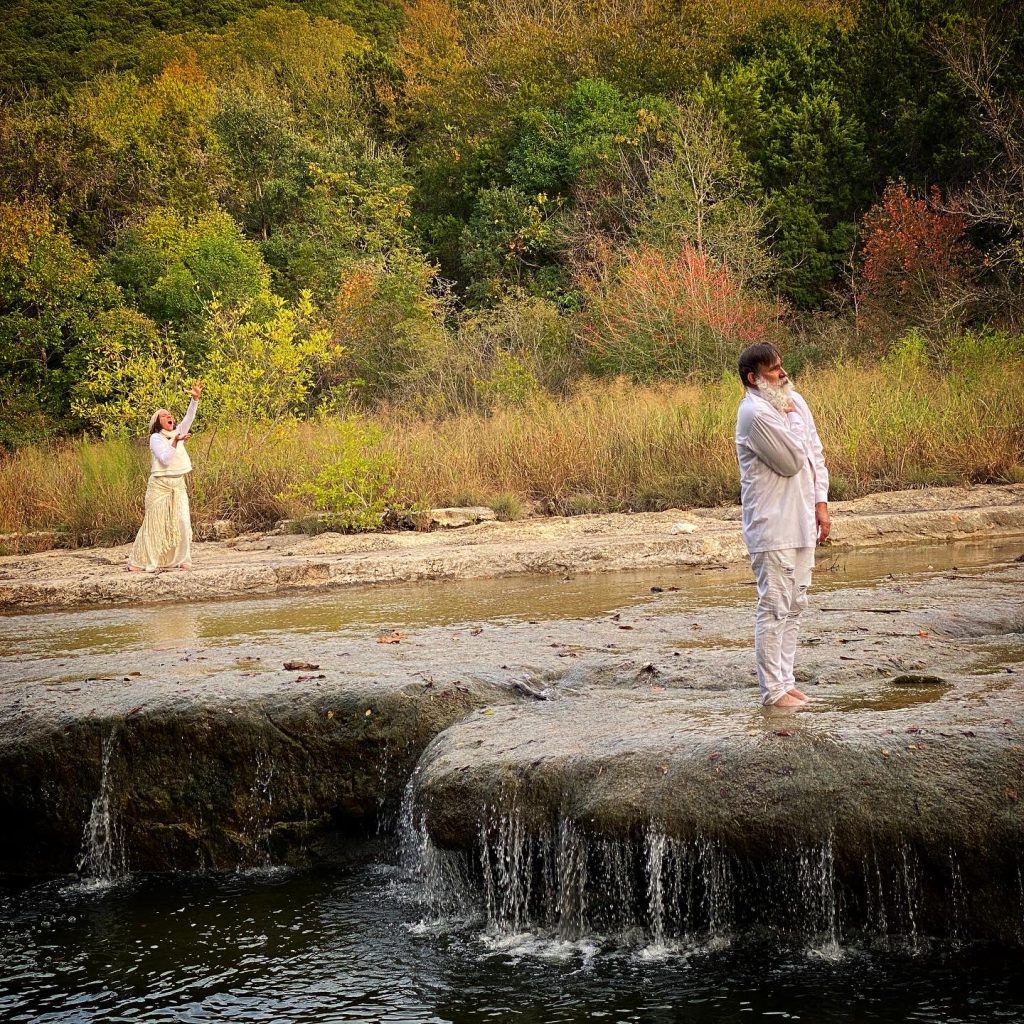
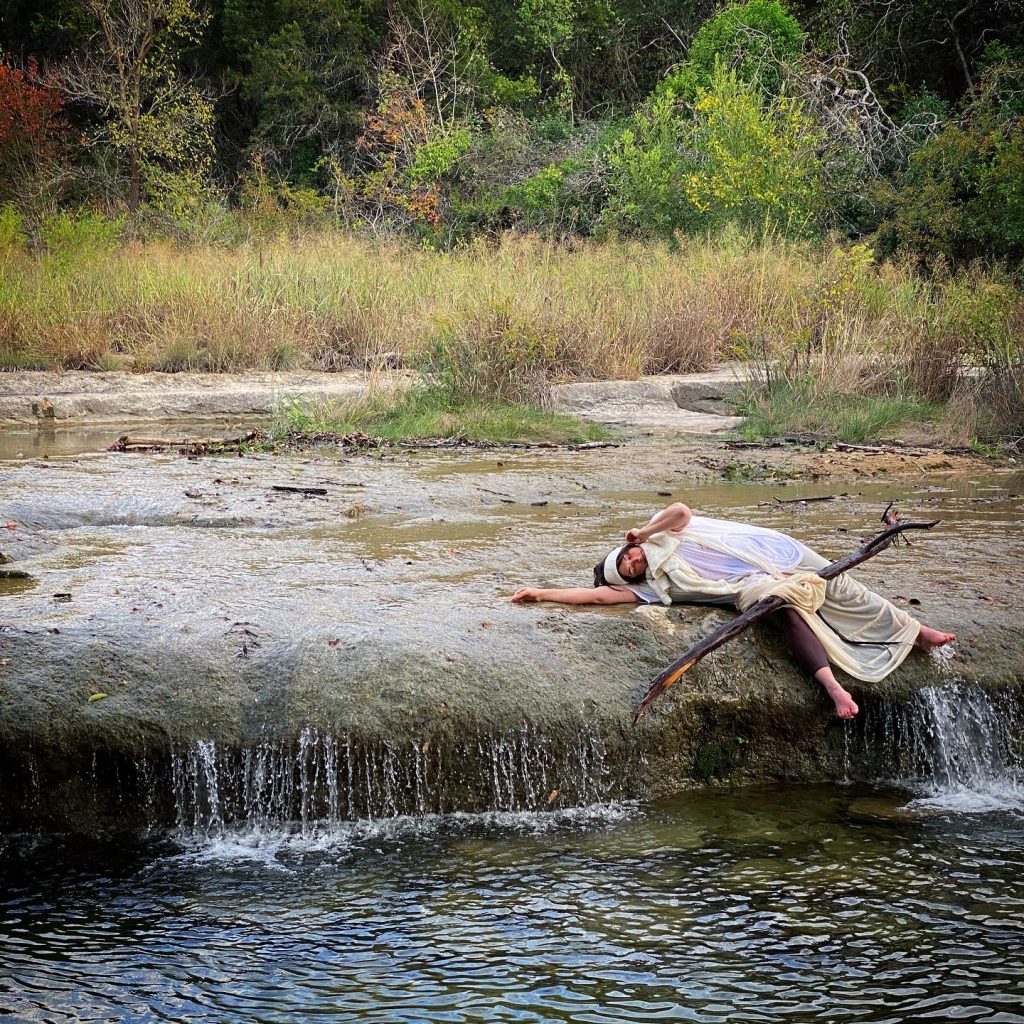
I’m still processing this experience, and everything I learned from bringing it into being with such an amazing group of people, and witnessing it all take place – but I wanted to take a moment to try and share some reflections about what it was like for everyone who couldn’t be there to see it in person. I’m going to focus on the dance part for right now, and share more about the altar tree soon – because there’s just a lot to hold here!
I am so floored that this vision came together the way it did, and very humbled by everyone that heeded the call to come be part of making it happen, and who showed up in support, and to receive support from the ritual.
I am curious to see if there’s a way for this Collective Grief Ritual to take place every year, in the same places, but with new visions and collaborators (and perhaps not competing with East Austin Studio Tours, schedule-wise!)
I know these public rituals of grieving are deeply needed – and I love the way that nature, art, dance, music, and altar-making allows us to transmute and alchemize the emotions that often feel too heavy to hold alone, and in private.
If you feel like you would want to be involved in the continuation of this ritual, and especially if you have a background in grant-writing, arts-funding, dance, and music – please reach out! It can happen again in the future if enough people are interested in helping to co-create it!
I’m still really in awe of everyone who chose to participate and share their art and soul with such grace. Dance is something I get so much out of witnessing – though my body doesn’t really allow me to participate in its expression the way I used to. So, being able to facilitate a space for these dancers to do what they do so beautifully was truly an honor.
The ensemble of dancers was comprised of: Kelly Goetz / @kellygrooves , Jonathan Hiebert / @jonathanhiebert , Debra McAdoo / @d.sweetpea , Amy Morrow / @thetheorists , Ellen Stader / @ellenpuppystader , Caroline Wright / @thewrightcaroline – and they each brought so much wisdom and emotion to this ritual, and moved me deeply with their movement, and their bright spirits. Deep bow of gratitude to all of them, and to the musicians, artists, helpers, and everyone who contributed their gifts towards making this thing happen.
I was really delighted to be making music for the performance with the brilliant David Quick / @davidquick59 on guitar and sitar loops, with the assistance of the PlantWave / @plantwave device held in my hands, playing energy from my body, and from my grief, and occasionally from the new child leaves of the mother oak I was leaning against. Denver / @denverartaustin was with us, making a silver tree from wire and it all came together in such a lovely and powerful way.
There were elders and children, infants, mothers, and puppies, family and lovers, old and friends and new all in attendance – a small but very welcome turnout on a chilly but absolutely gorgeous November afternoon. We gathered on spread blankets and folding chairs by the water, and observed the dancers across the falls, moving together at times, sometimes alone.
It was a bit of a balancing act, trying to stay present to allow the catharsis of this big moment finally occurring, while also holding the piano part of the music with the PlantWave, and trying to simultaneously document what I could, but I’ve always been a fairly decent multi-tasker.
What occurred to me most during the dance ritual was how living through multiple, continuing tragedies (a pandemic and mass death and disabling event, climate collapse, political unrest, the cumulative effects of injustice, racism, fascism, and late-stage capitalism, mass shootings of our most vulnerable) causes our own personal losses and griefs to tend to get lost in the mix of all of the above.
This is what grief feels like: sometimes, the weight of it all brings us to our knees. It’s too big to hold, completely overwhelming. We shake our fists at the sky, our faces contorted in rictuses of agony. Our guts get knotted up from the stress of it all – and we try to move it through our bodies, so it doesn’t tangle up inside us. Pain bends you into new shapes, changes you in big and small ways.
Often, we’re just wandering lost, numbed out, going through the motions, looking for something we’ve misplaced, that isn’t there anymore. Like walking into a room but forgetting why we came in there in the first place.
We’re alone, trying to meditate, centering, finding peace, laying on the ground, breathing. Then a heavy wave comes and we’re beating our hands on the earth, reaching out towards the sky, towards what and who has gone now, calling, praying, screaming, wailing. Begging to god or anyone to please help, please let them come back, please make this easier somehow…
Then there are the moments where we come together – to help one another wring out the salt-sodden linen of sorrow we’ve been trailing behind us, hang it out on bare branches, let it dry. Let ourselves be held, helped, seen, witnessed in our lostness, in our pain.
Then there’s the letting go – that happens in pieces, slowly, and then all at once. The softening happens, the forgetting, the smoothing of jagged edges, of tightly holding finally released, of allowing this to be what is.
Then there’s the time when we ourselves will walk away from the the dance, the party, the table – and cross the water to the place beyond, where everyone we’ve lost is waiting for us. We will go, trusting that we will be grieved, remembered, brought to the altar, candles lit – and brought back to earth, from whence we came.
That’s what I saw and felt, watching the dancers move with the water, the earth, and each other. What do you see? What do you feel, watching them? This is the ritual. This is the work, the alchemy, the process. As it was, as we created it together, on November 13th, 2022.
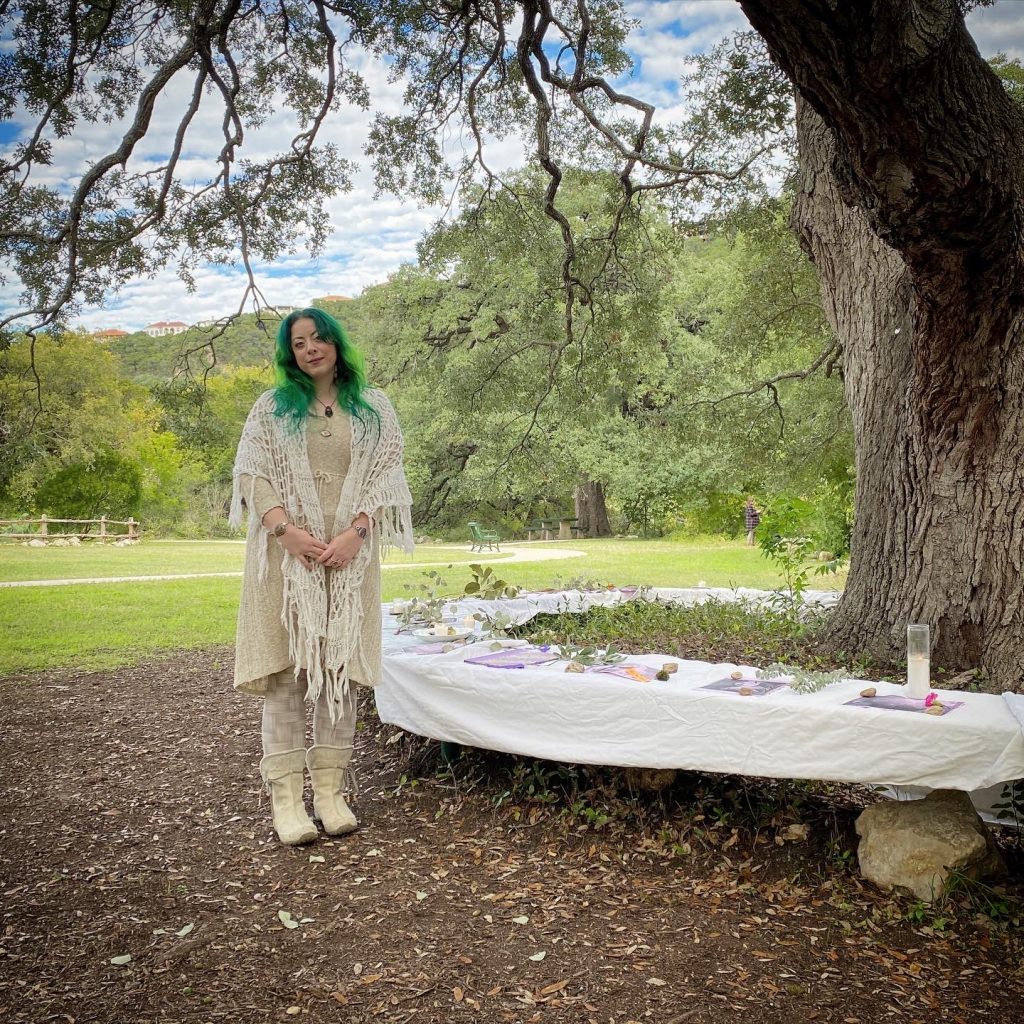
The vision for the Grief Ritual started here, with the tree – a mighty grandmother oak, branches curling and twisting above me, wise and majestic. I saw her standing so graceful and strong, and thought – she can hold it for us, with us.

We made a collective grief altar to honor everyone and everything that we have lost over the past few years of ongoing pandemic, and throughout our lives.
The purpose of this site-specific, free public ritual was to have a place to hold it all together. A friend I was messaging with prior to the ritual thought I was saying “hold it together” as in “don’t let yourself fall apart” – but what I meant was that here we can hold it, TOGETHER. As in, YES, FALL APART – and let yourself be held.
When I first saw the green octagonal metal bench around the tree I thought it immediately invited a communal altar – room for everyone’s dead, everyone’s offerings. This year’s was small, and simple – but I brought some of my dead, and there are so many, they filled up a lot of the space.
I would love to see this round bench space, with plenty of seating for denizens of the park, transformed once again next year into an altar to honor our dead loved ones, our losses, our griefs. This is not a traditional ofrenda – but an earth space where the dead can be with the strong roots of the oak, and dance around her.
It was very healing to build the altar this year – to lay out the images of my beloveds, and invite others to do the same. We lit the candles, looked upon their beautiful faces with cherishing and reverence, and remembered their light. There’s room for more – next year. Will you bring yours to the tree?
I wanted to print out the numbers of everyone we’ve lost to covid, just in this country alone, to add to the altar, to be witnessed. But it’s another grief that I found it impossible to find an accurate count – as everyone in charge has decided to stop keeping track of the dead.
I also wanted to lay lists of the species lost to extinction there, the acres of rainforest and old growth woodlands, the precious wetlands being decimated – but how best to represent those losses, when the numbers keep adding up to quickly to keep up with, and the amount is too high to really even process fully?
I would love for any artists that feel moved by these conundrums to contemplate how to visually reckon with these staggering statistics that are too large and abstract for anyone to hold. Please reach out if you have inspiration to bring to future iterations, or would like to participate next year, in any capacity.
 My Grrizelda, whose illness and passing sparked all of this.
My Grrizelda, whose illness and passing sparked all of this.
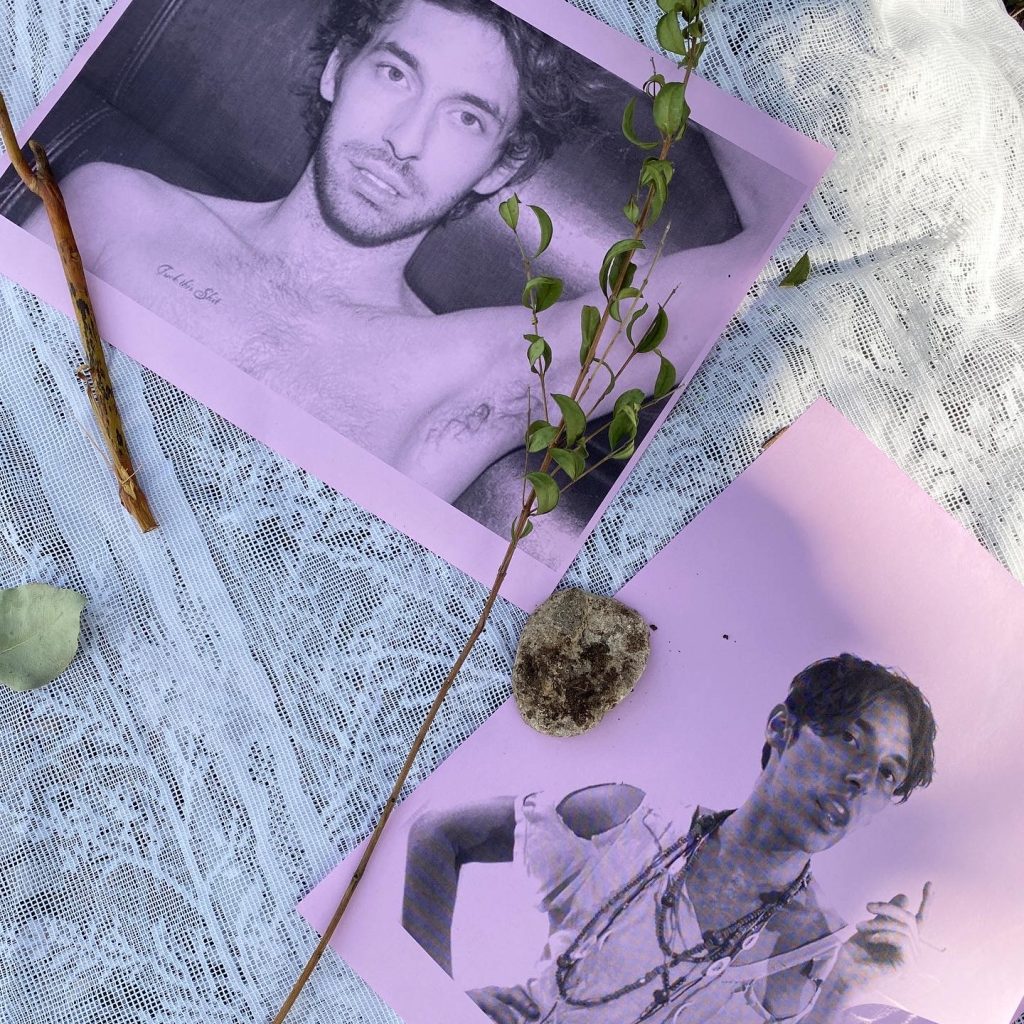 Matthew Varvil / @varville – left this earth on July 25th, 2022
Matthew Varvil / @varville – left this earth on July 25th, 2022
 Mary Ann Atkinson / @milkweedpollen – left this earth on November 2nd, 2022
Mary Ann Atkinson / @milkweedpollen – left this earth on November 2nd, 2022
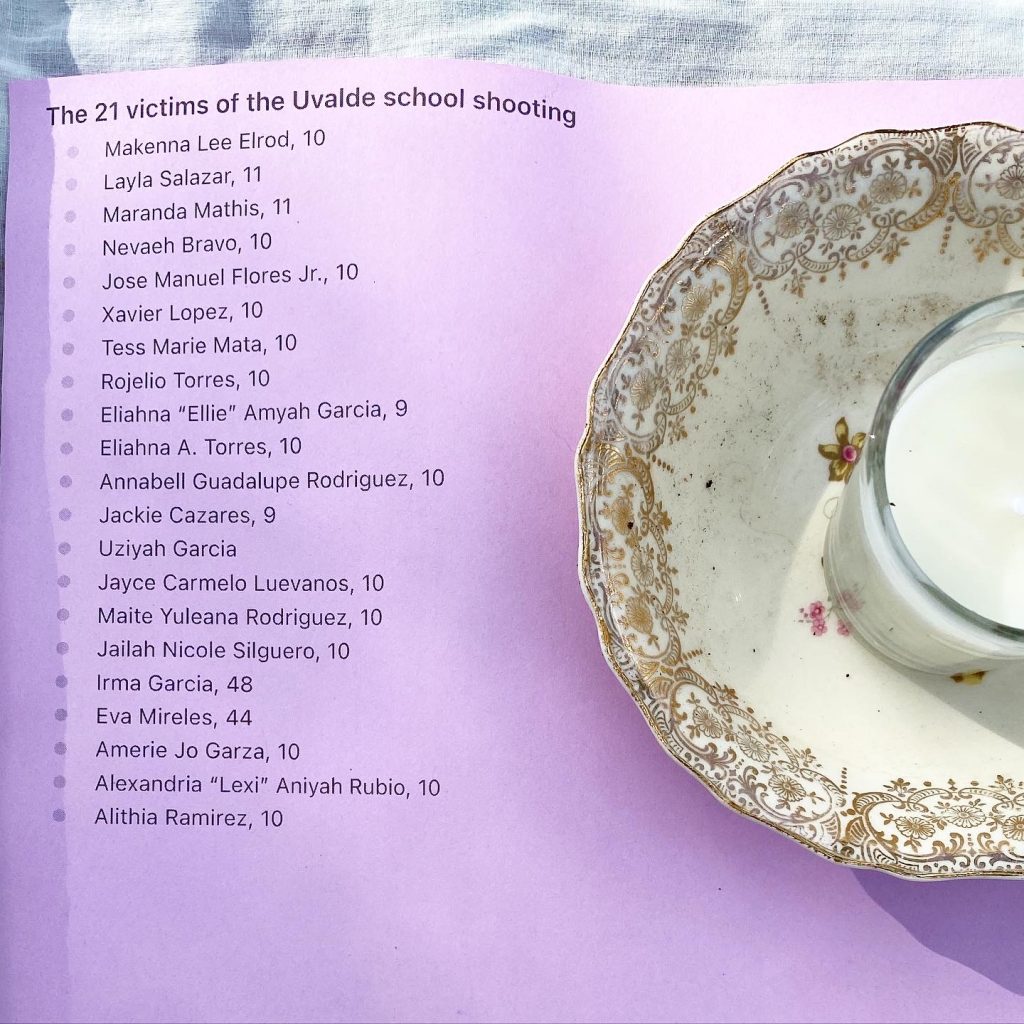 The 21 victims of the Uvalde school shooting:
The 21 victims of the Uvalde school shooting:
• Makenna Lee Elrod, 10
• Layla Salazar, 11
• Maranda Mathis, 11
• Nevaeh Bravo, 10
• Jose Manuel Flores Jr., 10
• Xavier Lopez, 10
• Tess Marie Mata, 10
• Rojelio Torres, 10
• Eliahna “Ellie” Amyah Garcia, 9
• Eliahna A. Torres, 10
• Annabell Guadalupe Rodriguez, 10
• Jackie Cazares, 9
• Uziyah Garcia
• Jayce Carmelo Luevanos, 10
• Maite Yuleana Rodriguez, 10
• Jailah Nicole Silguero, 10
• Irma Garcia, 48
• Eva Mireles, 44
• Amerie Jo Garza, 10
• Alexandria “Lexi” Aniyah Rubio, 10
• Alithia Ramirez, 10
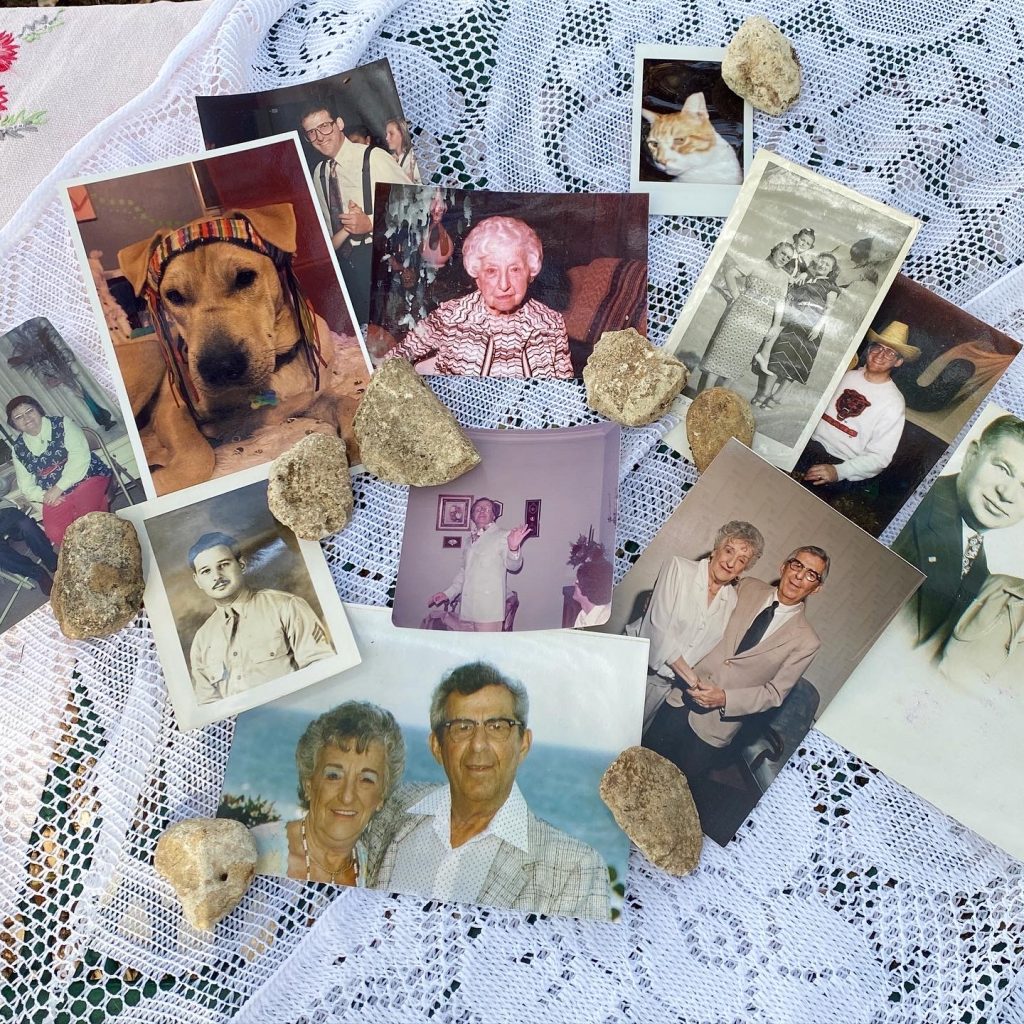 Fiona’s beloved dead
Fiona’s beloved dead
 Fiona / @fiiiyoniii holding it down at the altar tree
Fiona / @fiiiyoniii holding it down at the altar tree
 Tigre Bailando / @tigrebailando – left this earth on October 1st, 2022
Tigre Bailando / @tigrebailando – left this earth on October 1st, 2022
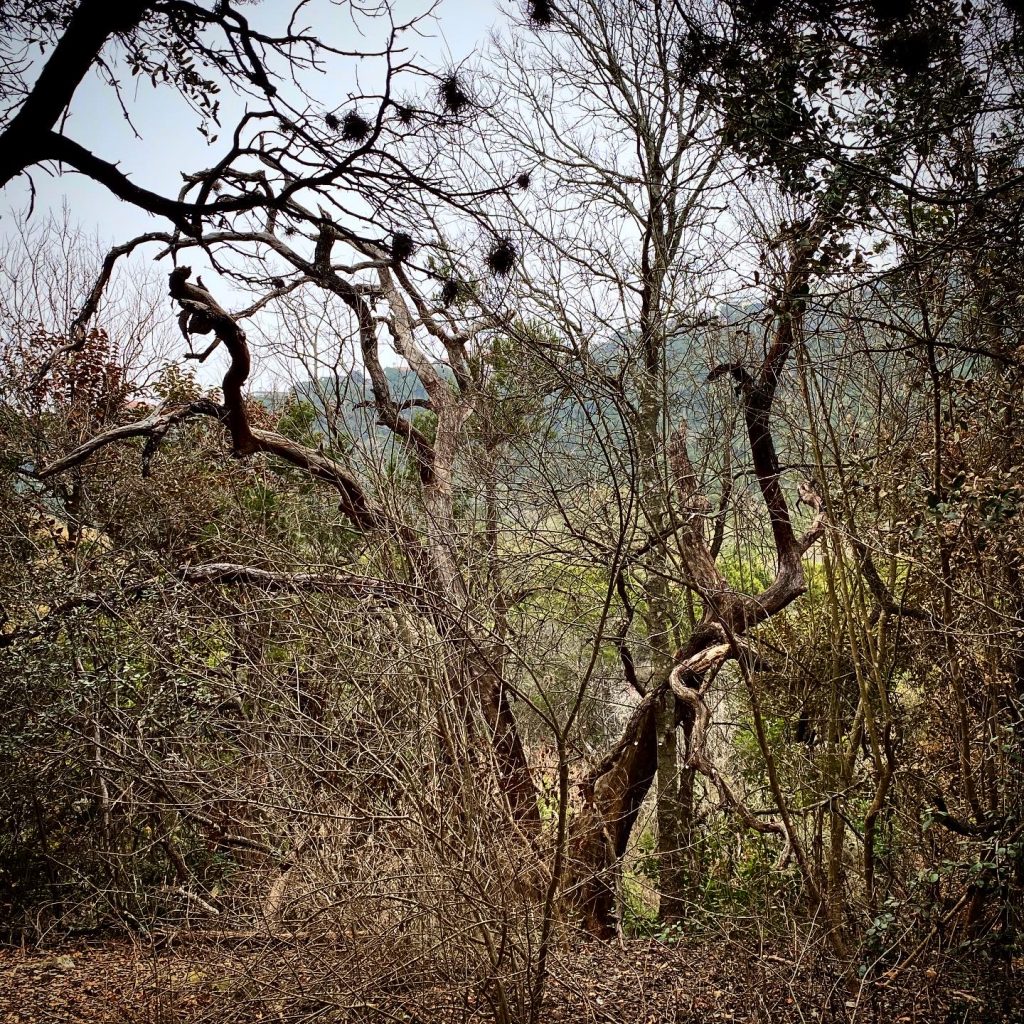
The Grief Ritual could occur again, and continue year after year, in new forms, brought by collaborative visions – if there is interest and desire, and the willingness to co-create and participate. If you want to be a part of making this happen again, and especially if you have ideas and resources for helping to secure funding and grants, please get in touch.
HAZY WINDOWS
by angeliska on August 9, 2022
When you are a wanderer in the infinite terrain of loss, you learn strange ways to cope, and to heal. Some people become experts at avoiding and deflecting all the painful memories, or toughen up into stoic, armored warriors – or spend all their energy helping others with their problems instead. I’ve done some variety of all of these, and found myself slamming up against limitations of compartmentalization, codependence, and hardness, over and over. Those ways will only work for so long, before our defenses finally crumble, and we’re forced to reckon with the pain we’ve been running from. I definitely learned that the hard way.
Anniversaries like today (my mother’s death day) tend to bring it all up to the surface, and I’ve come to use this time as a way to check in on myself, and my healing process. Every year, I write about where I’m at, and try to sit with whatever is coming up for me at this time. Last year, I was really, really angry. I felt extremely alone, and incredibly sad and frustrated – for so many reasons. This year, I’m slightly more at peace – a bit more accepting of the various ongoing failures of connection and empathy, though it’s still incredibly painful and frustrating to acknowledge how little anything has really changed (particularly when it comes to this never-ending pandemic).
Last summer, my Uncle Mike gave me some old photographs of my mother and I that he’d come across in his recent move. I’m guessing my grandmother must have taken them on a visit to Texas, and they’d ended up with my uncle after my grandparents died. Anyone who’s lost a parent, or really anyone they’ve loved knows the pain of realizing that with their death, the photographs, voice recordings, and videos of that person have now become a finite resource. There will be very few new ones to discover as the years roll on – so when any images you’ve never seen before do appear, it feels like a rare and sacred gift. You learn to dig for bits of the ones you lost, like an archaeologist, sifting through the ashes for glinting shards, long buried.
Trying to glean information from the past through scraps of old media, and our own often faulty memories is like trying to peer through the hazy, fogged and dusty windows of an old locked shed. You know it’s piled high with old boxes and trunks stuffed with the essential fragments and nostalgic memorabilia of old lives – but you can’t seem to ever get inside, and everything in there is rapidly crumbling to dust and being devoured by mold and silverfish before you can get your hands and eyes on it. The people who knew my mother best are all either dead, or in their 70’s. Their memories are fading, and every year, there are fewer and fewer new stories – and that’s when I can get them to talk to me about her.
Sometimes it feels like all the secrets of my life and childhood are locked away in that place I’ll never be able to access. When I’m able to get a hold of any random piece, it’s hard not to cling to it for answers, for understanding. There’s so much I don’t know, and will never know. So much I’ve had to guess at, or surmise. I’ve been forced to develop into a very adept sleuth of my own personal history, and my own family – in order to know myself better, and to have more compassion for how I came to be the way that I am.
This process is like trying to clean that dirty glass – in attempts get a clear view backwards, into the past. There are times when the spit-upon spot-shine of an old hankie wiping a little window onto the hazed glass is somehow enough, and we’re able to see right back into a certain day, even a certain hour of our past existence with the clarity and sharpness that can be staggering. That’s what it feels like, looking at these six round-edged (I unfortunately had to crop those when I scanned them in) photos from circa winter 1980 or ’81.
Even though I have others tucked away in photo albums and old tins, these ones are a priceless treasure to me – because I’d never seen them before. There aren’t very many pictures of my mother holding me, or caring for me. The few that I have, I’ve pored over and treasured. I’ve always thought it was because she was usually the one remembering to take the photos, but it’s hard not to wonder… Except for one where she’s breastfeeding me, she’s never really seen engaging with me, talking to me or making funny faces, the way my dad always is – while putting on my little shoes, burping me, or giving me a bath. He has acknowledged that, for various reasons, he was my primary emotional caretaker. But that didn’t mean that I didn’t keep trying to get what I needed from my mother – she was just never really able to provide it, or, maybe just not fully and wholeheartedly.
I’m so grateful to have been given these photographs, more than four decades after they were taken – but they also opened up a Pandora’s box, in some ways. They are a portal into a time where I was present, but can’t really remember. I must have been only about one or two years old, in these photographs. I don’t remember that time, but the effects of whatever was going on then continue to affect me to this day.
It’s impossible not to scour images like these for clues like a detective, to help me better understand the relationship between my mother and I before she died. It’s taken me years to reckon with the fact that it was not only her premature death only seven years after I was born that left deep scars on my being – but also everything that happened (or didn’t happen) in that time between my birth, and her death.
There are people (I’m not sure exactly what their job title would be), whose job involves examining old photographs very closely for context clues about situations and relationships. Certain genealogists and historians have training in this, as well as child psychologists who know how to look for signs of abuse or neglect in familial relationships. The body language between children and their caretakers can be very revealing, when it comes to understanding the dynamics at play between them.
There might be some who would say that for me to attempt to do this with my own little stack of photos is just…grasping at straws, making assumptions, or being blinded by confirmation bias – but I’ve come to these conclusions after years of trying to understand myself and my mother, and the pain that we both endured. To me, these images are incredibly revealing – and I don’t think that I’m wrong in feeling that they show a lot about what was happening when I was a very young child. You can trust me on all of that, or not – but I know what I know, and well, this is my healing journey anyway.

The first thing I notice in looking at each photo, is that my mother is not looking at the camera (or the person holding it), in any of them. This immediately strikes me as odd, for a lot of reasons. In that era, it was kind of a big deal to buy film, and to use flashbulbs for your camera. I remember being mystified by the spent silvery cubes of the disposable flashes that were used at the time, sold in packs at the drugstore. Little squares containing ephemeral light – that would flare up for a moment, and then never again. These things were a luxury – and not to be wasted frivolously, especially by my frugal parents during the recession years of the belt-tightening early 1980s.
Because I believe that it must have been my grandmother who took these photos, and that this was a rare visit from Los Angeles to Texas, it seems doubly odd that my mother would make no attempt to smile for the camera (she also had to be standing pretty close to us, to get these shots), or even to raise her head to look up, or look in that direction. It almost seems like she’s intentionally avoiding doing so. Her face is stony, set, and remote, gaze averted.
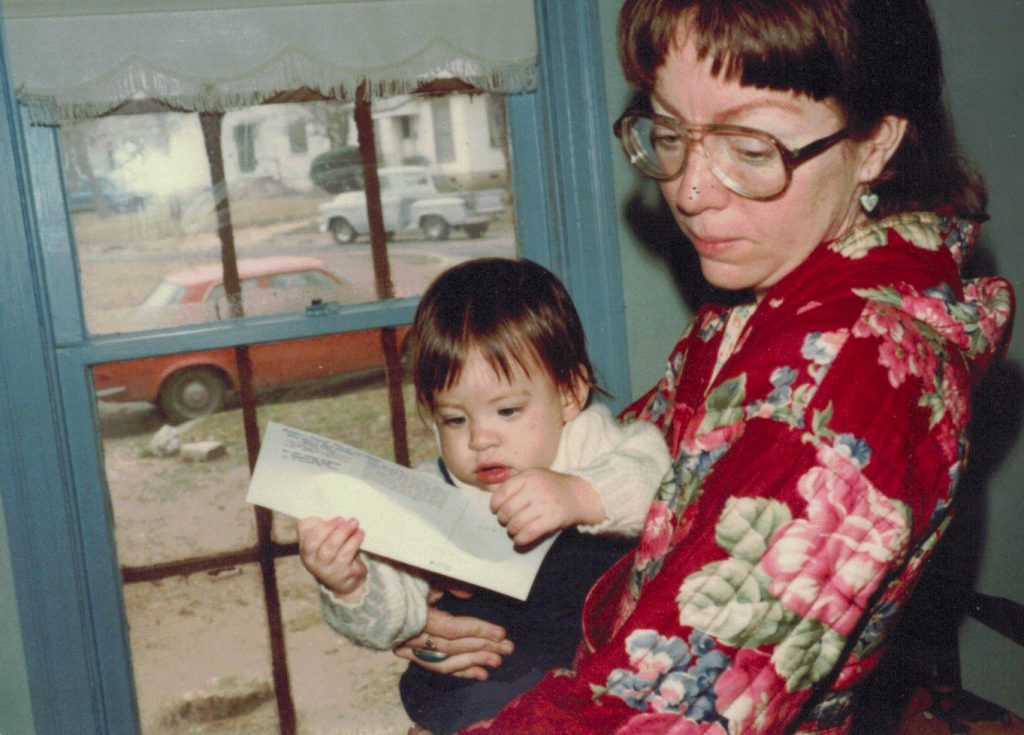
My grandmother liked to take candid, unposed photos – so maybe it’s not so strange that my mom isn’t making any attempt to “say cheese” for her and the camera, but most of the images where my mother is holding me, I’m twisting away from her, to look at the camera, and ostensibly, my grandmother, who is likely talking to me, and engaging in some way with me. She’s making bids for my attention, and I’m responding to that, because that’s generally what little children do. My mother isn’t engaging with either of us, but instead seems lost in her own thoughts. It feels like she doesn’t really want to be there.
To my knowledge, my mom didn’t have any beef or issue with her mother-in-law, but who knows – maybe she was just having a bad day, or just didn’t feel like having her photo taken right then. That could certainly be the case, but – what I see in these photographs is a woman who is profoundly unhappy, and likely even very depressed.
In the images where I’m alone, I’m no longer looking at my grandmother holding the camera, but instead probably have my eyes on my mom or dad – tracking where they are, so that I can feel safe. In the years that I’ve been studying childhood developmental trauma, so that I can better serve my clients, and to also understand my own trauma history better, I’ve come to understand some essential things about what most little kids need in order to feel secure in this world.

I learned from my dad a a few years ago that my mom did struggle with depression, as well as trichotillomania (pulling patches of her hair out), and what sounds a lot like other symptoms and signs of obsessive compulsive disorder. I don’t think that she really had access to therapy or much in the way of help. It’s heartbreaking to consider how much better things could have been for us, if my mom had been able to work with someone on the things she was going through, emotionally. I feel so badly for her, for my dad, and for myself – all desperately trying to be a family without the proper tools or support.
I’ve since come to feel strongly that there were certain aspects of my birth and existence that were deeply triggering to old traumas in her past, and that nurturing me and enjoying much of motherhood wasn’t something that she really took to. It’s taken me a long time to understand that none of that was my fault – and that the issues that she had with connecting and bonding to me didn’t start with me. I’m also coming to understand how incredibly damaging and scarring it is to not have had that deep bonding and nurturance from the person I continually looked to for safety, comfort, and connection.
I had been learning about the effects of childhood emotional neglect and the “Still Face Experiment” for a few years before I ever saw these photos – so when I finally laid eyes on them, many alarm bells started to ring. This article and video from The School of Life lays out what it all means:
“How we were cared for as infants and young children has a disproportionate effect on how we will relate to others in adulthood. What we need to ensure is above all else a responsive parent: an adult who looks after our needs with sensitivity and kindness. This is quite literally life-defining and life-saving.
It sounds like nothing much and nothing too hard – but without this kind of responsive love we are wounded for life. Many of us have been.
Researchers have become ever better at showing the effects of neglect on children. One of the world’s leading experts is Dr Ed Tronick, director of the Child Development Unit at Harvard University. Together with his team, he is responsible for one of the great experiments in the history of psychology, known as the STILL FACE EXPERIMENT.
Watching the baby get distressed can be highly triggering. If a child can get so upset over a few seconds of cold and unfeeling behaviour, we have a sense of what can happen over years or more of neglect.
No wonder some of us don’t feel so well inside. We may have had an equivalent of a still-faced parent for our first decade and more.
But knowing how vulnerable we are shouldn’t merely sadden us: we can take stock of how we have been failed and understand the link between the past and our present difficulties.
Psychological research like the Still Face Experiment is at the forefront of helping us to understand ourselves emotionally, shedding scientific light on the origins of our sadness and complexity. Along the way, the experiment proves something beyond doubt: love isn’t a luxury so much as a gateway to survival and sanity.”
– from How We Get Damaged by Emotional Neglect
Watching the video above, particularly of the Still Face Experiment taking place, is indeed, highly triggering for me. I cried, watching it again today – especially at the part where they show the child reflecting the stress of the experiment in her posture, and turning away from her mother. The child will disengage from their parent, and not look back. I see that in my own posture, here – pulling away from my emotionally shut down mother and her flat affect. I’m either distracting myself in these photos, or looking towards the person who’s actually engaging and interacting with me.
I’ve known for a long time that there was something in the knowledge of this phenomenon that I’d experienced firsthand, but seeing photographic evidence of it playing out was really intense – and both upsetting, and strangely confirming.
One thing I wish they’d gone deeper into in this video and article are the reasons why a parent’s face might go still and unresponsive in the first place. They don’t mention the effects of depression (especially postpartum depression) on mothers, or the stress of parenting that might lead to a parent not knowing how to bond with their child. Not only that, but more recent studies have shown that smart-phone use mimics the effects of the Still Face experiment. It’s terrible to think about how many kids (especially those growing up during this never-ending pandemic) will bear the brunt of their parents’ depression and distraction.
Babies and young children deeply crave connection, and need to be in close contact and relationship with their caretakers in order to feel safe. Being held is part of it, but gazing, talking, mirroring play, and other forms of expressive affection are all a huge part of our healthy emotional development. The way we are parented has an enormous affect on our ability to feel emotionally safe in close relationships later in life. As a neurodivergent (ADHD/HSP) person who experiences Rejection Sensitive Dysphoria (RSD), I can say that understanding the roots of why certain behaviors are incredibly painful for me has really helped me be more gentle and compassionate with myself when I’m hurting.
Because of my early childhood experiences, feeling ignored, ghosted, abandoned, disengaged from without any explanation, and/or any form of silent treatment can often feel especially dysregulating for me. Whenever this has (unfortunately) happened in my friendships and romantic relationships, I’m often shocked by how disproportionately affected I am – not that it wouldn’t be painful for anyone, and just shitty, emotional immature behavior in general, but…I can recognize now the part of me that has an extra hard time with people I’m really close to pulling away and shutting me out, and now try to take steps to tend lovingly to the freaked out child part of me that desperately wants to reconnect.
I try to remember that healing relational trauma happen IN relationship. That building trust and reconnection are very possible, and that new neural pathways can be strengthened to help us feel more secure and resourced, in our relationships with others, as adults. I am so grateful for all the people in my life who teach me the truth of this, every day. And especially for all the ones who remember that today can be really tough for me, and check in with kind words and wishes. It helps me know that I can face these feelings, and this pain – and that I’m held in the process. I know that I’m not alone.
Learning how to tend to and care for my inner child has been one of the most helpful and transformative things I’ve discovered on my road to healing. If you were raised in a family where there was a lot of trauma, and where your parents were overwhelmed, grieving, and depressed (like mine), or worse – you might want learn more about the effects of emotional neglect on children.
Even in households where you were fed, had clothes on your back, a roof over your head, and weren’t being actively hurt or abused – emotional neglect can be a big thing to grapple with. It’s especially common for a lot of us Gen X and elder millennial folks whose parents were working, divorced, or otherwise preoccupied – and left us latchkey kids to be babysat by the television or by asshole teenagers.
Emotional neglect really comes into play in families where it’s not safe or possible to talk about emotions – especially difficult emotions like sadness, anger, or fear. Often in the most “perfect” looking families where everything is always pleasant and upbeat, this can be a big problem.
If any of this is ringing a bell for you I highly recommend you give Running On Empty: Overcome Your Childhood Emotional Neglect by Jonice Webb a read. It’s a fast read, and even the chapters that didn’t really apply to my life were really eye opening. I also recommend that all parents and/or prospective parents read it – especially if you were raised in a household where nobody really talked about their feelings.
Learning to be the safe mama monkey to your own inner baby monkey takes a lot of time and work – but it can start with beginning to comfort yourself when you’re upset or afraid instead of ignoring or abandoning yourself. For those of us that experienced childhood emotional neglect, it can take a lifetime to learn how to not neglect ourselves – but it absolutely is possible.
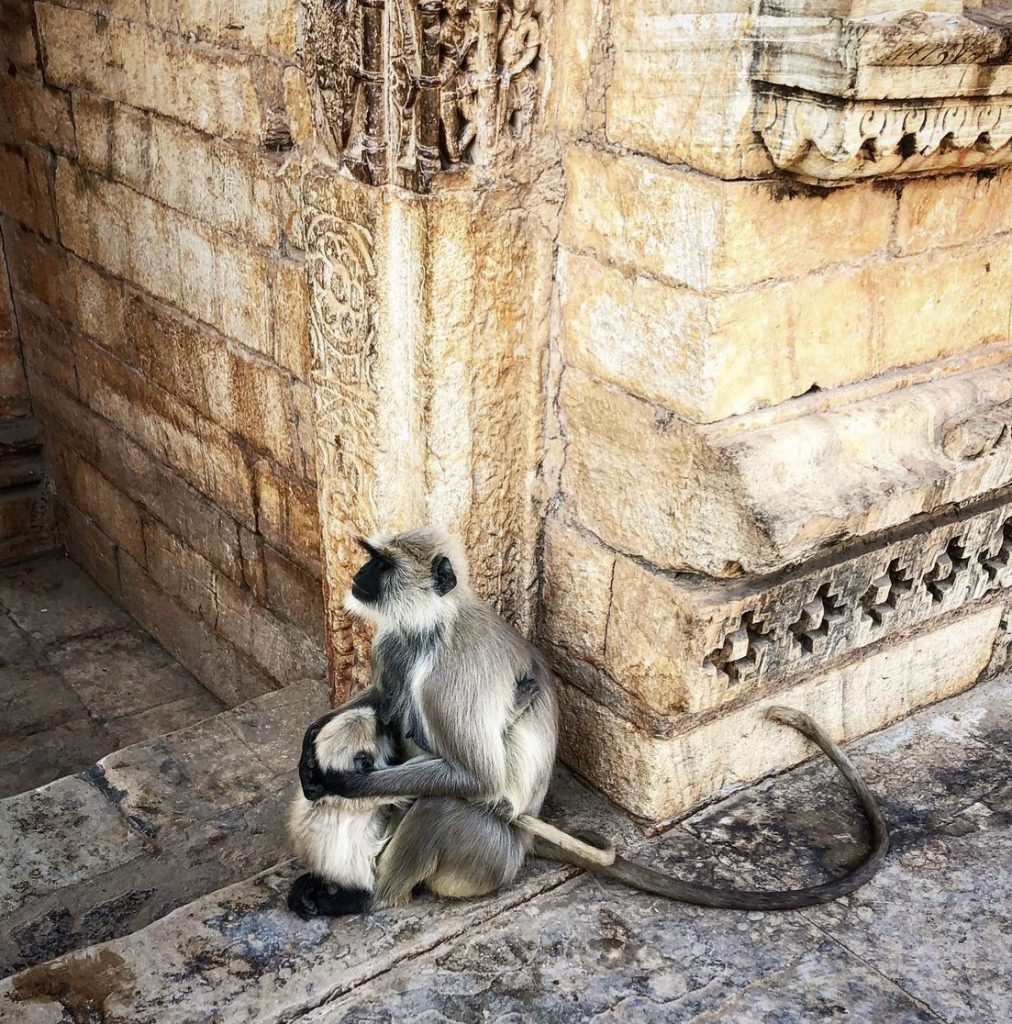
I spotted these two beautiful monkeys, a mother and her child, at a temple in Rajasthan. I loved seeing how universal it is to want comfort –and how natural it can be, to want to give it.
I wish it had felt more natural, and more joyful for my mom to show affection and tenderness to me. I know that there were likely many sweet moments between us, that went unphotographed, undocumented. I have to trust in the simple intimacy of the fact of her and I, and our relationship. I remember her patiently teaching me to hand sew, the red thread dipping in and out of brightly flowered calico, to make a dress for my dolls. I remember her washing my hair with an aluminum pitcher, a wash cloth held carefully over my eyes so the shampoo wouldn’t sting them. I remember her teaching me the names of the flowers, and instilling in me a love of green growing things, and a respect for animals (especially cats). I remember the dinners she would make: shake and bake chicken with lima beans, and Five Alive or Tang to drink. I know that she held me in her body for nine long months, and nursed me from her breast until I grew teeth. She changed my diapers, comforted me when I cried, and read me stories, and sang me lullabies. She put me in my highchair, and gave me crackers to eat. I don’t want to ever diminish or dismiss the sacrifices she made in parenting me, and how important it was to her, to be a good mother to me. I know that she took it seriously. I know that she cared.

My mother hung crystals from old chandeliers from my windows to make rainbows dance around my room on sunny days. I woke to rainbows all over my bedroom this morning, and thought of her, and how she taught me to look for beauty everywhere, and to cultivate it in everything I do. I will honor her tonight as I paint – another thing she taught me to do. And though it may not seem like it, I am honoring her with this writing. I may be wrong about these photographs, and how I’m interpreting them. It may do me no good, all these years later, to speculate on the whys and hows of how we were with one another – and what she was like, as a mother to me. My aunt Ruth reminded me tonight that my mom had a tendency to look downright grumpy in photos – especially when she really didn’t want her picture taken, and that she was never much for toothy grins. Maybe that’s it, all it really was – a case of lifelong RBF (resting bitch face), or randomly staring off into space, captured one cold winter day, when I was very small.
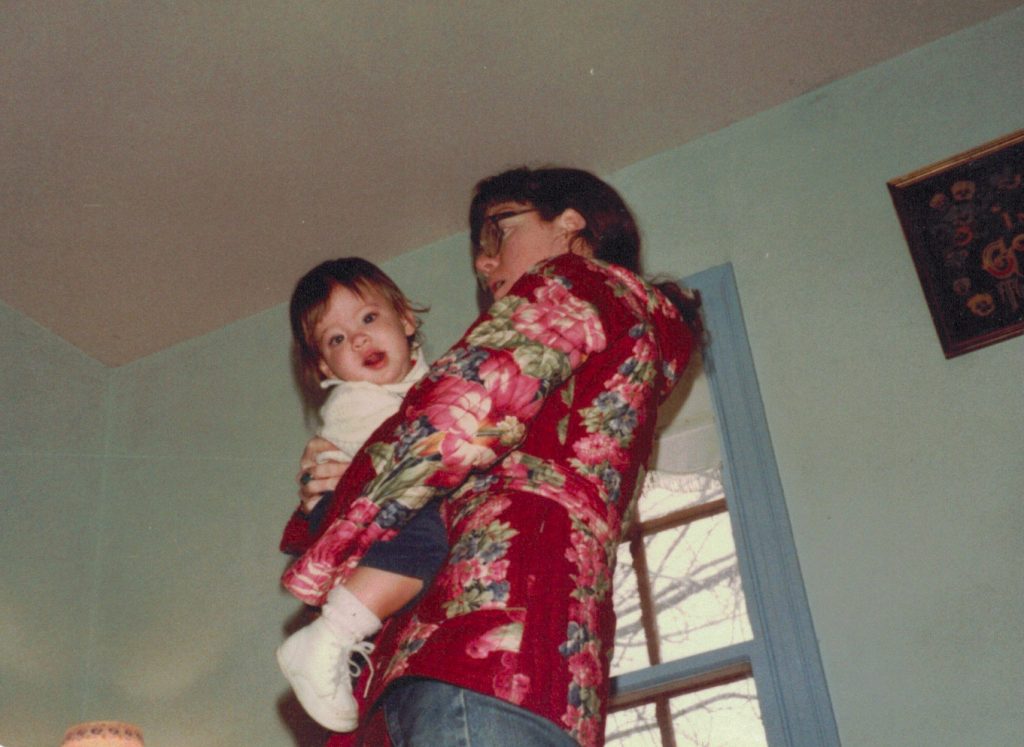
I realize, in writing this – that perhaps both things can be true. Whatever it is I’m seeing in her lack of expression that afternoon, and in my little body turning away from her is very real for me. I don’t really think it was a one-off, or that it was just that particular instance. I feel the disconnect and the profound longing for her attention, her approval, to be connected and engaged with her in my bones. I feel the lack of it, the loss of her – not just in her death, but also almost every day before it. It still affects me deeply, to this day – like a severe nutritional deficiency that causes stunted growth, or rickety limbs. It’s a hunger that never, ever goes away – and is never really sated or fulfilled. So – I’ve had to learn to nourish myself, and tap into that connection within, and elsewhere in my life. It’s not the easiest thing to do, but I work at it every day.
I so wish I could ask her about all this, about what it was really like for her, for us – but I can’t. What I can do is continue to learn good ways to nurture myself, and to take responsibility for my own healing. I’m very committed to that inner work – and this writing, here, is a big part of that (so I thank you humbly, if you’ve read this far, for being a witness to my grief, and to my process.)
I keep my mother’s memory alive by honoring all the things she loved: learning to play and sing the old-time tunes, listening to her vintage records playing Lydia Mendoza and Kitty Wells, wearing garments printed with flowers, (especially cabbage roses), painting and drawing, and working every day to make the world a more beautiful place.
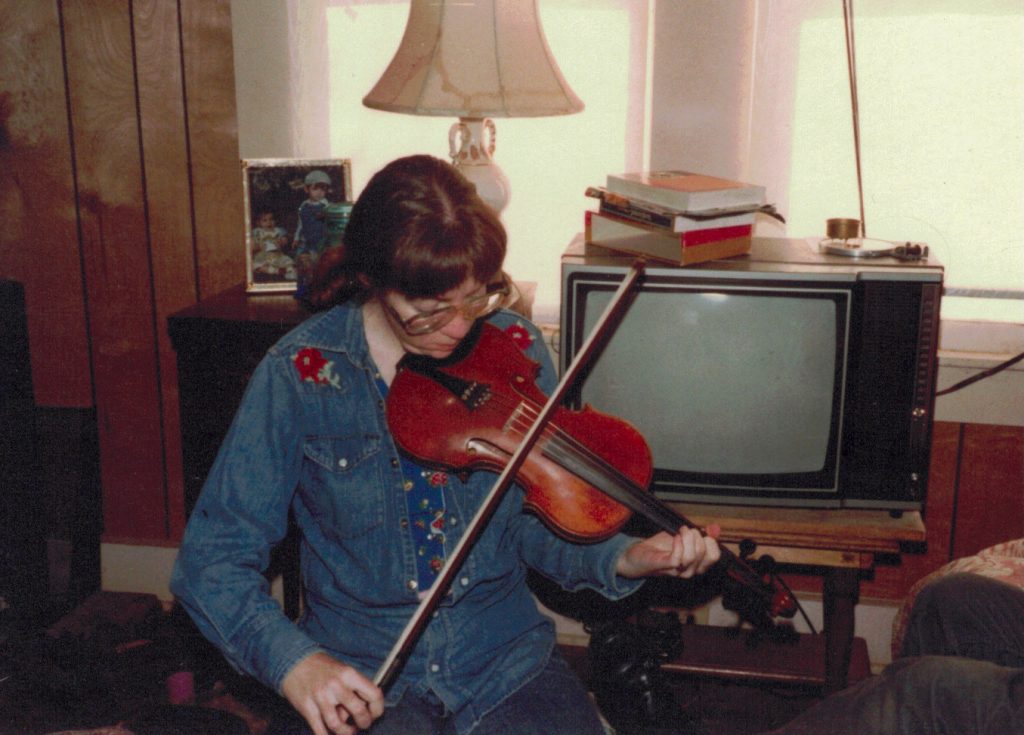
I know that I am chief among what she loved, her only child – so I will keep loving myself, and taking good care of myself, because I know that that’s what she would want. And I will keep looking back into the past for her – through these hazy windows, searching for her still, quiet face in the distance.

If you’d like to read more about this journey
of grieving, honoring, and remembering my mother,
here is an archive of my writings about her:
THE AUGUST RITUAL
FALLING STARS + CACTUS FLOWERS
DOUBLE ETERNITY
MY ANGELIC INHERITANCE / THE HOLOGRAPHIC WILL
38 ON AUGUST THE 8TH
30 YEARS – SEIZURES
888 – HONEY BABE, I’M BOUND TO RIDE – DON’T YOU WANNA GO?
WILD BLUE YONDER
NO ROOM IN MY HEART FOR THE BLUES
FAMILY VACATION – HANK WILLIAMS’ GRAVE
STAR-CROSSED TROUBADOURS
Foxes in the Rain
Triumvirate Lemniscate
Gustav + Mama – August 8th
GRIEVING GRRIZELDA
by angeliska on April 15, 2022
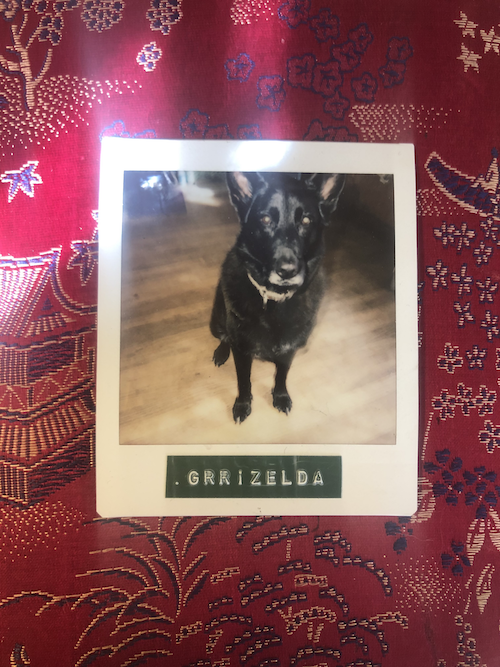
Many years ago, I asked my dog, “So Grrizelda, what’s it all about?” She got excited and wiggled her butt and gave me one paw to shake and then the other, confirming my belief that the secret of life is, in fact, the hokey pokey.
I said, “Is that what it’s all about? Well, what about kisses?” And she gave me a very enthusiastic kiss. Now, I know dog kisses are supposed to be gross and unsanitary, but I’ve never really been one of those to worry much about stuff like that. Plus, Grrizelda gave the very best dog kisses. No slobbery tongue or full-face mopping – just a sweet little smooch of wet nose and black doggie lips. A kiss a daughter would give a mother, full of joy and adoration. A tail wagging exuberant heart-shaped stamp of approval, a canine benediction.
So then I laughed and hugged her and said, “Well, is THAT what it’s all about?” and she strreettched out her perfect silky black starfish paw-foots and bowed low into bonafide doga downward dog – a play bow that says, “I respect you and love you very much, and I would also like to play with you!” and I laughed and hugged her some more and took this picture of her sweet eager seal pup face and her graying chinny-chin-chin and I just wanted her to live forever and ever because she knew everything there is to know, and was the best friend I could ever wish for. Loyalty, humor, unconditional love, and sweetness – traits I admire, and seek to cultivate in my friendships. Grrizelda was, and still is my teacher.

I found Grrizelda one summer afternoon on my lunch break, walking down to the coffee shop a near the antique store I worked at. Austin Pets Alive (a nonprofit devoted to helping critters in need of forever homes get adopted) had set up some pens with pups and I paused in front of one with a gorgeous but very depressed looking black dog laying on a mat, panting in the heat. The volunteer came over to tell me about how black dogs and cats were often difficult to find homes for, and how special it was when they were able to find someone who wanted to adopt one. The spiel definitely helped, and though this particular black dog wouldn’t even really raise her head to look at me or interact in any way, I snapped a few photos on my phone (I so wish I had those now!) and later that night, showed them to my partner. “What do you think about this dog? She’s really pretty, right?”
The next day, after he dropped me off at work, he went down to check her out for himself. A little while later, I hadn’t heard anything back, so I called him to find out what his first impressions were, only to hear, “Hang on babe, I’m filling out the adoption paperwork!” Looking back, I think I needed someone else to pull the trigger on making that intuitive decision, and I am so incredibly grateful for the gift of Grrizelda (who came from the shelter with the name Zelda!) That evening they both came to pick me up from my shift, and as soon as as I got into the passenger seat, a ball of wiggly, face-licking joy launched herself from the back seat into my lap. That sad, dejected dog from the day before was nowhere to be seen – because Grrizelda (as I soon dubbed her) knew she had found her home.

Look at how tiny she was! Just a little puppy, really. This was 2009 – right after we adopted her, and not long after Thelonious lost his sight.
We had been thinking of getting a companion for Thelonious, our seven year old Border Collie, ever since he suddenly went blind. He was so smart, and getting along so well – but we figured he could benefit from having a friend and a seeing eye dog. Grrizelda was way more interested in harassing him, rather than guiding him around much – but they became very close, and went on many adventures until Thelonious died at age 16. Losing him was so hard, and I never wrote about him and what a precious and beloved creature he was – and I’ve always regretted that. Now it just feels so long ago, though I still miss him intensely. Writing about my memories of loved ones who have passed has always been such a major balm to my grief, so I’ve giving myself all the time I need to express what I need to say about my time with Grrizelda. I think having Thelonious live so long convinced me that I’d have Grrizzle for near that time. I always thought I’d have her at least until 15 – so losing her at 12 just seemed… so ruthlessly brief, even though I know by dog standard, it was a decently long life. Those 12 sweet years just flew by, and looking back now, I wish I could stretch them out somehow. It’s so painful, reckoning with the fact that our animals don’t live as long as we do – and that in signing up to love them, we’re also agreeing to lose them.

I have this old photo of a lady and her black German Shepherd companion framed on my wall, and it brings me a lot of joy and comfort.
In my years as an antique dealer, I would often come across old black and white photographs of people’s pets, and was always struck by the thought that I was looking at an image of a beloved critter who had died long ago. I especially loved finding photos of black German Shepherds who resembled Grrizelda, and I would always wonder what their names were. I collect these old orphaned snapshots – of kids clutching a litter of kittens, or a big tomcat sitting regally on a front porch and wonder who they were to their people. What was it that made them so special, precious enough to be captured on film? These relationships are so deep, so singular – and yet also so incredibly personal. There are rarely public funerals or obituaries for our pets, but our grief for them is sometimes even more profound and devastating than when the humans in our lives pass away. That’s part of why I feel I need to write this here, and share it publicly. I don’t want Grrizelda to be just a handful of random photographs. I want her to be remembered, and known, by anyone who cares to read about who she was to me.
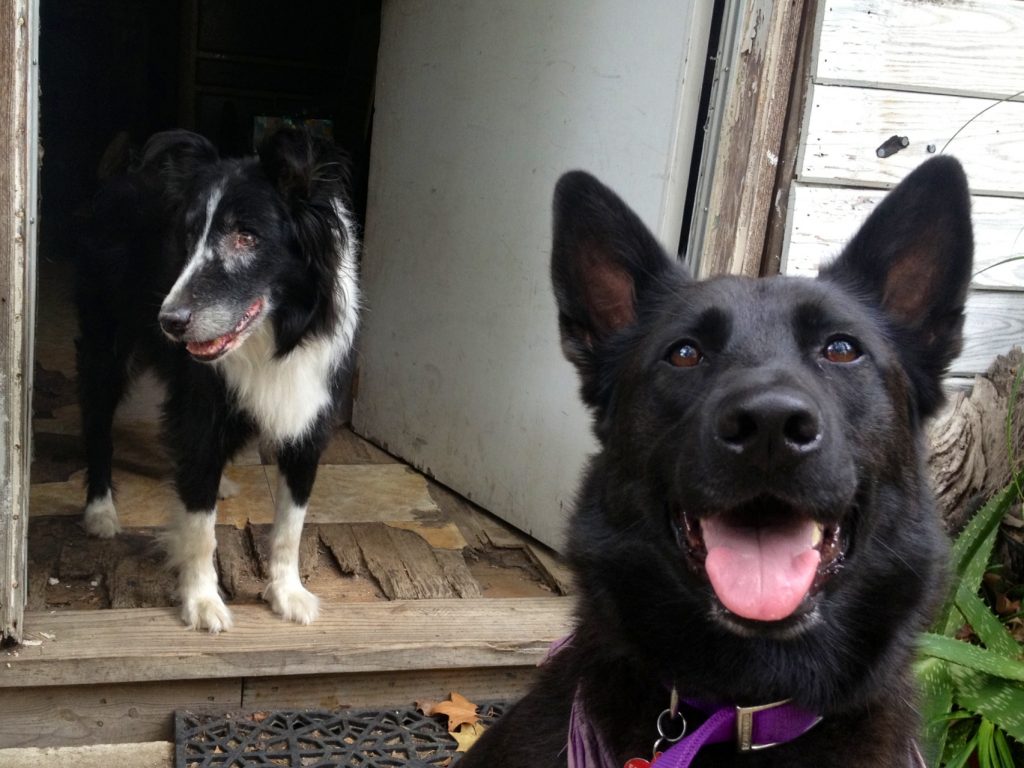
THELONIOUS AND GRRIZELDA, BACK IN THE DAY

After Thelonious died, I wanted to find a buddy for Grrizelda, and adopted Miss Moon, a rambunctious 3-legged white German Shepherd, and then a few years after that, Mister Snowy came to live with us, too. I was always more of cat person, growing up – but after losing my beloved familiar Junior (an extremely majestic and wondrous kitty who had my heart from age five until 21 years later), I think it took some powerful dog magic to support me on the road ahead. I’ve been blessed with delightfully naughty cats in my life since then (Rusty Jack Knife, Lowkey, and Shrimp Scampi) but somehow along the way, I became a dedicated dog person, and will likely remain that way. I never imagined that I’d have one dog, let alone 3 big rambunctious dogs at the same time, but they have kept me going and protected me in so many ways, and I’m so eternally grateful that we found one another.

I found a dream I had written down years ago where I was running through the woods with my black and white wolf pack. This was long before I ever thought I would want to have dogs in my lift, but I never forgot that dream – even if I didn’t know what it meant at the time.
Moon & Grrizelda became my magic yin yang twins – keepers of my heart. And eventually Snowy came to tilt the balance towards the light. Now I just have my two very fluffy wild white dogs, and can rarely wear dark clothing without being completely coated in fur!

My girls and I enjoying the Lone Grove springtime.
There are countless wild stories from those 12 years, and our many adventures together, but I want to share a bit about how I came to find this glorious black wolfy girl that both changed and saved my life.
Here are a few original posts I wrote when she first came home to be my special girl:
DOG DAYS

Grrizelda was roughly six months old when she was picked up by Animal Control, wandering the backroads of the Hill Country with her then partner in crime, a yellow dog with stumpy legs named Murray. It was hard to imagine who would let go of a gorgeous dog like this, who looked to be quite possibly a purebred Black German Shepherd. We ran across breeders occasionally who pointed out how much she looked like what they call “Lacquer Blacks” because of the reflective quality of their coats. Grrizelda was a bit of wild pup, with a lot of separation anxiety, and had some issues with chewing up things (like my brassieres, some dolls, furniture, etc.) when she was stressed out.

At one point, her separation anxiety got so intense, she was busting out of her metal crate, and damaging her teeth on the bars. I contacted an animal communicator to see if she could help, and during our session, she told me that Grrizelda had gotten separated from her people in a fire, and that it really freaked her out to not know where they were. I noticed that any kind of fire (even small campfires) always made her very nervous, and she was also terrified of fireworks, gunshots, and thunderstorms.

Years after Grrizzle seemed to have gotten over the worst of her anxiety issues, and we’d gotten rid of her kennel, I took her with me out to West Texas when I was hired to read tarot at the Trans-Pecos music festival at El Cosmico. She had recently recovered from a near death experience after ingesting a wasp, and I wanted to keep her near me. I remember how she would skirt away from the little campfires on her leash, pulling me the long way around them. After the festival, we booked a room at the Eleven Inn, a sweet little motor court motel down the road from Balmorhea, a glorious spring fed swimming hole. I thought Grrizelda would be so worn out from all the excitement of the festival that she’d be grateful for a little peace and quiet, and would just conk out and rest while we went for a swim… Unfortunately, this was not the case. Though it had been ages since she’d done anything destructive in her anxiety, this strange location must’ve been just too much for her. I felt so terrible when I discovered that she had pulled some major rock star moves on our little hotel room – and reduced the nice wooden venetian blinds to splinters in her frantic efforts to escape out the window and come find me. Luckily, the hotel owners were accepting of reimbursement for the blinds (though not cheap!) and I never left her alone away from home ever again.

We had a really scary near death experience back in 2015. The morning Grrizelda almost died from eating a wasp, I remember waking up around 7:30am because Moon was ringing the little bells I have on the door – she’s trained to ring them when she wants to go outside to pee. Thank goodness she did, because anaphylactic shock sets in within an hour, and whatever caused this near-tragedy was something in the bedroom, around dawn. I am pretty certain Grrizzle ate a wasp, because multiple stings would have elicited some hearty yelps, I reckon. Wasps get in the bedroom sometimes, and Grizzelda was a bug-biter housefly-huntress extraordinaire (a habit it proved impossible to train her out of!)
Normally she slept on her bed, or in the far dark corner of the room, but that morning I nearly tripped over her, because she was laying right next to the bed, on the floor, closest to me. She usually only did this when she was very frightened, of a storm, or late-night fireworks. I let Moon out, but Grrizelda didn’t stir. When I asked her if she wanted to go out, she struggled to get up, and then started vomiting. My dogs barf occasionally when they eat something they shouldn’t have – so that part didn’t really concern me… But something just wasn’t right – she was having trouble moving, and it was just very obvious that she felt like hell. She could barely stand up, and when she tried, her legs were trembling and shaking. My mind went from dead asleep into panic mode. I threw on my clothes from the day before, grabbed my purse and keys in such a rush I neglected to pluck my phone off the charger. I had to heft and carry 60 lbs. of dead weight dying dog out of the house and into the car – and later into the emergency vet.
On the way there, I struggled to stay calm and focus on the road with Grrizelda’s head in my lap, her breathing labored and her limbs already feeling cold and heavy. I was so scared she was going to die on the way there. Once we arrived and got into an exam room to wait for what felt like forever, I noticed that she looked kind of swollen. She had perked up slightly, but seemed agitated and started shaking her head and rubbing at her ears. Luckily, when we finally got seen and got some bloodwork, it was pretty clear from the way her system was reacting and crashing that she was having a severe allergic reaction. They took her to the back and started trying to get her to safe levels. That wasn’t effective, unfortunately, so they had to give her a plasma transfusion to flush her system, which luckily she didn’t have an adverse reaction to. It was so hard having to leave without her, knowing she was going to be at the vet’s office in a kennel without me. I was so grateful to the vets and team at the emergency clinic who absolutely saved my bestie’s life that week, and all the friends who were so supportive and kind during that time. I still have a long list of thank you cards I need to send, and it weighs on me constantly that I just haven’t been able to do the damn thing and get them in the mail.

Sometimes it feels like life is just a series of never-ending stressors and calamities, and that I never really catch up or recover from any of it (but that’s likely a combination of my neurodivergence and living through the fall of late-stage capitalism, climate collapse, and now a seemingly never-ending pandemic, in real time. Though it might not seem like it from these stories about all the near-death experiences and mishaps, one of the things that has been so hard about losing Grrizelda is that for the majority of those 12 years we had together, she was just so easy. She was such a good girl. Really, just a perfect dog – to the point that I really didn’t understand what a handful other dogs could be, and was really unprepared for what hot messes Moon and Snowy turned out to be. Though of course I love them both madly, they often really TRY me with their stubbornness and antics!
They are like my little white cloud-clown children – always getting into trouble, and needing a lot of help and attention. Grrizelda really was so much more than a dog – she was an equal, and in many ways, my partner, co-parent to this wild wolf pack, and I’m realizing now, the love of my life. I saw a prompt online recently, asking who are/were the great loves of your life – and I realized that I look back on most of my romantic relationships with some degree of sourness and regret, which made me really sad to contemplate. Grrizelda obviously wasn’t my romantic partner (I’m pretty kinky, but definitely draw a line around bestiality!), but man – I don’t know if I’ve ever been loved so unconditionally by any other being, the way I knew she loved me. Losing that sense of security, stability, and safety when she died has been completely destabilizing. She was my anchor, my rock. I could count on her to be calm, aware, tuned in, and – to let me need her maybe a little bit more than she needed me.
I didn’t have to constantly worry about her – until I did. Then she got sick, and it all came crashing down on us, too fast. She was in so much agony, and getting her to eat enough to take her meds was such a torture for both of us. Putting her through chemo in hopes it would help her, and possibly give us a little more time brought back a lot of really difficult memories around my mother’s cancer treatment. It’s one of the worst feelings in the world – seeing the being that you most need to be okay and healthy (so that they can keep taking care of you) wasting away before your eyes, and feeling like your survival is inherently tied to theirs. So it makes sense that it feels like a big piece of me died when she did.

Out on the pink granite in Lone Grove
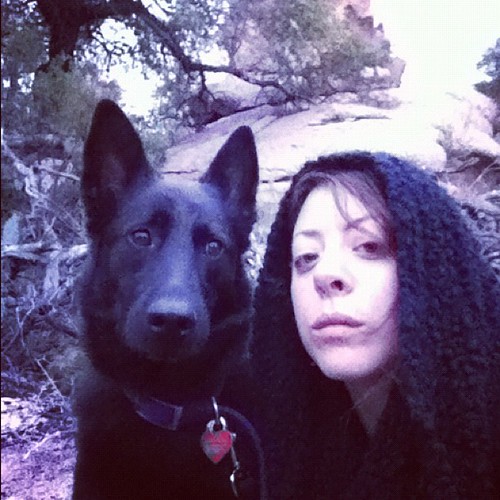
When I say that Grrizelda saved my life many times, it’s not an exaggeration – she kept me going emotionally, in my darkest moments, and protected me from making foolish choices in the wilderness that likely would have led to my demise – during a time of great pain and loss, after the relationship that brought her into my life ended.
I wrote about our misadventures atop Enchanted Rock here:
Grrizelda was my protector. Having her with me was very healing for my C-PTSD around intruders, because I knew that she would never let anyone harm me. My Aunt Ruth would come pet-sit for me sometimes, and would often watch how the dogs responded to perceived threats. Moon has always been a lot of bluster and loud bark, but Grrizelda would watch silently, growling low in her belly – and Ruthie believed that if it ever came down to it, Grrizzle would kill any person who attempted to hurt me. I believe that, too.

DARK BATTLE – photo of Grrizelda with Adrian by Katie Cowart
The name Grrizelda means “dark battle”, which felt very apt for my beloved black warrior princess dog, though her battles were all fairly gentle. She was black smoke in the shape of a dog, my shadow queen. I was so amazed when I saw this photograph of her with my friend Adrian, in full dark elf battle regalia (or as Hades, the King of the Underworld, himself) – taken by Katie Cowart, who used to take care of the dogs when I would travel. It felt like such an embodiment of the spirit I saw in her sometimes – that fiercely loyal aspect that would fight to protect what she loved – even to the death.
Oh, if I had Orpheus’ voice and poetry
with which to move the Dark Maid and her Lord,
I’d call you back, dear love, from the world below.
I’d go down there for you. Charon or the grim
King’s dog could not prevent me then
from carrying you up into the fields of light.
– Euripides
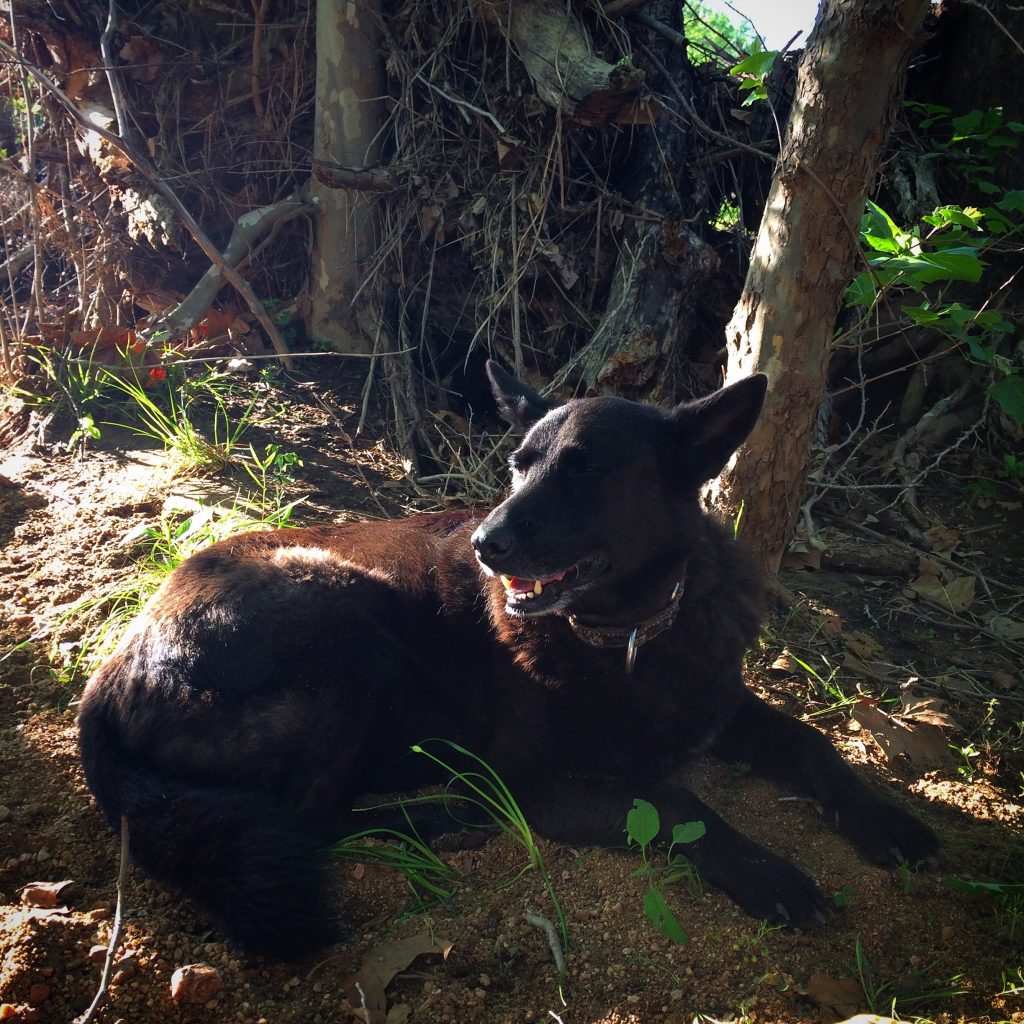
I miss her rich black silk fur, silvery on her haunches like she sat down in powdered sugar and dusted her bloomers. Her coat had so many colors in it – really just one of the most gorgeous canines ever. She was my shadow, and without her I feel as lost as Peter Pan did, crying while trying to sew his shadow back onto to his foot. It just doesn’t work that way. Who am I without my shadow self? She was the first dog that was ever truly mine. Really, we belonged to each other, utterly and completely. I was her person.
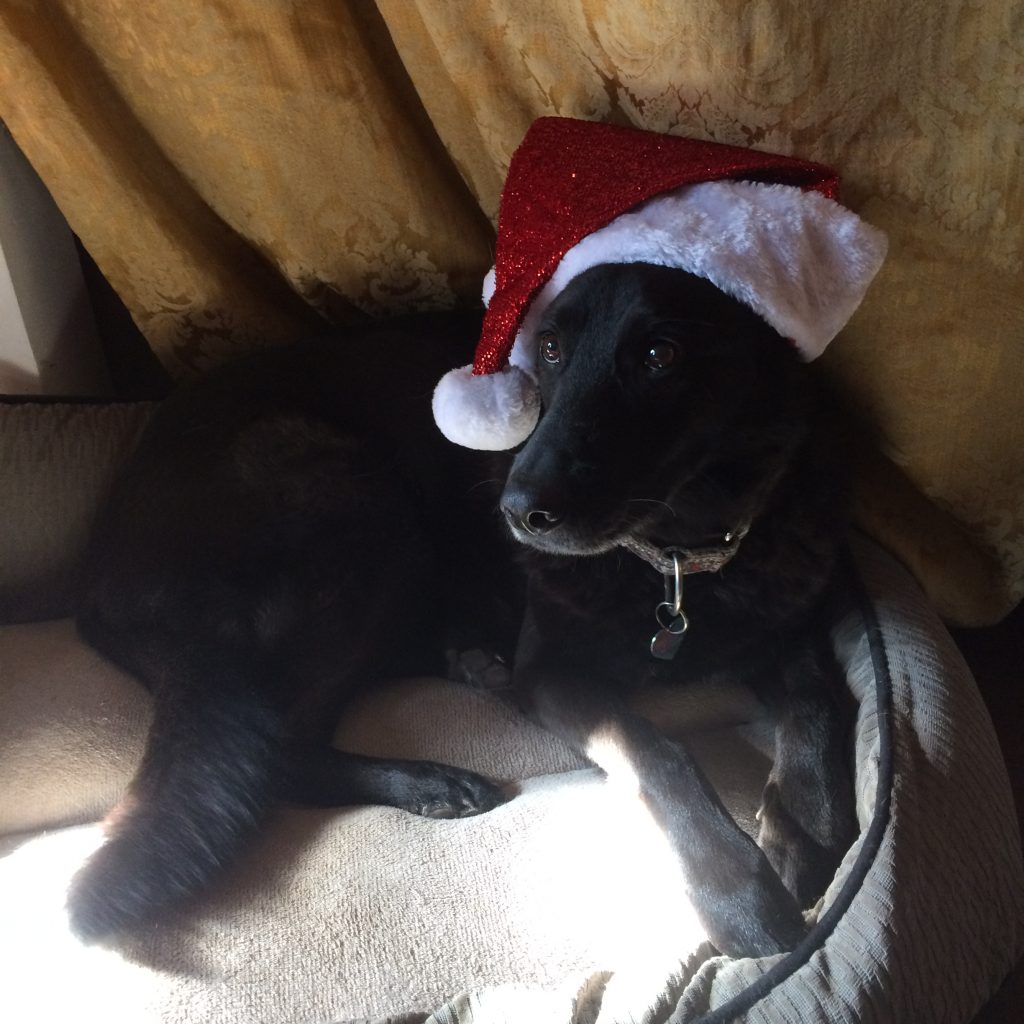
PATIENT GRRIZELDA – THE GOODEST GIRL
There was a book of fairytales I loved as a child (I have it still, Idries Shah’s World Tales) that had a story in it about Patient Grizelda, a lovely but put-upon woman who endured all manner of trials and tribulations from her rich merchant husband without ever uttering any kind of protest. Looking back now, it’s not a very feminist folk tale (though luckily I was provided with plenty of those as a child, too) – but it was definitely the first place I’d ever seen the name Grizelda, which I took a shine to. I think about how calmly my Grrizelda put up with me dressing her up in all kinds of hats, wigs, clothing and various costumes (at least for a few moments), as well as baths, brushing (even tooth-brushing!) and all manner of hot-spot ointments and dreaded foot inspecting – and, goddamn…I just wish I could embody more of her incredible patient and giving nature. Patience has never been one my virtues, but I try to emulate all the things I admired most about my dog (along with unconditional love, loyalty, and an exceedingly kind heart), so I can be closer to the person she believed me to be.


Here we are loving on each other when we were just puppies – when her snoot was short, and we wore the same green sweater.

She was an incredibly intelligent dog, and seemed to understand the English language pretty perfectly – including commands like “no begging”, when her big brown puppy dog eyes would be respectfully averted after longing for whatever tantalizing thing I was eating, or “nice to meet you” – always polite, with excellent manners, she would shake hands. My Aunt Ruth taught her not only “Squirrel!” but “SUPER SQUIRREL!” which would always elicit much excitement and frantic yips and whines, as she pursued her nemesis out in the yard.
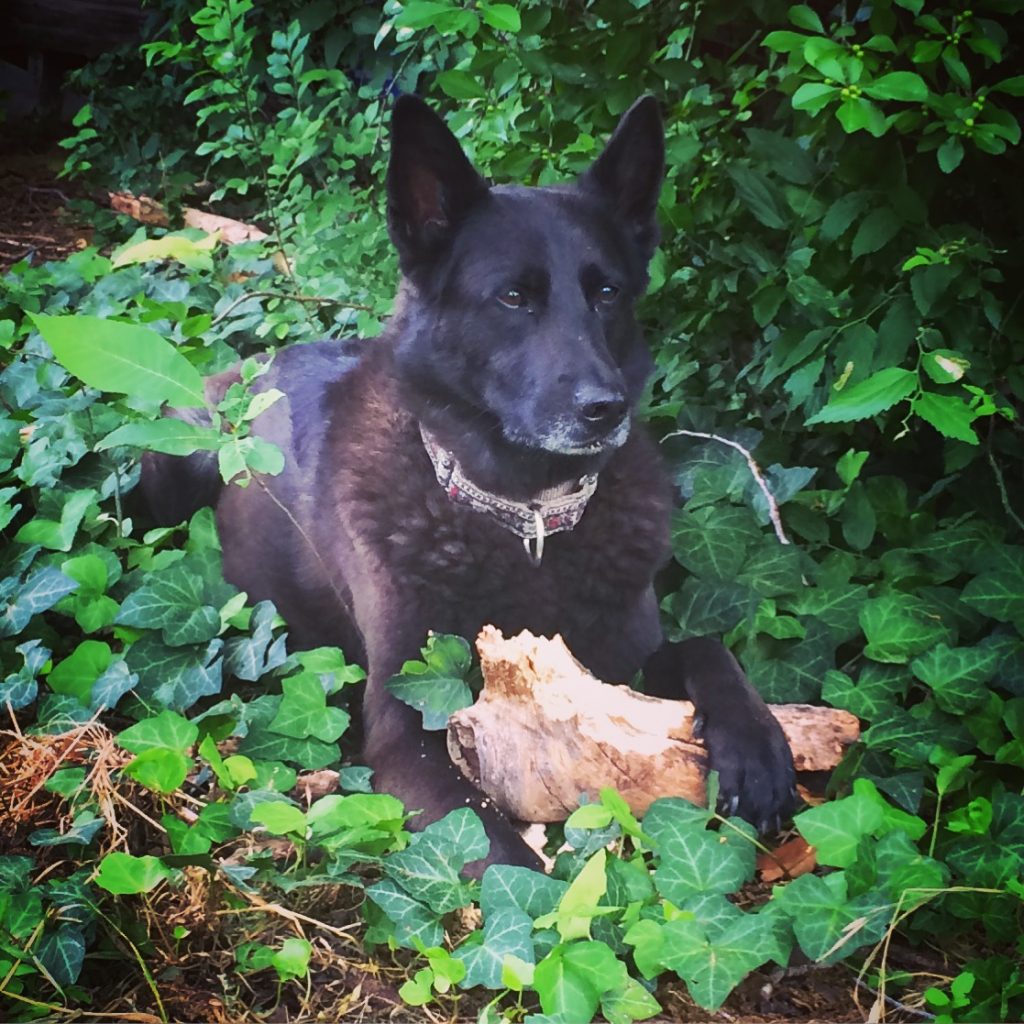
Grrizelda was an excellent communicator. I knew what she was trying to tell me by the different cadences of her bark, and she rarely barked loudly without good reason. Usually it was a soft whuff of concern, but I could tell whether she was vocalizing about a nocturnal varmint nosing around outside, at other dogs in the neighborhood, or whether the issue was human related. She learned to howl from Snowy, and enjoyed the singing sessions our little choir pack of three would emit with great enthusiasm every time an ambulance or fire truck would go by (which is often, on my street).
“Listen to them, the children of the night – what music they make!”

Grrizelda and Shrimp Scampi. They had a very special friendship, and were always snuggling whenever they got the chance.
Grrizelda was always very gentle with children and kitties, patiently enduring their attentions – even when she hated it. But when it came to wild creatures in her domain – she was a mighty huntress. Her lupine instincts would often take over when it came to squirrels, possums, once a giant raccoon, and unfortunately – a pair of adorable ducklings she thrashed to death. She always seemed a bit surprised after they stopped moving – like she’d broken the toy she’d had so much fun playing with, and now might be in trouble.
She didn’t much enjoy fetch, and ducked out of the way in terror when frisbees came flying – but loved stealing and hiding Moon’s toys, and of course finding a good stick to decimate into splinters. Her favorite game to play with other dogs was “Dominate me Daddy!”, in which Grrizelda was always Daddy – and would chase the naughty babies around until they submitted at her feet, showing their bellies in delighted submission as she play growled and nuzzled their necks. Grrizelda always had immediate seniority, which she sometimes wore uncomfortably. It was always a bit of power struggle, and I think it wore her out sometimes, to always be tested, and have to prove her status by trouncing the other dogs soundly. But since they never play that game anymore without her here, I know they miss getting bossed around by their big sister.
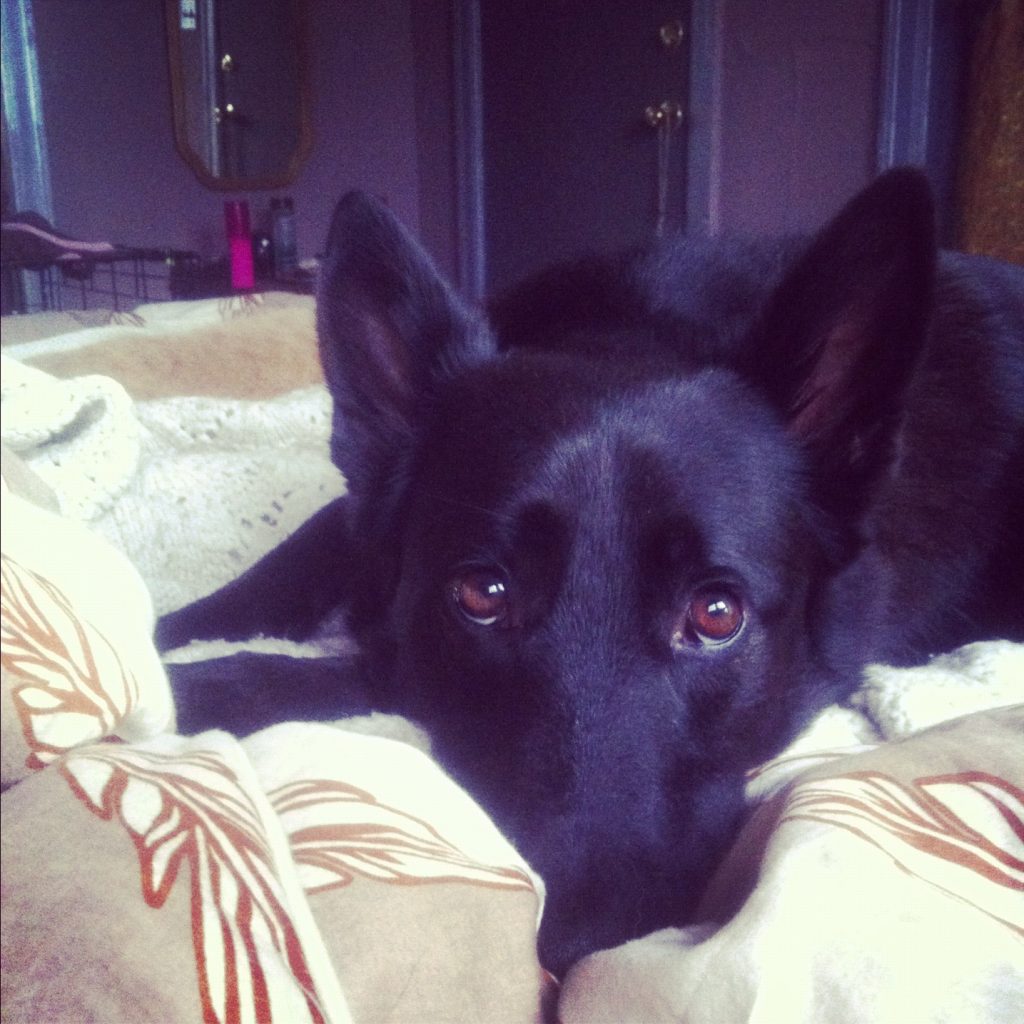
I miss the depths of her gaze, and telling her how much I love her and hearing the steady whump-whump-whump of her tail wagging a morse code “I love you too”, in response.
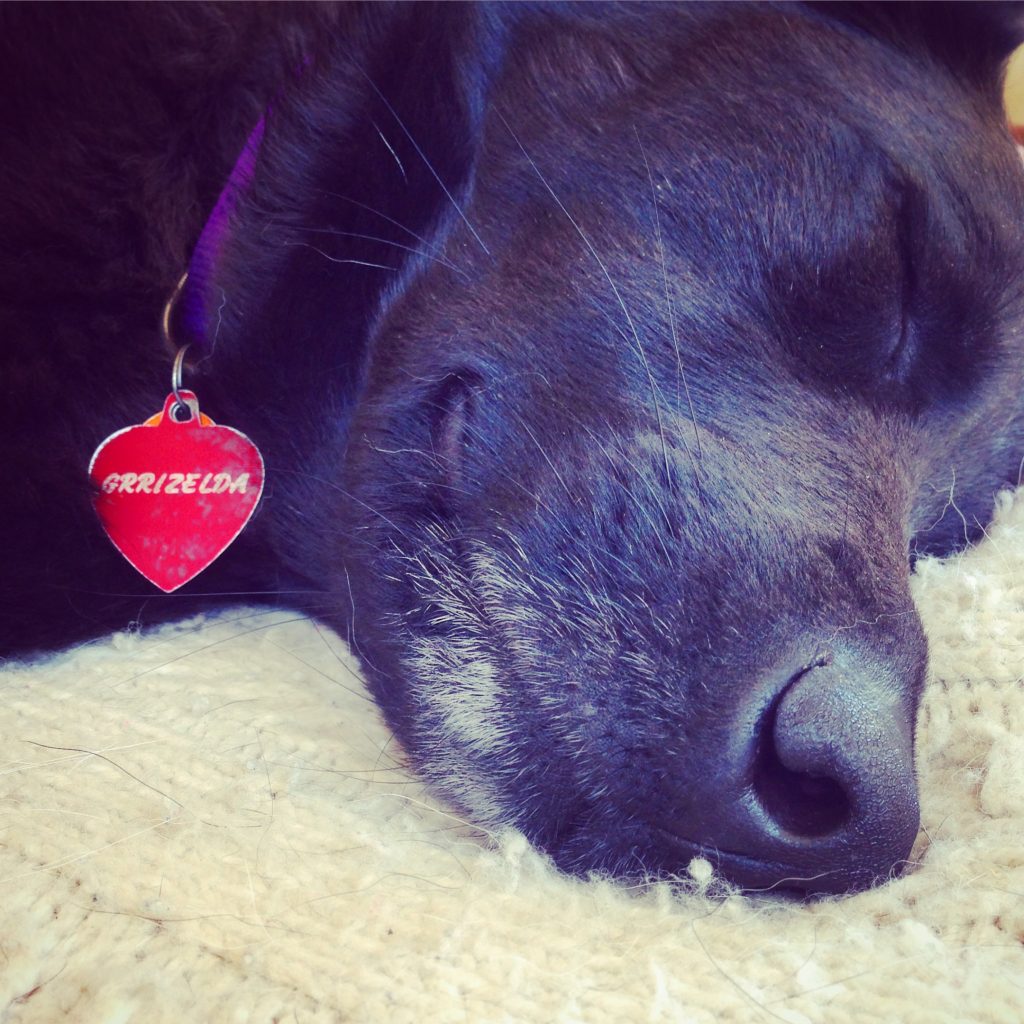
I miss taking naps with her, and skritching her little whitening chinny-chin-chin and how her nostril was a perfect apostrophe.
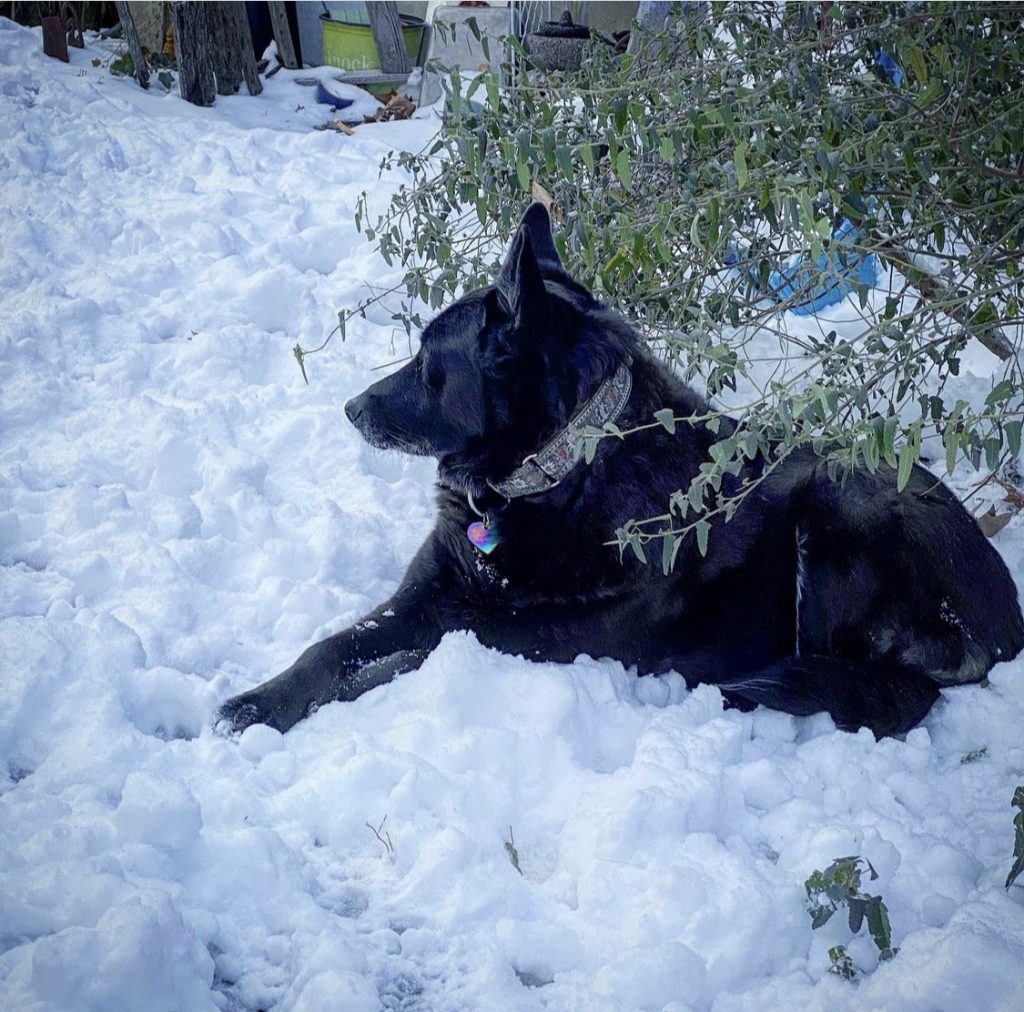
These photos were taken during the snowstorm, days before I found out how sick she was. At that time, I was blissfully ignorant, thinking she had a bad tooth that was hurting her, and after the roads thawed out and the power came back on, I’d take her in to have it pulled. I was preoccupied with the trauma of the snowpocalypse, and at that moment, couldn’t imagine things getting much worse. Until they did.

Grrizelda didn’t really adore frolicking in the snow as much as my other pups did, but it was so wonderful watching her explore this novel substance, with snowflakes on her velvety nose, and her sleek blackness like a moving tentatively like a sweet shadow through all that pale sparkle.

Here she is as a young spry and playful critter, from the occasion of her first scant snowfall (which is still rare for us down here in Texas.) I’m treasuring these memories I have from our 12 years together. I had just hoped we’d have time for at least a few more.
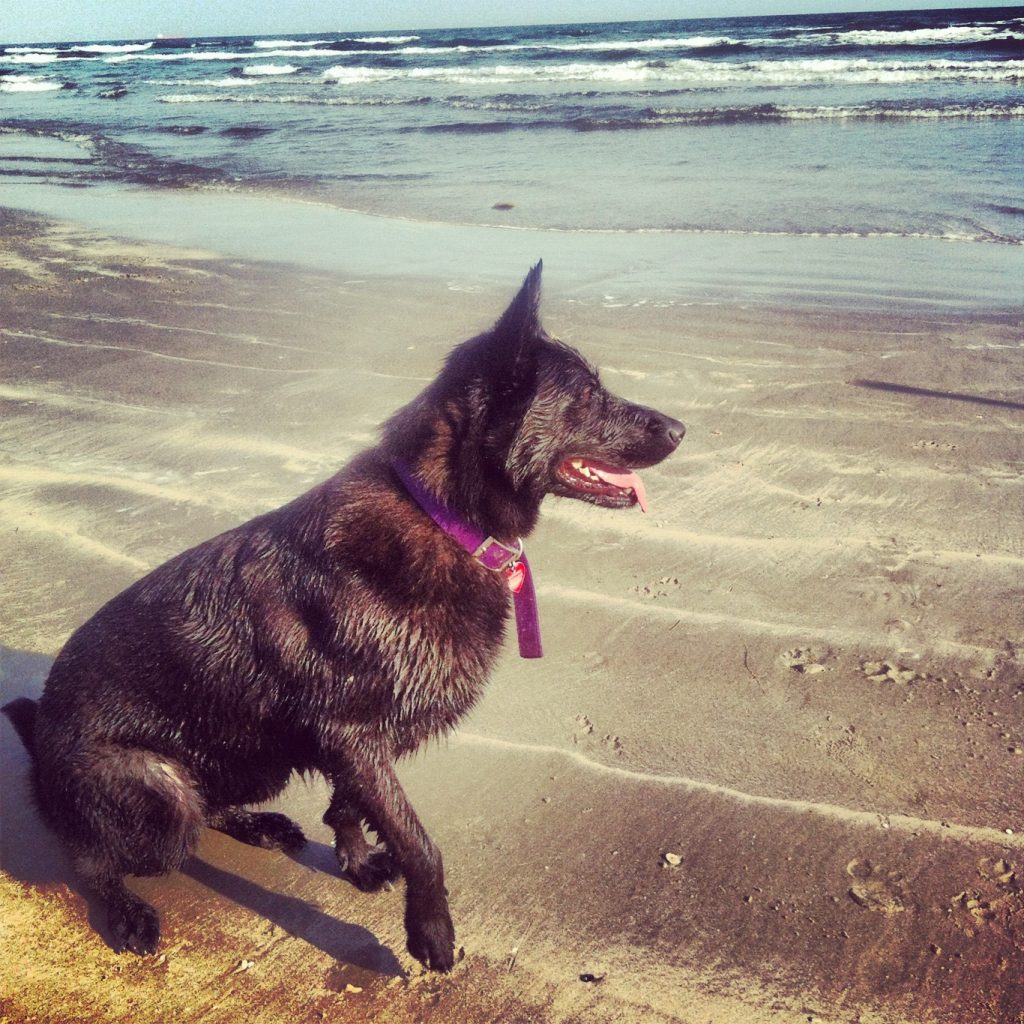
I miss her perfect delicate starfish paws, really just the prettiest feet I’ve ever seen on a dog – and I miss how prissy she was. She didn’t like to get muddy and dirty (like some dogs do, MOON!), or be wet, for the most part. She would swim, but usually only out of concern for me – because if I was in the water, she’d be worried that I was drowning, and swim out to try and come save me. She got to run on the beach at the Gulf Coast a few times, which she loved. There’s a crazy story about her and Moon gulping too much saltwater and having intense diarrhea and vomiting that I had to clean up while I was under the influence of strong psychedelics that I won’t recount in detail here, but trust me when I say that it was GNARLY.

Neville and Grrizelda – photo by Justin Wilson
I miss getting to see her frolic with her best friend Neville, who very conveniently happened to be the canine companion of my best friend, Allyson. They were such a good team, and loved getting to hang out together – and it felt really special to have our friendships be so much in alignment. I know he misses her a lot, and I hope they’ll be able to find one another one day, on the other side of the rainbow bridge.
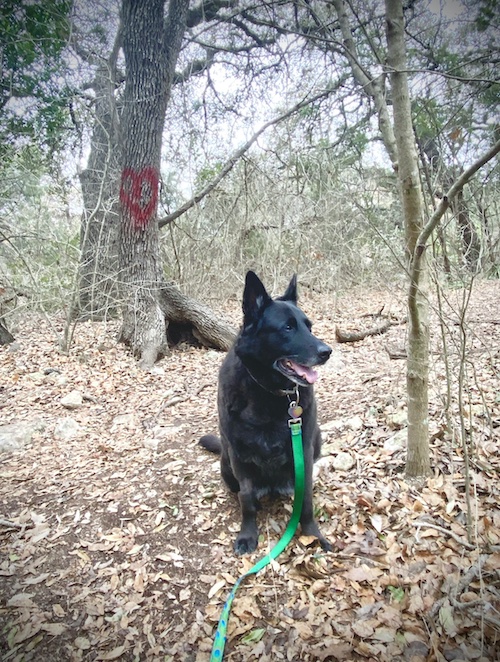
Grrizelda kind of hated car rides, but really liked getting to go places (once she got there). She was perfect on a leash, got along with other dogs, and all people (unless they had bad intentions towards me) and loved going for long walks and rambles in the woods – taking time to deeply sniff all the interesting things she found on our adventures.
When we learned that she had cancer, I was taking her out to the oncology specialist in West Austin weekly for her treatments and monitoring her melanoma. Bull Creek Park is out that way, and we’d always stop for barbecue and sit by the water eating brisket. This image is from one of those hard, cold days – my heart beast sitting near the heart tree. Knowing her days were numbered, and just trying to give her every bit of joy that I could. The chemo was affecting her appetite, and her sense of smell and taste, so she wanted stinky,fatty things. She loved eating liver pate, and rotisserie chicken – but towards the end, she stopped wanting to eat anything. Not cheese, or foie gras, not the tilapia, sweet potato, and rice mush we were making for her. That’s how I knew it was time, and when I realized it, I kind of lost my mind. I wanted to destroy everything. I wanted to die with her.

Receiving that terrible news about Grrizelda’s cancer just shook me. It was so completely unexpected, so inconceivable that the sweetest, wisest, most sage dog I’ve ever known could just…suddenly be dying, and that nothing could really be done to stop it. It all happened so fucking fast – from getting that awful diagnosis to having to make the excruciating decision to put her down barely a month later. It just felt so incredibly cruel.
She had an aggressive and advanced form of melanoma in the back of her mouth, that had spread to her lungs. Surgery would have been too invasive and would require removing too much of her beautiful face. We were recommended palliative care, and some chemotherapy, in hopes that it could slow the spread, and help her be more comfortable. We were told we were looking at a handful of months (between one and four) left together, if we were lucky – but it ended up being all over in just a few short weeks.
Right after first hearing this horrible information, I sat wailing in my car while Grrizzle was inside the animal hospital getting her first chemotherapy dose. It killed me to not be able to be in there with her, comforting her – but because of Covid, I had to let her get with a vet tech, and then wait in the parking lot for hours, losing my mind. That afternoon, I got into an altercation with a horrible woman, as we were trying to finally leave the vets and go home. The bitter, miserable lady parked next to me started screaming in my face with no mask on, waving a big honking diamond ring in my face – all because my car door briefly touched her car (there was no mark, no scratch, nothing) as I was lifting Grrizelda into the seat (because she couldn’t hop in on her own anymore). She scared Grrizelda, and I very nearly did something I could have been arrested for. It took everything in me not to utterly destroy that woman in that moment – but I made myself just walk away, fucking shaking with fury. I’m proud that I was able to restrain myself from responding to that ugliness with more ugliness, but mainly I knew that I couldn’t end up in jail when my dog needed me so much. It was just trauma on top of trauma on top of sorrow on top of overwhelm – all too much. My heart and my nervous system still haven’t recovered from all of it.
I was completely gutted. I’ve never howled in rage and pain like that – just laying on the floor screaming my throat raw, uncontrollably sobbing until I exhausted myself. I know it upset Grrizelda to see me like that, but at that point, we couldn’t protect each other from any of it, anymore.
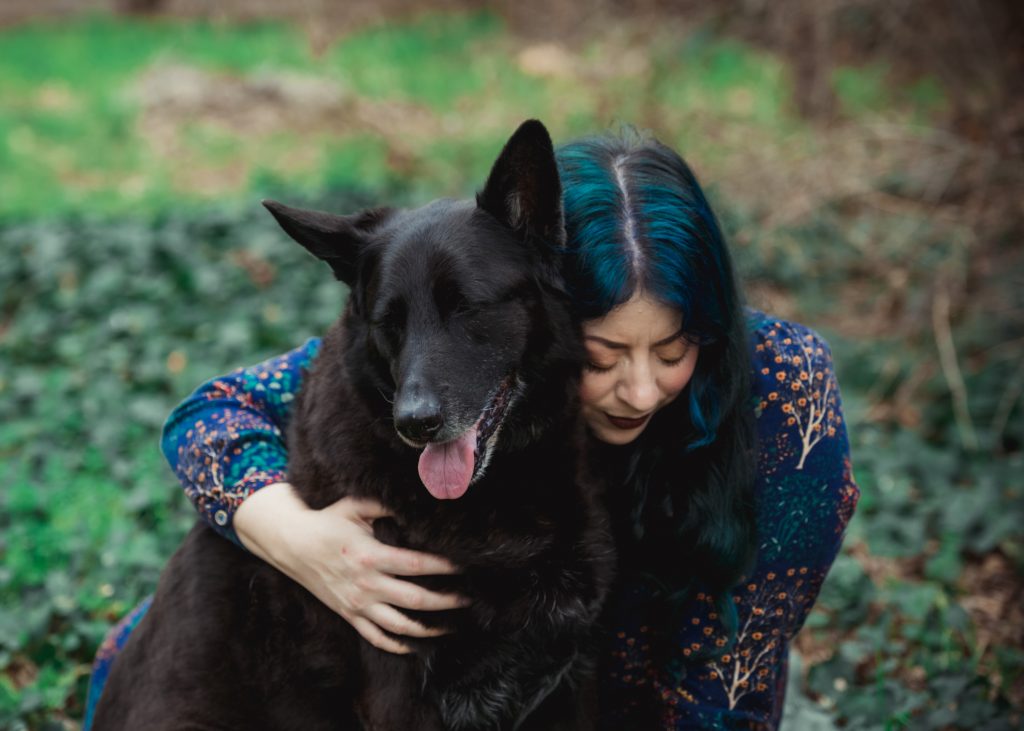
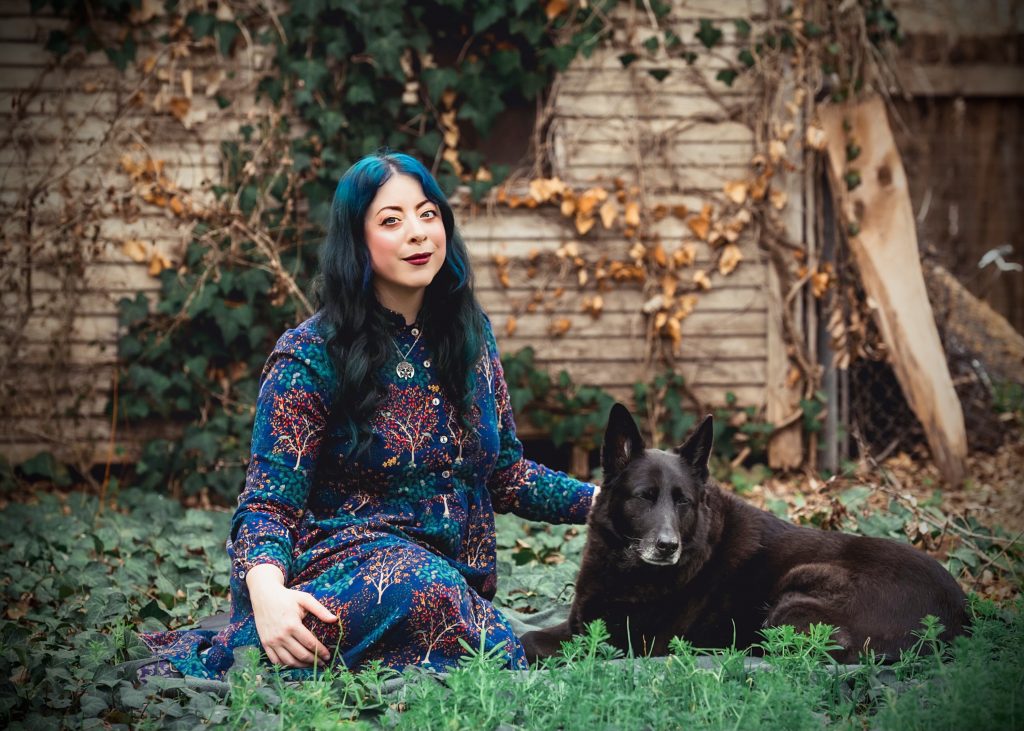
“The work of the mature person is to carry grief in one hand and gratitude in the other and to be stretched large by them. How much sorrow can I hold? That’s how much gratitude I can give. If I carry only grief, I’ll bend toward cynicism and despair. If I have only gratitude, I’ll become saccharine and won’t develop much compassion for other people’s suffering. Grief keeps the heart fluid and soft, which helps make compassion possible.”
~ The Wild Edge of Sorrow: Rituals of Renewal and the Sacred Work of Grief
by Francis Weller
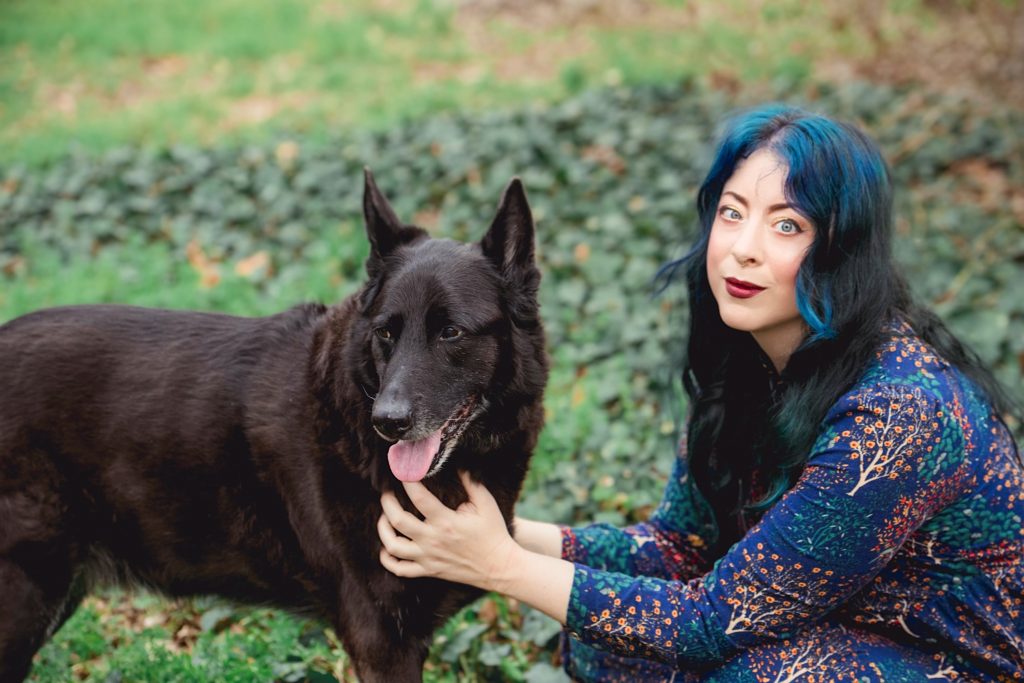
In the weeks before Grrizelda died, I spent a lot of time telling her thank you – in between being wracked with sobs, and sometimes during, I would pet her velvety soft black ears and whisper my gratitudes to her for being such a loving and loyal companion, for so long. For loving me so unconditionally. For protecting me and helping me feel safe, when I didn’t feel safe for such a long time. For bringing me cheer and laughter when I felt sad, and for giving me the best dog kisses ever.

TRUE LOVE
I’m so grateful for these beautiful portraits we had made before she passed, taken by two dear friends of mine, who happen to be brilliant photographers. Katie Cowart took the ones where I’m wearing the black dress, and Erica Rich took the ones of me and Grrizzle where I’m wearing the blue dress.
A year and change later, I’m still deep in my grieving process over this massive and quite sudden loss, and there’s still so much to muddle through, emotionally – so I’m giving myself lots of time to just feel it all, and not pressuring myself to be okay or “over it” anytime soon. Our death-denying culture rushes through and past grief and treats it as a temporary state, rather than an ongoing experience. I bought several books on grief at the beginning of the pandemic, in preparing myself for loss in this mass death event where millions of lives have been lost to Covid-19.
I wasn’t expecting my closest losses to be two of my beloved animal companions, who kept me feeling so held during this endlessly long time of isolation. I’m immensely grateful that my parents and elders are still with us (and all vaccinated and boosted now!) and my friends, too. I was so worried about their health and well being all during this terrifying pandemic that just goes on and on.
I’ve been very grateful to have some guidance from these authors in this time of loss – especially from Francis Weller’s Wild Edge of Sorrow, which has been a huge comfort. This book has been reminding me to hold the grief and the gratitude together – and that has been making a huge difference in my process – as I let these big waves of emotion wash over me, and give thanks for the privilege of loving so deeply, and being loved so purely.
Most of all, I am thanking Grrizelda, over and over again – for all the adventures we had, for loving me so deeply and for so long, for teaching me, guiding me, and protecting me. For giving me the best puppy kisses, and for being the most incredible canine companion ever. All I want in this life is to be worthy of her adoration, and to prove myself to be half as good as she thought I was.

This is the last photo of her alive in her body, in the spot where she left it.
To have to willingly choose to end your most beloved companion’s life is the most agonizing decision – but it is also the most loving thing you can do for them, when it’s time. It was traumatizing for both of us to experience what she was going through in those last days and awful nights. The nights were the worst. As her tumor-ridden lungs started filling up with fluid, her breathing became more and more labored, and she was panting with pain – and then she started having seizures that would take hold of her body and make it thrash. I remember my mother having seizures towards the end of her battle with cancer, and I knew she couldn’t take much more. The last thing I wanted was to say goodbye to her, and though I knew how much she hated to be leaving me, it was truly an act of kindness to let her go. To make her stay longer would be incredibly selfish, and just cruel.
I had a friend at the time who wanted to know why she had to be put down, and why I couldn’t just “let her die naturally” – and I had to tell her that there’s nothing “natural” about unnecessarily prolonging the suffering of someone you love, just so you can have more time, or so you can say you let “nature take its course”. I’m not close with that person any longer, for other reasons – but this comment sure didn’t help. Making that choice is hard enough without questions like that – and there will always be guilt involved, even when you know you did the right thing, at the right time.
In the weeks leading up to Grrizelda’s death, I had the great blessing of receiving some animal communication sessions from my friend Lulia of Blue Oracle (a gifted psychic), who what food she was preferring (after chemotherapy messed with her appetite/sense of taste), how she was feeling pain-wise, and when she needed to leave this plane of existence. That last part was really huge for me, because even though I knew that timeframe might shift, it still gave me a space where I could try to mentally prepare myself, and also block off a window of time to get things ready for grieving and for her passage, death, and burial. I had to make sure that I wouldn’t be working in the days preceding or after to give myself time to fall apart – which was tricky, because I tend to book with readings up pretty far in advance (something I’m so grateful for!)
Grrizelda told Lulia that it would be around the Vernal Equinox, and sure enough – the Eve of the Equinox was her time to go. Charity made herself available for us during the time of Grrizzle’s passing, and was able to transmit a vision of the Night Goddess Hecate coming in a batwing headdress to escort Grrizelda through a spider web rainbow crystal portal, with wolves and night-creatures attending. Lulia didn’t know about my and Grrizelda’s deep devotion to Hecate, so that was really wonderful to hear, and such a balm to my heart.
Hecate rules the crossroads, the liminal places and times, and the underworld. Dogs, wolves and bats, as well as all nocturnal creatures and creepy-crawlies are sacred to her, and under her protection. Knowing that she is with our patron goddess brings some peace to my heart, and being able to feel like we could communicate during this last brutal month when she was hurting so much, but unable to speak was just… an immense blessing. We’d had so many past life connections together – she was my horse, my dragon, and my little baby fruit-bat – and I think that we were mother and daughter elephants together once. Hearing details about our deep soul connection over many lifetimes opened up my heart to waves of pure love and profound emotion, and allowed me to feel more acceptance about trusting that it really was her time to go, but that we would be reunited again one day, in this life, or the next – and beyond.
When the day came, we fed her salmon and scrambled eggs and gave her so many pets and kisses. She and I were encircled by a small group of dear friends who loved her very much. She seemed so spry and happy in the yard with us, and it so hard to not just change my mind and call it off, but I knew I couldn’t do that (as much as I wanted to). We laid out a place near the grave that had already been dug for her, but it was too bright and sunny – it was a bit hot that day, and she kept not wanting to lay down there. The spot she chose for herself was one of her favorites – in the shade, underneath the lacebark elm, one of the first trees to leaf out in the springtime.
She was smiling, surrounded by purple spiderworts, in the exact shade of violet that I’ve always associated with her. Her wrists and belly had been shaved for the constant IVs and to suck the fluid from her lungs. When it came time to give her the injections, I had hoped it would be easy – but it was a brutal torture, for her, and for all of us witnessing. It took way too long, and I hate to admit that it wasn’t a gentle death. She was terrified, even though I was holding her, and in so much pain. We want death to be this beautiful process, but all too often, even we do everything we can to make it otherwise, it is difficult, frightening, and ugly. When she finally let go, it felt like a blessing. I cradled her limp body in my lap for a long, long time, whispering goodbyes to my queen.

Then it was time to place her body in the old black wheelbarrow, to carry her to her grave and cover her with flowers. We brought Snowy and Moon out to say goodbye, but they had already said goodbye the night before (Grrizelda let Moon snuggle with her for a long time, which she normally would rarely tolerate) and when they saw her body, they sniffed it briefly, realized she wasn’t in there anymore – and hopped over her like she was a log in the path. The animals know. Being able to be with her body after she’d flown helped me know too, though. I sat for a long time and watched her beautiful, soulful chocolatey eyes almost immediately turn milky and blue, as cobwebbed craquelure spreading over their surface.
As much as I hated to relinquish her soft fur and sweet paws to the earth, I couldn’t keep her with me any longer. She was gone, and what she left behind, we garlanded with blossoms, dusted with lye, and prepared her to become one with everything else – to become nourishment for the creatures of the soil. I’d lay awake and night and think about her out there, under the shovelfuls of rich black dirt, alone in the dark, turning to bones. I wanted to stretch myself out on her grave and sleep with her there – but what comfort would it really bring? At least she is buried next to her brother Thelonious, and with Lowkey and Rusty Jack Knife. My pet cemetery just keeps growing, sadly.
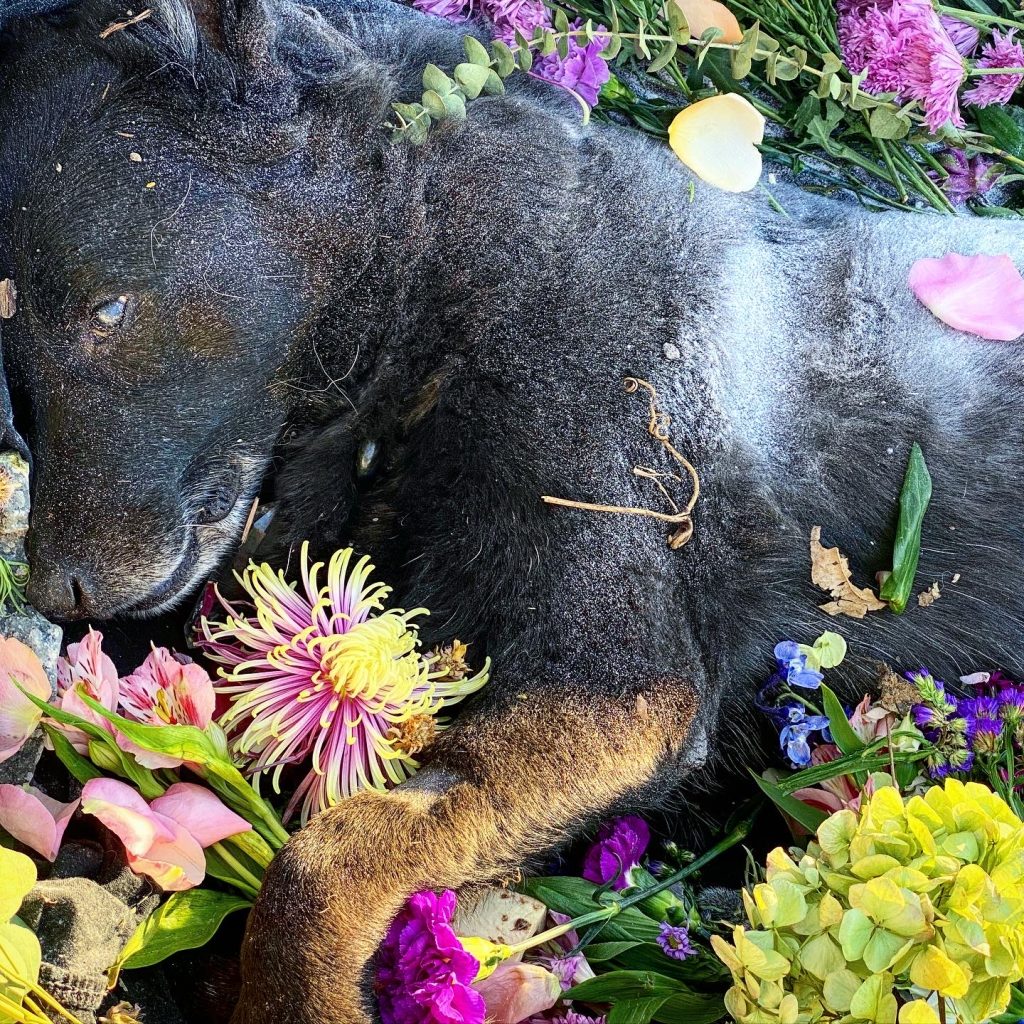
“to live in this world
you must be able
to do three things
to love what is mortal;
to hold it
against your bones knowing
your own life depends on it;
and, when the time comes to let it go,
to let it go…”
– Mary Oliver
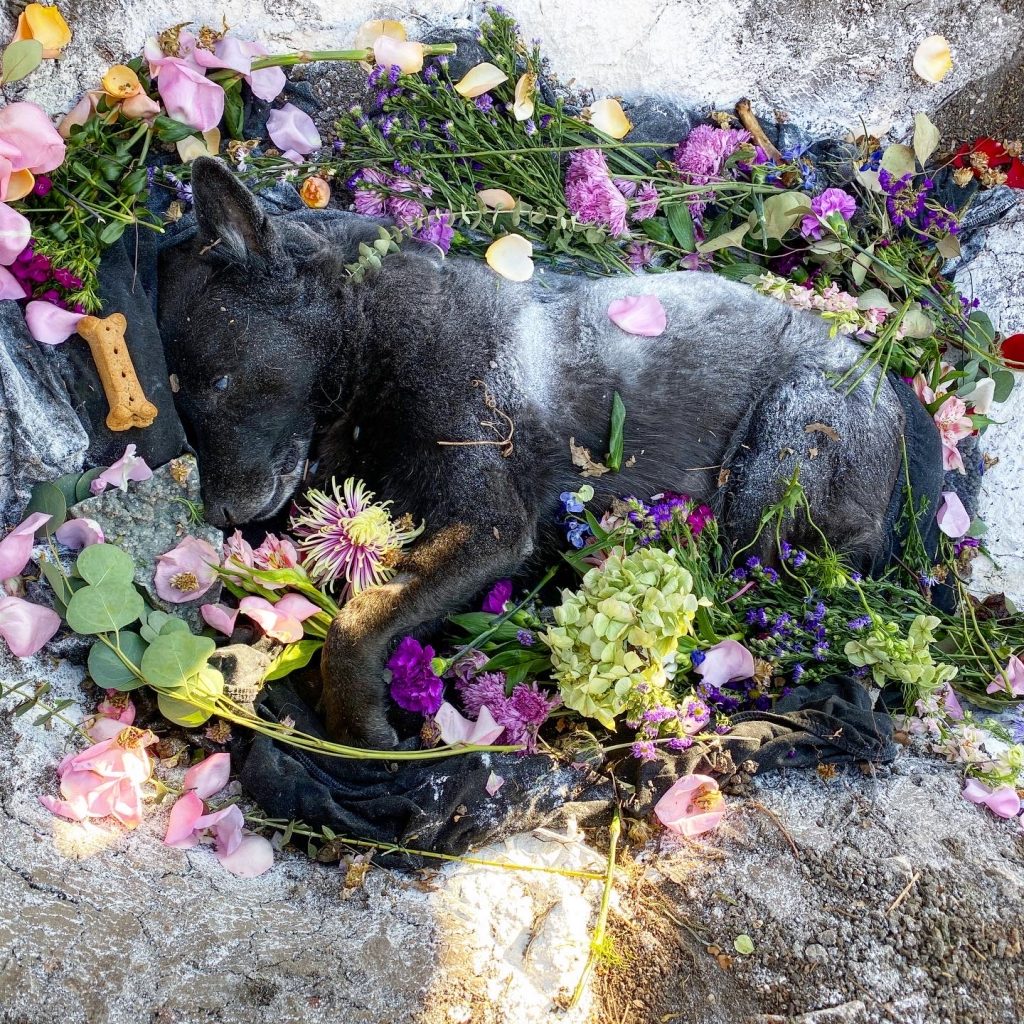
For winter’s rains and ruins are over,
And all the season of snows and sins;
The days dividing lover and lover,
The light that loses, the night that wins;
And time remembered is grief forgotten,
And frosts are slain and flowers begotten,
And in green underwood and cover
Blossom by blossom the spring begins.
– Algernon Charles Swinburne
I remember the week after Grrizelda died felt like one of the longest weeks of my life – deeply internal and slow, not expecting much of myself, and just letting myself be in the process. Grief is fucking exhausting. My beautiful dog left her body and went to fly free over the rainbow bridge with Lady Death guiding her to the other realms, but I was left on the edge of the abyss, battered by waves of shock and sadness.
It felt like being held hostage by a constantly shifting storm system – sometimes rocked by hurricane force winds, screaming gales of rage and helplessness that left me raw and ragged, washed up on the shore after hours of weeping. As the months wore on, it felt more like these minor squalls that would move in unexpectedly – like a cloud crossing over the sun. I think of her, and rain still starts pouring down my cheeks.
These thunderstorms of sorrow are always moving through me, and all I can do is allow them to do their work, to carry my love to the her in the spirit realm, and to cloak me in a mantle of shimmering rainbows when they pass. That’s the blessing of the deep griever – to do this alchemical work of transforming love and loss into beauty, into memory, into art.
It can take awhile, and isn’t a process to be rushed. Moving slow through it is key, and allowing myself to just be where I’m at with it – even if that meant just enduring long miserable nights of crying while eating donuts on the sofa and watching lots of facile superhero movies. During this time, I’ve been getting through it, and working on being as gentle and forgiving to myself as possible, throughout this process. The pain of losing my beloved familiar has changed me, transformed me in mysterious ways. Her death also marks the death of a long chapter of my life, over a decade – and the person I was with her at my side.
My wonderful dad sent me these wise words in a text not long after she died, and they continue to help me a lot, even now:
“You are doing the right things. Remember, you are in the process of becoming a different person, which always involves deep pain. You are in a new strange world. Walk through it with determination but always let the grieving happen as it will.”
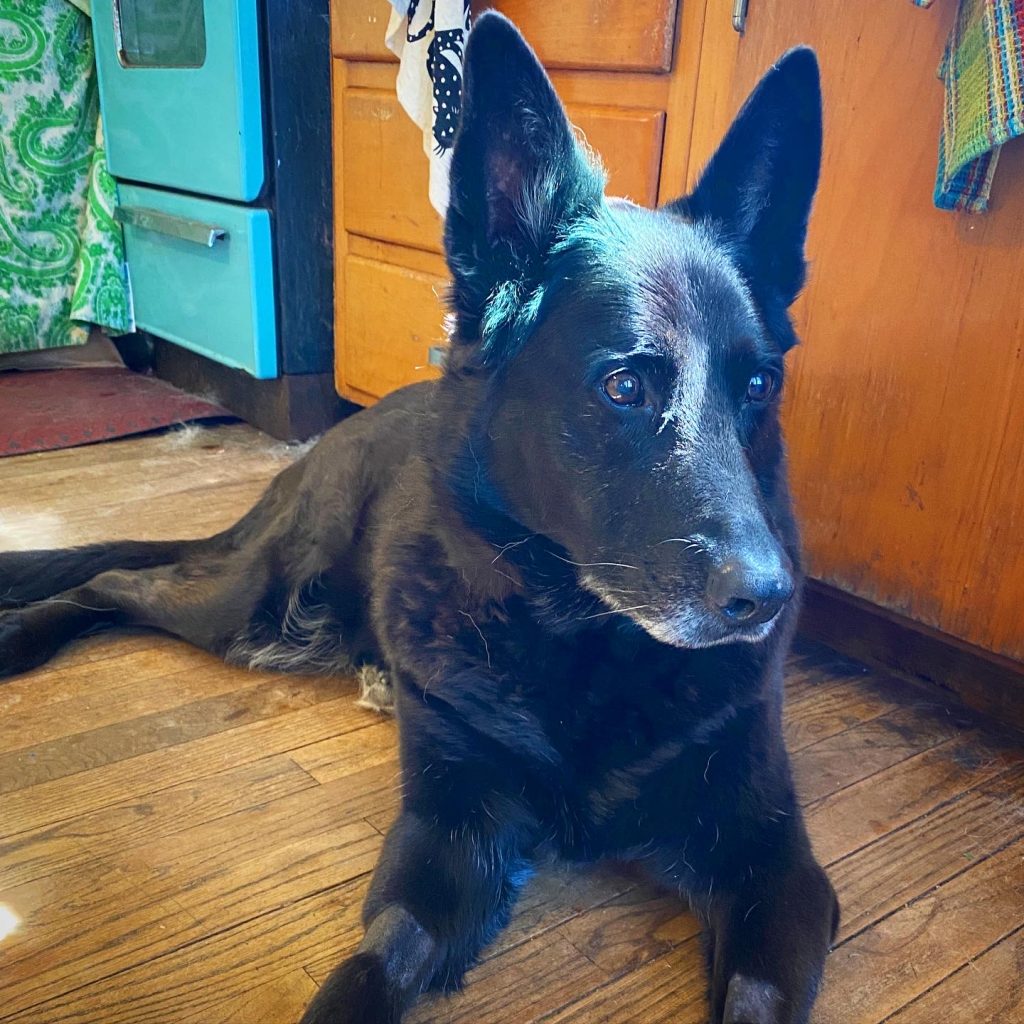
For months after Grrizelda died, I found myself falling asleep on the sofa – and waking up in the wee hours to stumble in the dark into bed. It took me a while to figure out what that was about – but I realized that the ritual I had of saying goodnight to each of my dogs in their beds, distributing belly rubs and kisses was just too hard to do properly with her missing from the equation. The empty space where she used to be was pulsating. Her presence had been so quiet and regal, but so powerful. Moon and Snowy wouldn’t sleep in her spots after she left us, out of respect, and in their own way of showing grief, perhaps.
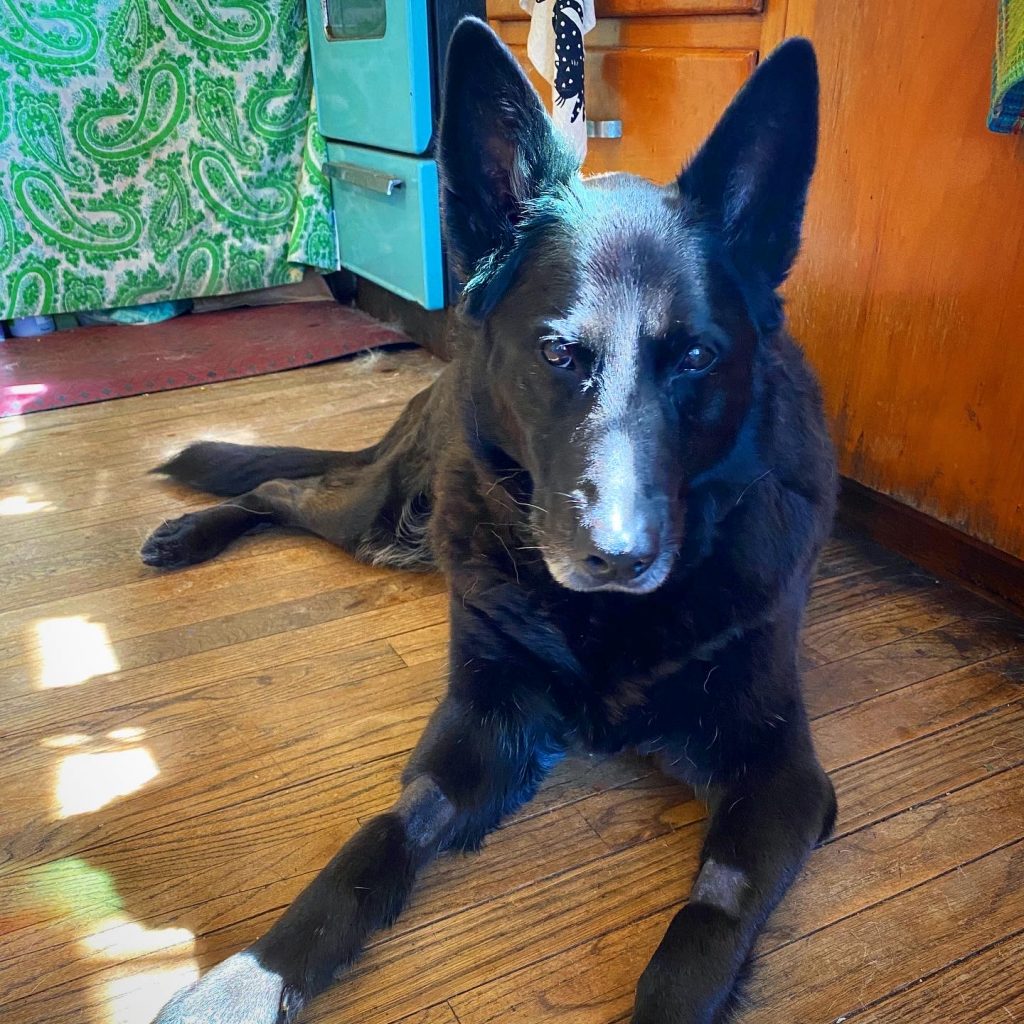
Here she is on her last morning on earth, bathed in sunlight, in the kitchen.
Grrizelda was my best girl, my heart-beast, my wise familiar, my shadow. She was the patient and grounded anchor of our household, the elder pack leader, my familiar – my everything. How do you say goodbye to your everything? I don’t know who I am without her by my side, because I have always felt like the best version of myself with her near me. I have to trust that she’s everywhere, in the air, all around me – or that some part of her is, now. The house has felt so strange and empty without her here – but knowing she’s not in pain anymore felt like a weight off of my heart, even though it’s simultaneously shattered into a thousand tiny pieces.
Being able to take the time to ritualize her death and burial properly made an enormous difference in my grieving process. I treasure the photos I took of her on her last day on this earth, in her lovely wolfy body. It really helped me so much to adorn her with flowers and spend time with her after her spirit had flown.
March 19th, 2021 was the hardest day, the most brutal and gutting dying – and also the most beautiful, and the most healing burying. Letting her go felt utterly impossible to do, and also completely unthinkable not to do. The bigger the love, the bigger the grief. Holding these paradoxes is tricky work, and I lose my balance continuously and go back and forth between extremes of emotion – but mostly just the rawest grief, the most immense gratitude, and the deepest, most unconditional and eternal love. Because that’s what she taught me. Along with profound patience – which I’m still trying to learn.

My dear friend the World Famous *BOB* commissioned this portrait of Grrizelda (based on the photograph above from her dying day) from our friend Aaron Damon Porter – which was such a kind and loving gift from both of them.
People were unbelievably kind to me since she died – dropping off bouquets of flowers and offerings of food to help me through. I’ve received some incredibly moving commemorative works of art by generous friends near and far, in the past few months since I lost both Lowkey and Grrizelda, and it has meant so much to me to see how the love we shared touched and inspired so many creative hearts – most of whom never even got to meet my sweet beasts in person! This generous outpouring of creativity, kindness and support has really bolstered my spirit during my grieving process, and has helped me feel so held.
I think that loving and appreciating our animal kindred is a sure sign of a good spirit, & I honestly find it hard to trust people who say they “just don’t like animals”. There’s so much to be learned through loving them, and being loved by them. I feel sad for people who miss out on that.
For all of us who are lucky enough to get to care for our four-legged friends (or in my Shrimp Scampi and Moon’s cases, three!) as the winged and feathered ones, the scaled and finned ones as well as furred – what a blessing. To be so unconditionally loved and adored by them, to delight in their antics, and their company, and to be so totally accepted by them, exactly as we are. That’s a rare and beautiful thing, and truly a privilege.
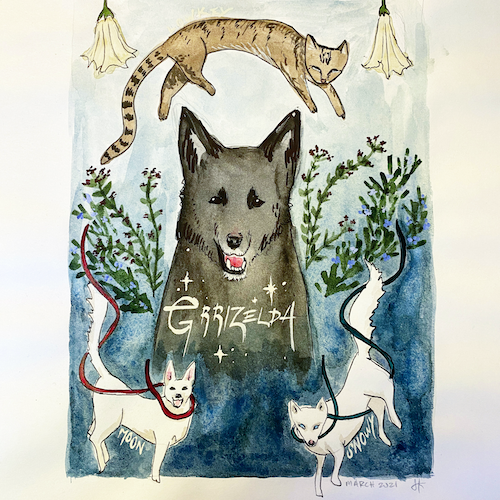
When I first laid eyes on this beautiful watercolor portrait of my beloved animal companions, painted by my friend Jonathan Krugman I immediately burst into happy tears. Seeing my favorite creatures depicted with such care and kindness, so much humor, whimsy, magic and beauty – just completely melted my heart.
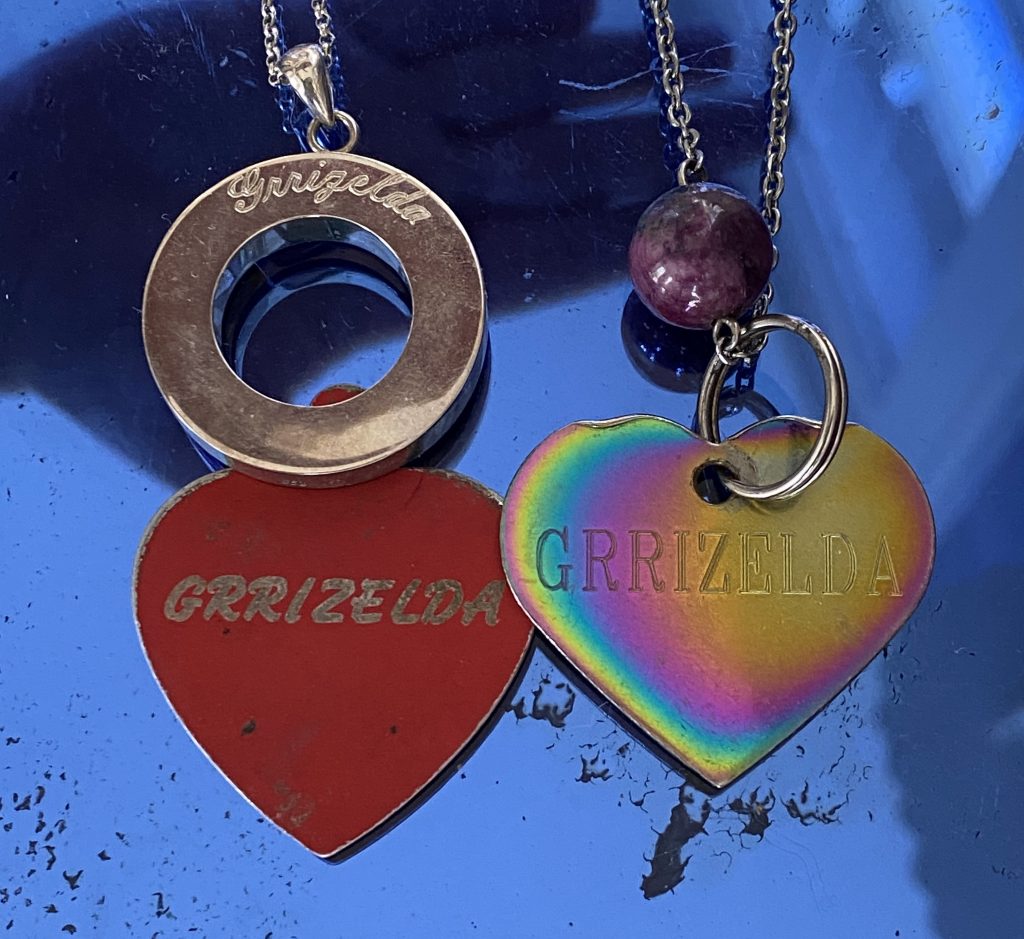
I cling to these talismans, rub them with my thumb for comfort, and wear them when I’m missing her (which is every day). Her tag on a chain with a ruby from my friend Jonah, and a pendant made from her hair in resin which Jonah and Sumer Jo had made for me.


In the interminable and confusing days since she left my side, I have felt so lost without her – like an essential part of me is missing. The closest way I can explain the way it feels is remembering the descriptions from Phillip Pullman’s His Dark Materials books, of what an aberration it would be for someone in that world to be without their daemon.
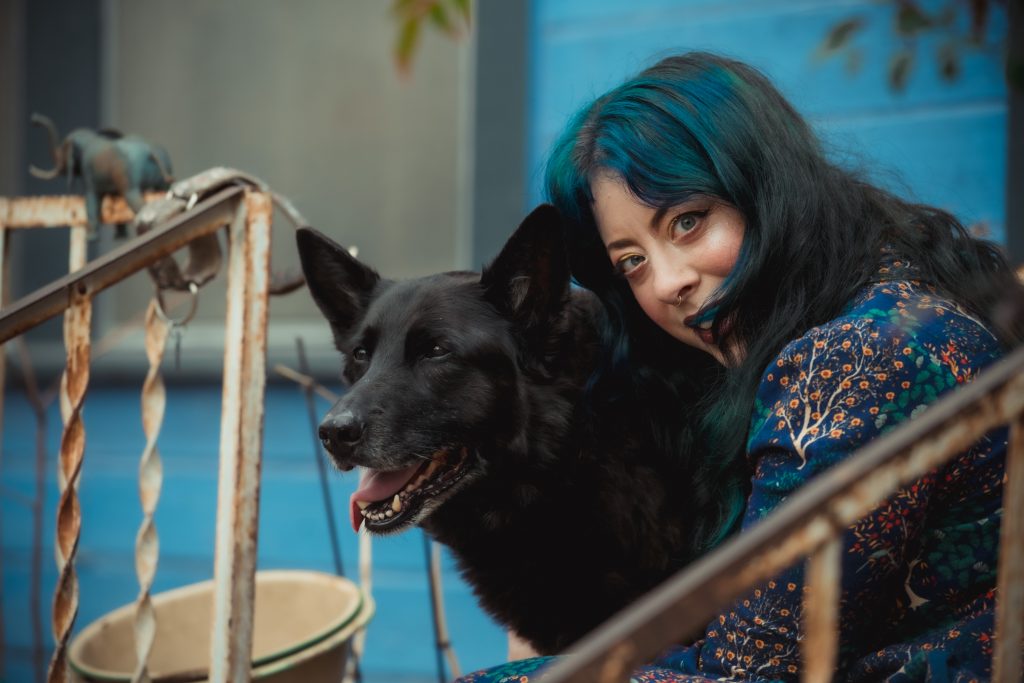
Daemons are animal familiars, aspects of the human soul externalized, in animal form. They can talk, think, and act independently, but they are absolutely an extension of their human – or, their human is an extension of them. In those books, there’s a hideous process called “intercision”, where by means of nefarious technology, the villains in the story cut away the daemons of some of the unfortunate young characters.
In that world, this is absolutely the most horrible thing that can happen to anyone – worse than any kind of torture, or the amputation of a limb. The people who survive this hideous process are seen as ghosts – soulless, shivering husks of what they once were, without their animal companion. When they are encountered out in the world, other humans and daemons draw back in horror and pity, shocked at the utter abomination of two souls who were always meant to be connected, never straying very far from one another (in the book, there’s a pull that becomes painful with separation beyond a few yards, unless you’re a witch or a real hard-ass). To be separated from your daemon is a fate worse than death.
Perhaps it sounds dramatic, but this is what the past year has felt like for me. I’ve lost an essential part of myself, the very best part of myself, maybe – and I haven’t known who I am without her. I felt most like myself when I was walking with Grrizelda. I felt such a deep belonging, meandering along wooded trails, with her by my side. That was my favorite version of myself, and I feel like a part of me died when she did.
I’ve tried to bear up under the weight of this grief, but I’m finally beginning to reckon with how much this immense loss shook me. I am not the same. I feel like I’ve aged a thousand years, had an essential limb hacked away, suffered an injury that will mark me for the rest of my life. I know grief is like that – and looking back on all the losses I’ve experienced in my life (my god, there have been so, so many now) I know that some of this is cumulative – scars on top of scars on top of scars.
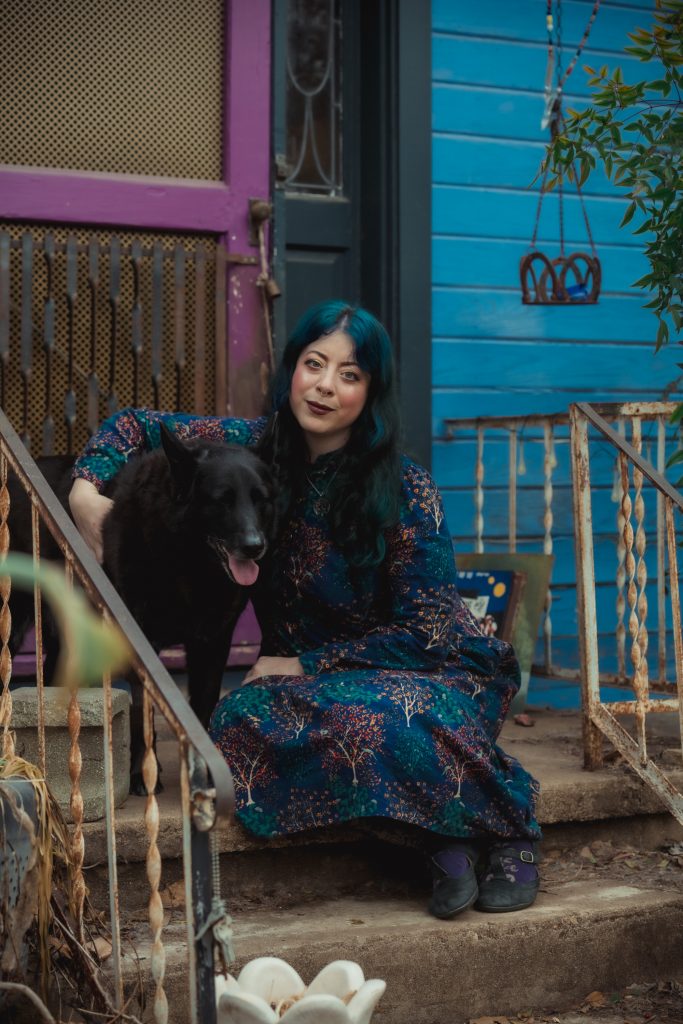
I know that a big part of how hard it’s all hit me has had much to do with living through multiple massive and collective traumas simultaneously – an ongoing pandemic that has claimed millions of lives now, the grief of climate collapse, war, a terrifyingly unstable political situation, and major uncertainty for any kind of easy or peaceful future. Amidst that, I’m also navigating a wasteland of shattered friendships lost to the cognitive dissonance of the grief-denying, death-denying delusions that have fueled new age anti-vax conspiracy mentality.
It has been extremely difficult to grapple with all of the above, along with being diagnosed with a chronic (incurable and untreatable) illness that makes me especially vulnerable to a virus like Covid-19. I’ve been enduring what’s been years now of pretty intense isolation, and really feeling acutely the lack of support from tangible community – meaning, people physically present to show up during a loss like this in the way I know they would’ve love to, had we not been in the midst of a pandemic. I want to acknowledge that so many people absolutely showed up for me beautifully (from afar) during this time, and the countless kindnesses and love sent me way truly kept me afloat in some of my darkest hours.
It was just already such an incredibly hard version of reality to be living through, for so many of us. When the pandemic really got going, I would say all the time, “The only way I’m managing all this isolation is with the love and companionship from my animals” – so to lose two of them in the space of just a few months felt unspeakably cruel. The brutal revelation of Grrizelda’s illness and rapid decline came on the heels of the traumatic polar vortex ice and snow storm here, and the abrupt and violent death of my kitty Lowkey happened just the month before.
Living through the past two, almost three years now of never-ending pandemic and accompanying worldwide shit-show has sometimes just felt like too much for any heart to bear. And yet – we do, somehow. The heart breaks and breaks, until it opens. Over the past few years, my heart has been shattered into dust over and over, and yet – it keeps on beating, more open than ever, and overflowing with grief, with love, with so many intense emotions.

For a long time after she died, I went underground, into a kind a stasis. I might be starting to emerge a bit, now – but we’ll see. My grief was so raw, it felt like a terrible wound that just needed to be wrapped up, covered with a dirty bandage until it scarred over, and wasn’t quite so tender. But I know these anniversaries have a way of breaking open the scar, and letting any festering pain seep to the surface, so a deeper healing can take place. Lately, I’ve been peeling back the wrappings, and examining what’s underneath. Turns out, it’s still pretty raw under there, but it needed cleaning out, and I’m glad to finally feel ready to tend to it, through writing, looking at photographs of her, crying, and just letting myself really feel it all.
I’m embarrassed to admit it, but for the past year, I’ve let the altar in my bedroom accumulate a thick layer of dust. Every day, I’ve looked at it with sadness and some disgust, and thought about cleaning it. I knew I needed to, knew I would feel so much better once I had – but I just couldn’t bring myself to do it, until the anniversary of her death. I think I buried myself when I buried my dog, in a way – let myself get covered up in dust and dirt, too. I made a cocoon for myself – or a grave.
This self-neglect was partly a by-product of being in survival mode, low power mode – where all my energy was going to just keeping myself and my remaining animals alive and maintaining. I’ve been so grateful for the company of my funny loving little cloud-clowns, Moon and Snowy – who have kept me laughing and snuggled when I needed it most – and to my irascible ginger kitty Shrimp Scampi, who once loved to cuddle with her friend Grrizelda. Scampi kept me company as I wiped away the layers of schmutz and cleared away everything extraneous off my altar, and lit the candles in front of portraits friends painted of Grrizelda, and added her collar, a little felt poppet in her shape, stuffed with soothing herbs made by another friend, and a box carved with plants for grief made by yet another. Inside that box I’d stowed bits of her fur, the bloody gauze from her blood draws, a torn piece of paper with her name on it from the bag all her pain meds came in. I lit candles and placed and vase of white irises there for her, and finally hung the beautiful portraits of her friends had made after she died. I wasn’t really able to look at them much, for a long time – not until now. It was all just too much for me, the accumulation of wounds too raw – but I’m so incredibly grateful to have her looking over me while I sleep, and to feel like she’s still in the room with me, in a way. Art is magical like that.
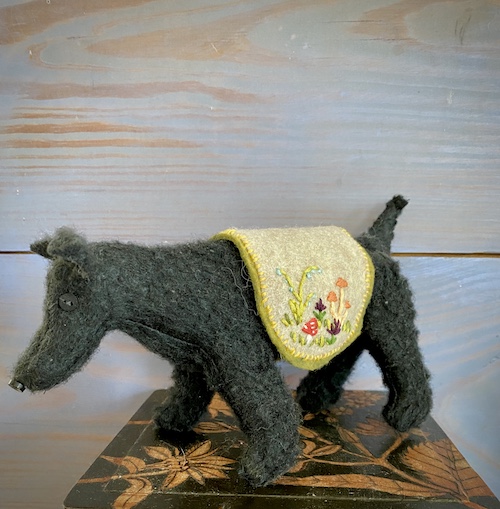
This beautiful Grrizelda poppet was made by my friend Melissa Eva Meyer, and is stuffed with healing herbs – rose, lavender, calendula, and chamomile. The magic grief support box she sits atop was made by Emily Plews (of Sacral Vessels), who used pyrography to inscribe images of linden, borage, mimosa, wild rose and hawthorn – all herbs sacred to me, who assist with grief.
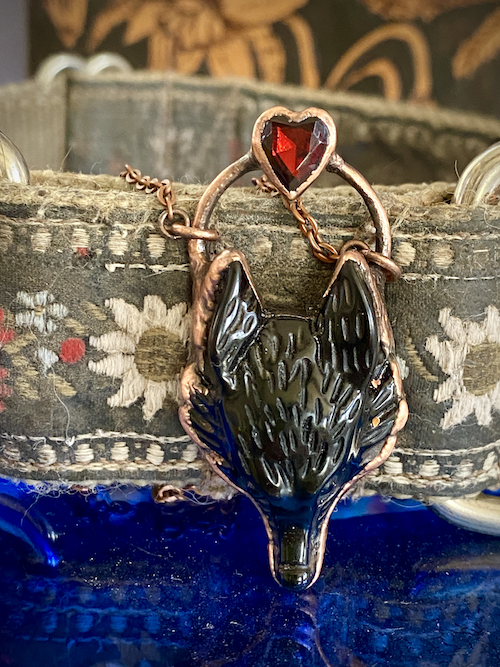
This black wolf pendant with a garnet heart (my and Grrizelda’s birthstone) is from Queen of Jackals. When I’m not wearing it, it rests on my altar with her worn edelweiss collar (for a gut German fräulein, natürlich!)
This poem makes me cry every time I read it, which I know is part of the healing:
“Things to do after your dog has died
Sweep the floor
Look out the window
Pant
Make a cup of tea and some toast
But then not eat them
Change the sheets on the bed
Try to sing
Start to cry
Forget what day it is
Stumble into a corner of the floor and hold your knees tightly
Keen
Pull yourself together
Make another cup of tea and this time drink it
Look out a different window
Stare at that spot on the floor where your dog used to stretch out, languid and happy, his paws twitching as he raced across sleep meadows and into dream ravines filled with moss and ferns and the scent of foxes
Look for the Kleenex
Use toilet paper instead
Wander around the house, your heart like a damned anvil in your chest
Heat up leftovers
Push them around the plate before leaving the entire thing in the sink
Look for what is not there
Hear things
Feel the forgotten fur beneath your fingertips

Feel the forgetting begin
Hold a memory, any memory, bright and shining, soft and sad, smelling of wet fur and leaves, with a whisker there and muddy paw prints left on the stairs, of a walk of a hike of a trip to the park with a treat and a bone and a belly rub snacks stolen off the counter and tug of war and the squeaky toy a glance of complicity in play with your hand on head with tail wagging and breath misting in the morning light or the moon over the trees while an owl croons ears are pricked and nose to the ground sniffing, sniffing, sniffing following the invisible trail to its joyful finding
Put on your pajamas
Turn around three times before you curl up by the rope toy and find yourself chasing the echo of a bark into a night that will never end
Grow a tail

After my dear friend Marcela lost her beloved elderly canine familiar Tulla, she received a memorial tattoo from our longtime pal Pauly Lingerfelt from a drawing by Magda Boreysza, whose art I have loved and admired for many years. I was very moved and inspired by the way it came out, and was so grateful that she didn’t mind me wanting to be dead dog memorial twinsies with her.
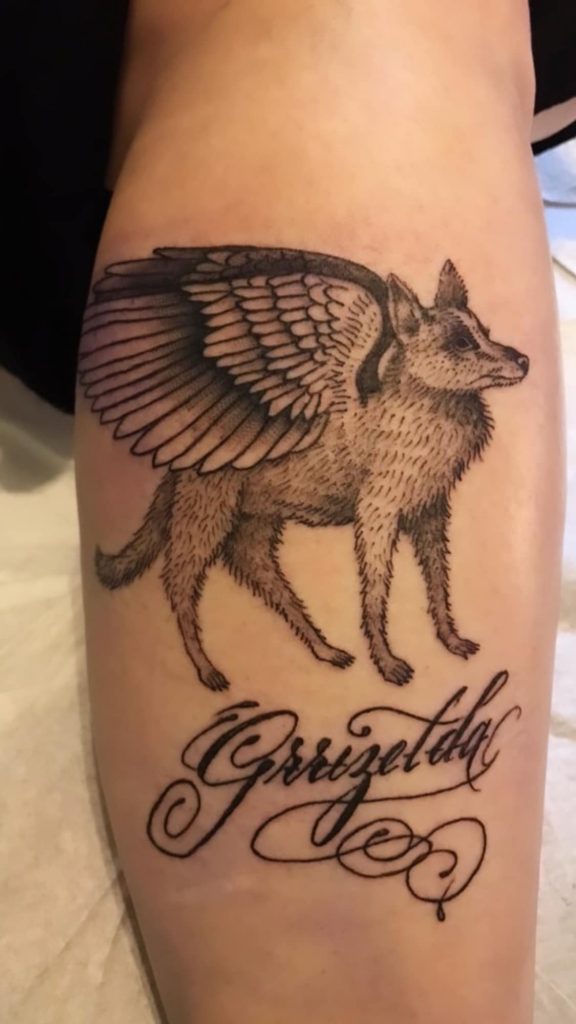
Having Grrizelda emblazoned on my skin, walking with me always – until I leave this body and go to find her, has been an immense comfort. She is my Anubis, guiding souls in the land of the dead, and watching over me while I still live.
It took me a really long time to write this – and it was a lot harder than I thought it’d be. Not because I didn’t know what to say – but because once I started, I just don’t know how to stop. I keep finding more and more photographs, thinking of more stories and memories I want to share here, and I just have to accept that it will never feel like enough, and that my love, and my grieving for her will go on and on.
I’ll likely keep wondering if I did her justice with what I shared of her existence here. Did I bring her to life enough for someone who didn’t have to blessing of knowing her to possibly understand how amazing and singular she was?
And did I give her enough while she was here? Enough attention, affection, joy? I can only hope that her 12 years on this earth were as good and happy and fulfilling as I could possibly make them for her.
We go on such a journey with our animals – but there’s a point where they have to walk ahead of us, scouting out the road over the next bend, beyond our sight. I can only hope that she’s waiting for me up there, and that in some way, at some point – we’ll be joined together again.
“Grief is the honour we pay to that which is dear to us.”
― Toko-pa Turner, Belonging: Remembering Ourselves Home

PRINZESSE GRRIZELDA POLACHECK
JANUARY 15TH, 2009 – MARCH 19TH, 2021
This is Persephone magic, rising back up to life after being hidden away in the darkness. The Vernal Equinox will always hold a space of grieving for me now, as I lost Grrizelda on the day before (the 19th). I still feel like Demeter, grieving her stolen daughter – and then slowly seeing her return in a different form, alive again in the blooming flowers and birdsong. Now roses and datura rise up from the earth over her bones, and whisper to me stories of her next incarnation as I water them with my tears. This season is a scythe’s edge, a translucent eggshell membrane cracking open between the worlds of life and death. After these brutal dark winters, it feels like life is finally winning again. I need that to be true.

I don’t think I truly realized until recently how much I needed to be part of a pack. In my family, and in my friendships (as amazing, loving, and supportive as they are), it’s always been hard for me to shake the feeling of being a bit of a stray. My original family was deeply fractured by my mother’s death, and I was left with relatives (my Aunt Ruth, who I’ve written about here, my Uncle Jimbo who died tragically and unexpectedly in June 2021, and my two cousins, Luke and Betty) for about a year after she succumbed to cancer. I was, and still am, grateful to them for taking me in when they really didn’t have much in the way of room, resources, or emotional energy to share – but it was still hard for me to be torn away from everything I knew. I felt like a foster dog, lost and abandoned – kicked to the curb, and then taken in by people who already had too much on their plates.
It’s taken me a long time to understand it, but that experience of being dumped off on a doorstep, feeling like an interloper into a new pack, with new dynamics, and new rules really messed with me. All my life, under the surface, I’ve always had to be constantly evaluating, scanning for safety, gauging where and how I might be able to fit in and be accepted. A lot of that wariness left me for the first time when I found my wild wolf pack. And it’s part of the reason so many of those difficult feelings returned to me after Grrizelda died in the spring, and then again (even harder) when my uncle died in the summer.
The orphaned, unwanted part of myself was very much rescued by the dogs I rescued – all of whom were neglected and left to roam wild, until we found one another. It’s one of the many reasons I’ll always want a shelter dog instead of one from a breeder – because I know what it’s like to desperately need to chosen, to be cared for, protected, and loved forever. And in offering that to my dogs, it truly has been returned to me, one-thousand fold.
“And do you want to run with my pack?
Do you want to ride on my back?
Pray that what you lack does not distract
And even when you run through my mind
Something else is in front, oh, you’re behind
And I don’t have to remind you
To stick with your kind
And you do say oh oh
That you do pray oh oh
And you say
That you’re ok”
– The Book Of Right-On
by Joanna Newsom

Me and my pack. This is what belonging looks like. We belong to each other, always and forever.
THE AUGUST RITUAL
by angeliska on August 9, 2021
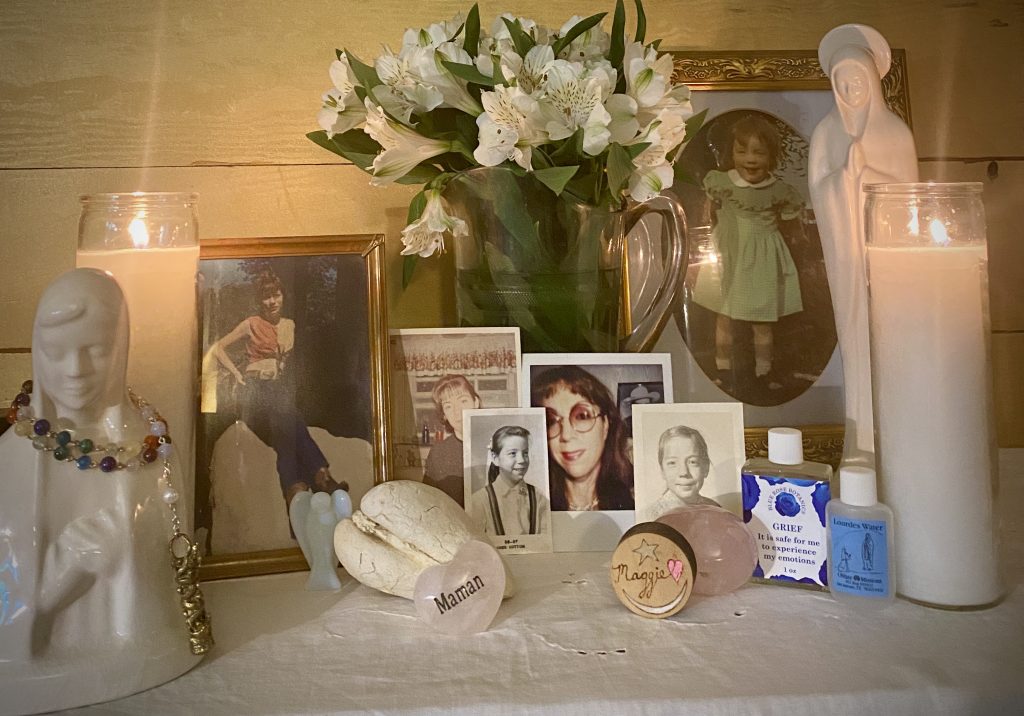
Every year when August rolls around, my body reminds me how full of pain this month has been for me – by keeping me awake until the wee hours, joints aching, mind buzzing with anxiety, and my nervous system cycling through all the motions of survival mode. This day, August 8th – my mother’s death day, and every day since, for the past 35 years carry the echoes of all the ways my life was splintered into fragments after she walked through that door, from her body into some other version of reality. August 29th, Hurricane Katrina roared through New Orleans, blowing my roof off and ripping massive holes in my life there, and destroying the homes, lives, and communities of countless others. Some wounds never fully heal. Maybe the scar fades away, but you feel that rough ache in your bones every time it storms. Healing is not linear, which is why these heavy anniversaries cause flare up of unwieldy emotions, of fear, of memories that our bodies hang onto and keep holding, even when our minds forget. I can’t stop thinking about how this current trauma we’re all living through will continue to affect us, years from now – especially when the idea of it being over one day feels like a distant dream. As I write this, hospitals are running out of beds as coronavirus cases surge, due to the proliferation of the new Delta variant, allowed to mutate by all the people who chose not to receive life-saving vaccines. Those people are rapidly filling up ICU units, making it impossible for anyone else who needs critical care to receive help. We are in Stage 5 here in Austin again. What comes after Stage 5? I really don’t want to know.
I’m already feeling a helpless rage flood my body when I scroll back to posts from the beginning of all this, made by people I used to think I had something in common with (spirituality and compassion, ha) – talking about how this virus was part of some nefarious global conspiracy. Seventy-two weeks or so later, and more than 614,000 people dead, I’m asking those people to tell me now what it’s all about – because I’m sure all the families of those who lost loved ones to an entirely preventable virus would love to know, too. I have grieved for so many friendships and spiritual communities lost, when people of incredible privilege chose spiritual bypassing, selfishness, and delusion over social responsibility and community care. I don’t know if I’ll ever really understand the level of cognitive dissonance they’ve subscribed to, and I don’t think I’ll ever get over my horror at seeing people who supposedly had devoted themselves to healing and enlightenment choose massive harm and idiocy instead. I’m still undergoing a pretty huge crisis of faith, and have stepped away from many of my spiritual teachers and practices, due to my immense disappointment at how they’ve chosen to basically ignore the fact that we’ve been in a mass death event for a year and half now. I was shocked to see so many leaders turning away from the moment where we truly needed them most – to speak clearly and passionately on how we need to step up and protect on another, on mysteries to be found in solitude and isolation, and to offer comfort and wisdom in a time of death and loss on such a large scale. With very few exceptions, most failed to rise to the task – choosing toxic positivity, ableism, and pseudoscience over care, reason, and nuance. As someone who is committed to devoting my life to compassionate spiritual service, it nearly broke me to witness so many people I once respected utterly fail their communities by choosing damaging nonsense, instead of showing up in the way we really needed.
My own journey with loss and the work I do holding space for people going through big life transitions has shown me very directly how profoundly bereft our culture and society is when it comes to acknowledging the ravaging effects that the death of our loved ones has on our lives. Living through a global pandemic has shown me all the worst ways we have come to live in a deeply death-denying and grief-denying society. I know that this inability to sit with the ugly truth of our mortality has fed the roots of the many of conspiracy theories about Covid being some kind of hoax as well as people’s refusal to wear masks, get vaccinated, or even take the most basic precautions to protect themselves and others.
When the pandemic began back in March of 2020, I started buying books about grieving – stocking up on them like other people were socking away cans of soup and rolls of toilet paper. I already had plenty of those, being the kind of person whose trauma tends to manifest in a constant need to be prepared for the apparent inevitability of any disaster. As if the extra bags of dried beans and rice and the loops of catastrophic thinking will somehow stave off any future apocalypses, both emotional and climate or war related. I remember those dark moments of that spring, having panic attacks about running out of dog food while doomscrolling the news reports, my lungs filling up with fluid as I struggled to catch my breath. I was still trying to recover from what was likely Covid-19, acquired in New Orleans in that late February Mardi Gras.
It took months for my lungs to fully heal, but I couldn’t get a test back then, because they still were basically only testing people who seemed to be actively dying. I rewrote my will, and tried to get my dad and stepmom to discuss a plan with me for what we’d do if they got seriously ill. My dad still didn’t understand at the time why it wasn’t safe to go do his monthly song sessions, where folk musicians would gather in a small enclosed room with no ventilation and sing loudly. There was so much we didn’t understand then about what was to come, but one thing I was sure of – big grief was coming, probably for me, likely for many, and I knew that no one was going to know how to deal with it. I was terrified for my beloved elders, for the family I still have left – my parents, my aunts and uncles, and my teachers, most especially. I was so sure I’d end up losing at least some if not all of them to this hideous virus, but miraculously (so far, knock wood) they’ve all managed to avoid coming down with it. I figured that even if I didn’t lose anyone I loved, people close to me likely would, and my clients would – and so, I bought Pema Chodron’s Welcoming the Unwelcome, Francis Weller’s The Wild Edge of Sorrow, The Crying Book, by Heather Christle, and The Smell of Rain on Dust: Grief and Praise, by Martín Prechtel. I feel like I know a lot of about grief, from experiencing so much of it firsthand – but it’s one of my missions in this life to be able to support others through these experiences, and I always have more to learn about this work of deep feeling.
It feels dangerous right now to breathe a sigh of relief, and feel like we all dodged a bullet, even though most of the people in my life are now vaccinated, and hopefully will be protected from death and serious illness (though perhaps not Long Covid, unfortunately), should they contract the virus at this point – and I am so unbelievably grateful for that fact. I think it’s partially the fact that so many of us remained untouched by the wildfire that raged through so many other communities, along with the lack of images of the seriously ill and dying people that made the AIDS crisis really hit home that has contributed to a sense of unreality, or invincibility for a lot of people. For some reason the images of mass graves being dug, or freezer trucks converted into mobile morgues in New York, of intubated patients clutching latex gloves filled with warm water for comfort, meant to simulate the hands of their loved ones, who they weren’t able to hold as they lay dying – none of those seemed to make any impact on the thousands of people who’ve had a very different experience of this pandemic, blithely going about their lives, and around in public, maskless, undistanced, unvaccinated. I hate to admit it, but I’m running out of sympathy for those people – especially as I talk with my friends and family who are health care workers, exhausted and totally depleted of compassion because of what they’ve been having to deal with for the past year and a half now.
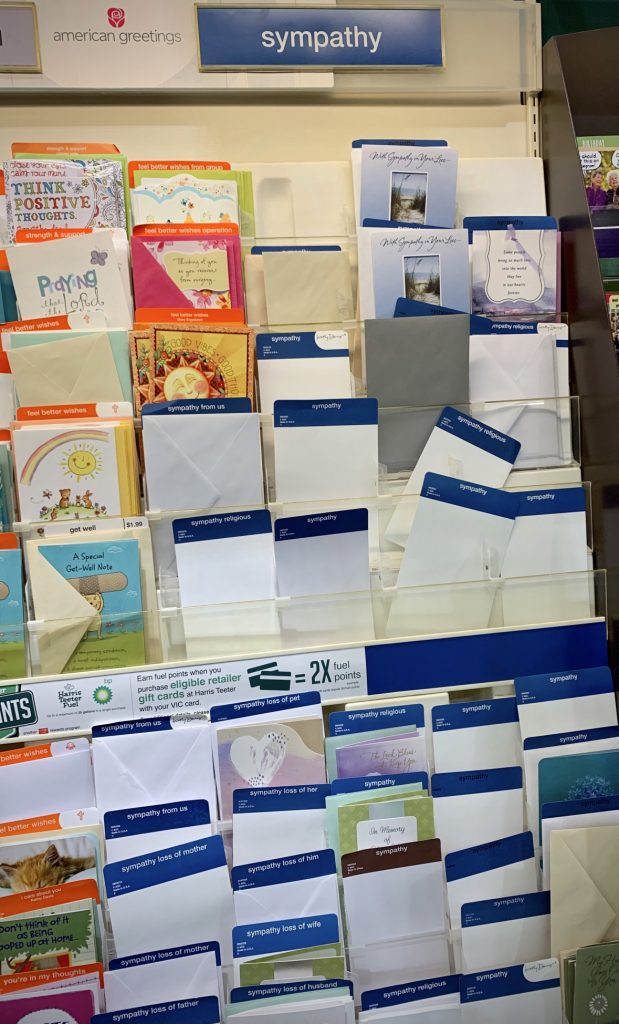
Out of all of the above though, the images that have stayed with me and hit the deepest are photographs from drugstores of empty racks of sympathy cards – all sold out, due to mass demand. Now that the delta variant is bringing the crows home to roost, I wonder if we’ll see more runs on Hallmark cards (as well as toilet paper, thermometers, and pulse oximeters), or has all the sympathy dried up as people become numb to the constant flood of loss? We don’t honor death the way many of our ancestors did during the influenza pandemics of 1918, weaving elaborate wreaths made from our loved ones tresses, and months wearing mourning garb in yards of black crepe, and jet jewelry. I wish we hadn’t lost all our rituals, or had them taken away from us by the cults of capitalism and convenience. I was never a big fan of sympathy cards, with their saccharine, trite platitudes – but something about the idea of this being our one common way of expressing care when someone is going through a personal tragedy has become more meaningful to me, over the years. Especially in this last one, as most deaths went without the rituals of funeral and memorials services, of rowdy wakes and sitting shiva. The cards I received over the past year meant so much to me, and brought me a lot of comfort in my darker days. Sympathy used to feel like lukewarm pity to me, but I’ve come to realize that even if someone can’t totally empathize with a major loss, they can show that they care – and these days, that goes a long way. I’ve often wanted to create a line of sympathy cards that feel more heartfelt and authentic than what you can generally find at the grocery store – and perhaps I’ll have to, before all this is done. I know that receiving a handwritten letter or note in the mail is a dying art, and it warms my heart to see that we haven’t forgotten it completely.
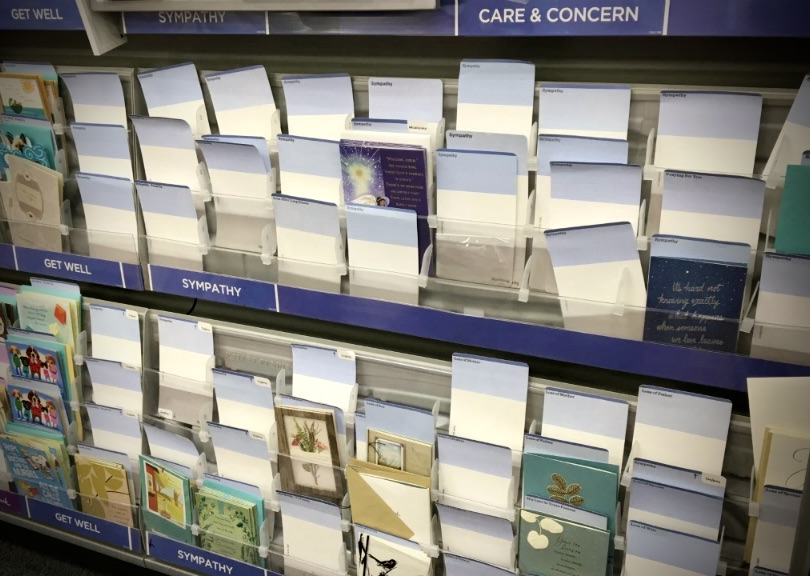
The writing I do here is my ritual, the thing that marks time for me, that shows me where I am in this journey of grieving – though it often feels impossible to properly convey everything I want to say about what I’m feeling, and experiencing, as I walk this rough road. All I can do is keep trying. Death doesn’t take holidays, I’ve discovered – and manages to creep in to our lives even when we’re doing everything we can to protect ourselves and our loved ones from the obvious effects of the plague. I learned that lesson the hard way – in that none of the losses I’m grieving this year weren’t due to Covid. I’d had that feeling that I’d be going through some grieving when this all, but I wasn’t in any way prepared for who death chose to pluck from my life, or how. These deaths all felt horribly sudden and shocking – and were all incredibly traumatic, even the ones I’d had some time to prepare for.
I’ve learned over the years, that all the losses I’ve gone through have a way of echoing into the cavern of that one huge loss – the one that shaped everything I’ve become since age seven, when my mother died, and really even before that, when her illness started carrying her further and further away from me, and everyone who loved her. All the losses I’m holding from this past year or so (two in 2020, and two in 2021) feel too big to talk about. They’re like ganglion cysts, tangled up around my veins – I can’t separate them easily. I’ve been trying to get to this part in my writing all day, and I keep getting up and walking circles around my house, being with the hot August winds blowing, and the golden afternoon sun, and the ripening tomatoes. I come back inside to my noisy air conditioner and the candles on my mother’s altar burning brightly and call on her spirit to help me find the words to tell you what and who I’ve lost.
First there was Lowkey, my ancient kitty – I managed to write about him, and how he died, in the first days of the new year. But then the freeze came, that brutal winter storm that brought my state to its knees, covering Texas in thick blankets of ice and snow, and hobbling our power grid. Trauma on top on trauma on top of trauma. Hundreds of people died. Homes flooded with broken pipes, countless gardens and trees were destroyed, including mine. My garden came back, mostly – but I was pretty devastated by waves of PTSD from remembering what we all went though with Hurricane Katrina, and how similarly, that natural disaster’s worst effects were entirely preventable, if the people in power had done their jobs right. The pandemic is bringing up a lot of that again, too. As soon as the thaw came, I was able to take my beloved dog Grrizelda in for what I thought was an appointment to remove a rotten tooth. It turned out to be an aggressive melanoma. She died less than a month later. I’ve wanted to write about what her death did to me, but it has felt too raw, too close. I don’t know how to get any words around it. It’s too much, though – too big for one day.
I have too much to hold, too much to say – and I want to do them all justice, the beloved ones I’ve lost. Our complex relationships. My dog, my daemon. My Uncles. Jimbo, and Don. They deserve their own writings. I don’t know why I thought I could squash it all into one big piece – except that I’ve been trained to, by this fucked up culture we live in, to believe that grief is only allowed to exist in a certain time and space, a tidy allotment, that one anniversary a year that we offer to it. As if it doesn’t constantly spill over, go on and on, and messily colors everything else in our lives. Grief is the red sock that dyes the rest of your laundry pink. You can keep trying to separate it out, but it always finds a way of sneaking back in.
I’m so sad and angry today. I want to direct my anger outward, because I’m tired of crying, and I’m tired of writing, and my body hurts a lot today. I’m angry that we live in a culture that is so shitty and fucked up around death that most people can’t even acknowledge it – or be bothered to try and prevent it. I’m angry at people who don’t know the difference between the actuality of death and the experience of loss, & try to tell me how to feel because physics. These things are not the same thing: DEATH ≠ GRIEF. I’m angry at preventable death. I’m angry at all the people who are blithe or callous about death, because they’ve never had their life completely ripped apart when someone totally essential to their existence just disappears FOREVER. This pandemic, where over 614,000 have died in this country alone, really hits different for those of us who’ve had our lives shattered by death & loss.
My feelings are too big for this one little container, but I know that writing it all out, and being witnessed in it helps me more than anything else – especially after so many decades of hiding my grief from everyone around me. Suppressing all of that will make you sicker than anything – and I mean that on every level. I’m crying a lot today, all week, all year really – broken open in a hard way, but a good way. Really learning to cry, to let my whole body grieve, was truly the greatest gift I’ve received from all the unbearable losses I’ve experienced in this life. There have been so many. Learning to cry and let it out is part of why I’m still here walking this earth. I forget sometimes that I don’t have to do it all at once. I created this space, (this blog or website, or whatever it is now) many years ago as a space to write and share my life, to celebrate the beauty I see in the world, and often, to eulogize my dead, and process and honor my losses, my loved ones who have gone beyond. There are many reasons why I started to neglect writing and sharing here, not all of which are entirely clear to me yet, but I feel a need to reclaim it for myself. Perhaps there’s a bit a freedom in the fact that I think few people still have the attention spans to read blogs, and long form writing. I know most people do subscription services with personal essays that go right to your inbox, and I know from my own experience that I let those pile up and never really read them, even if I intend to. So, if you’re reading this right now, it’s because you care, on some level – and I truly appreciate that. Being seen in this hard work and heavy lifting of grief truly does make it lighter for me. I’ve joked that this space has just become my “dead mom blog” because I’ve really only been coming back to write in it on this day, and then when Lowkey died. That might shift eventually, as I figure out what I want to do with all the writing I’ve done here about my journey with my mom, and her death – but I don’t mind this container being held as a space for my grief for a little while longer, because I have a LOT of it, and because we don’t make enough spaces for grief, these days. And we desperately need to. It’s literally killing us, not to. A huge part of why this pandemic is so out of control in this country has to do with the fact that so many people are deeply in denial about their own mortality – to the point of inventing conspiracy theories to avoid looking at it.
I feel completely helpless to do much about it, other than keep speaking and writing truth, even if that alienates me from those in my life who are too terrified by the idea of death to take their thumbs out of their ears. Nothing is ever going to feel like enough, in the face of so much loss, but maybe if I can carve out a space here again to write about grief, it will help anyone who happens to stumble across it. I know it helps me, and honestly – that’s enough. So, I’m going to make a promise to myself here – with you, kind reader, as my witness: I’m going to come back and write about my dog, and my uncles. I’m going to share them here, because I need to, and because they deserve to be known. What I know, and what I feel I’m allowed to share, about their lives and deaths, and about our relationships – it needs to have a tangible space for me. Grief demands that of us, though we often fail to acknowledge it. It’s why we need the rituals, the altars, the ofrendas, the photographs and memorial portraits, the eulogies and obituaries and gravestones. We carve it out in stone because otherwise, our dead just fade away like dust. Like they never existed, like their deaths didn’t completely reshape our realities. Remembering them, and making a space to hold all those memories, gives them a space to be immortal, to be something other than just suddenly and irrevocably gone, even in this little ephemeral corner of the internet.
So maybe you’ll come back and join me to read the rest of it. I’d be very honored, if you did. And perhaps what I share here will inspire you to find your own little corner of space, wherever you can in your life, to make space for your dead. I invite you to try it, if that idea calls to you – and if you need help with it, please reach out. This is part of the work I do in the world – and as much as I wish I wouldn’t have had to experience so much loss in this life, I know I wouldn’t be able to offer the medicine I have, bitter as it sometimes is, had I not been traversing these black and treacherous mountain ranges. I’ve got some big hikes ahead here – so I’m very grateful for your hand in mine. Thank you for being here in this, with me.
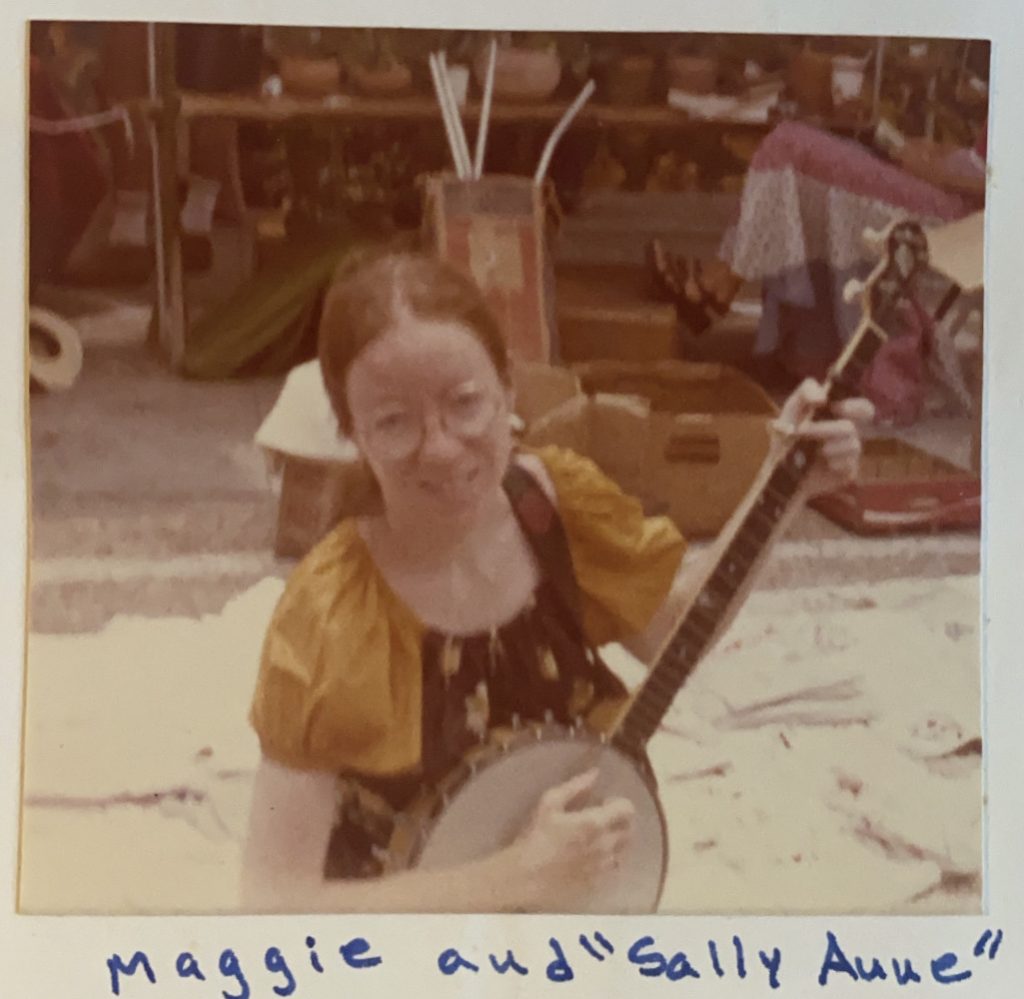
I dedicate this grief work to the memory of my mother, Maggie – who gave me life, and whose death shaped my path.
Thank you, mama, for everything.
If you’d like to read more about this journey
of grieving, honoring, and remembering my mother,
here is an archive of my writings about her:
FALLING STARS + CACTUS FLOWERS
DOUBLE ETERNITY
MY ANGELIC INHERITANCE / THE HOLOGRAPHIC WILL
38 ON AUGUST THE 8TH
30 YEARS – SEIZURES
888 – HONEY BABE, I’M BOUND TO RIDE – DON’T YOU WANNA GO?
WILD BLUE YONDER
NO ROOM IN MY HEART FOR THE BLUES
FAMILY VACATION – HANK WILLIAMS’ GRAVE
STAR-CROSSED TROUBADOURS
Foxes in the Rain
Triumvirate Lemniscate
Gustav + Mama – August 8th
R.I.P. LOWKEY
by angeliska on January 13, 2021
You’d think that after being with Lowkey for 15 out of his 19 years on this earth, I’d be more prepared for his passing… But it was more brutal than I’d ever prepared myself for – even with so many close calls over the years. Lowkey ran through all of his 9 lives (and then some!) in his time on this earth. I’ve never seen a creature more dedicated to fighting to stay alive, despite all odds…
 Lowkey almost a year before he died, January 7th, 2020
Lowkey almost a year before he died, January 7th, 2020
Lowkey was found by Colin and Jana on the train tracks, abandoned as a kitten with no voice (just little a hissy rasp). He must’ve had some damage to his larynx & vocal cords, because he was never able to make an audible meow. I’m guessing he was tossed out of a car, and injured in the process (sadly very common, and the second of my cats to have survived that). A few years after that, he was viciously attacked by dogs, who ripped him open from his gullet to his zatch. His guts became necrotic, and he was only saved by intensive hydrotherapy & echinacea tincture in glycerin for his wounds. It’s a miracle he survived that with only a hernia and a forever slightly crooked butthole. He never liked to be inside much after that, because he was stuck in one room while he was healing for weeks and weeks.
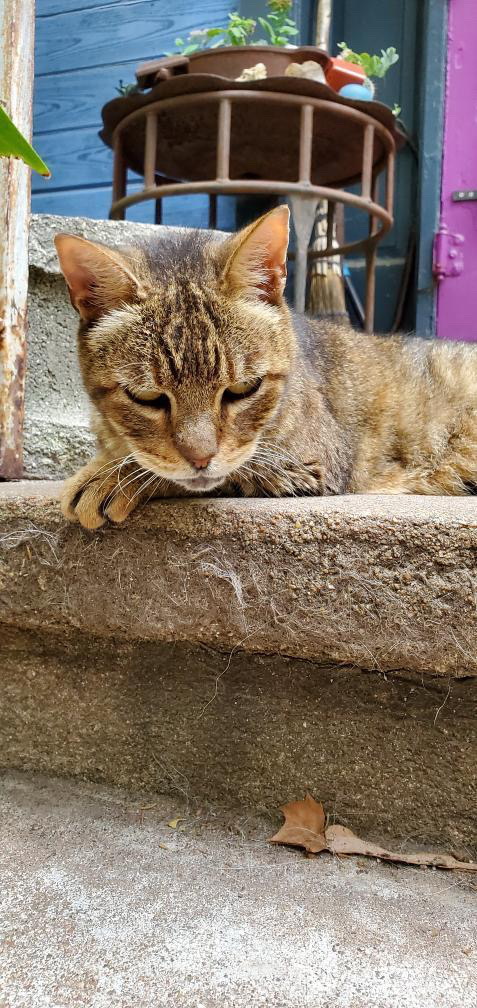 . Several of these beautiful photos (including this one) were taken by Katie Cowden, who would come to petsit for my animals, and captured Lowkey so beautifully. I’m so grateful to have these images now, and so thankful for Katie’s help and loving care for my critters.
. Several of these beautiful photos (including this one) were taken by Katie Cowden, who would come to petsit for my animals, and captured Lowkey so beautifully. I’m so grateful to have these images now, and so thankful for Katie’s help and loving care for my critters.
Lowkey was always stubborn, tough as nails, and extremely independent. When I got Rusty Jack Knife, the two became very close – always cuddling together and hanging out the porch together. They had a very deep, sweet relationship. It’s interesting, the way cats do that – or don’t. Lowkey and my last remaining, (but ever elusive) kitty Shrimp Scampi have never been fond of one another. I never imagined Lowkey would outlive Jack – not in a million years. Lokes always looked a bit decrepit, due to his crookedness after the dog attack, and a mosquito allergy that made him look very scabby and Chernobl-y.
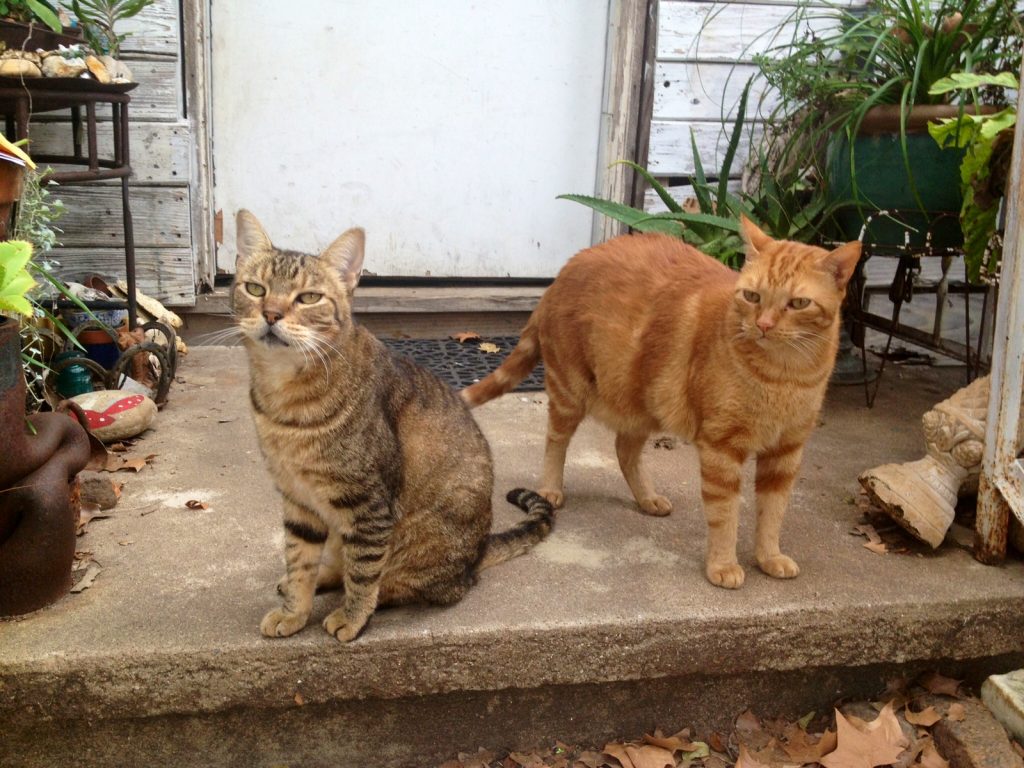 . The “bad brothers” – tough kitties protecting their turf
. The “bad brothers” – tough kitties protecting their turf
 . They loved lounging and cuddling together – especially in weird spots like metal sculptures, or on top of motorcycle seats.
. They loved lounging and cuddling together – especially in weird spots like metal sculptures, or on top of motorcycle seats.
October before last, Lowkey let me know that he was ready to be an indoor cat full time, and since then rarely left the kitchen – only making occasional nightly forays into the living room to be with the rest of the pack. He loved to snuggle with the dogs, and really just wanted to be close to us. He started have seizures not long after he moved into the kitchen, which resulted in him spraying pee everywhere. It got so bad, he was having several a day – until I figured out what was causing them, and got them under control. It was awful to witness, and no fun to clean up (amazing how much territory a seizing cat can hose down, man).
 Lowkey and I during one of the very rough spells where I thought I was losing him.
Lowkey and I during one of the very rough spells where I thought I was losing him.
Taking on any animal is such a huge responsibility. A lot of people don’t really stop to consider the fact that their pet might live for multiple decades, and require much attentiveness and care, depending on the state of their health. My first kitty, Junior (who I got as a kitten, when I was five), lived to be 21 years old. Lowkey was close to that. My border collie Thelonious lived to be 16. Caring for elderly animals requires immense patience, unconditional love, dedication, and devotion. It’s really not for the faint of heart. It is also expensive, messy, heartbreaking – and an incredible privilege that I wouldn’t trade for anything. I’m so grateful to have been able to care for these beloved, incredible creatures until the end of their days. They taught me so much.
Almost exactly a year ago, on January 9th (the day before my birthday) Lowkey vanished. I thought maybe he’d crawled off to a hiding place in the house to pass in peace, the way some animals do. The night of my birthday, there was a wild storm, and an eclipse. For days afterward, I called, and looked, and sniffed – hoping to suss out where he’d gone to. After no sign for 10 days, I finally gave up, and figured that he had hidden himself very well to die, or had been transported to another dimension. I cried as I moved his litter box out of the kitchen. It hurt – not being able to say goodbye, and not knowing what had happened. That evening I came home to discover him on the front porch, looking a bit dehydrated, but otherwise fine. Where did this ancient cat disappear to for 10 days? It’s still a mystery. All I can think is that he must’ve traveled to another dimension for a bit. Cats seem to surf between the worlds, in their dreams – and maybe even sometimes in waking life. They have powers that we’ll never understand – unless one day, we have the good fortune to be reincarnated as felines.
After that strange foray into other realms, Lowkey had a few more near misses – nearly dying in my arms at least twice after small strokes. But every time, he miraculously recovered. There were so many moments where I thought for sure that he was passing in my arms while I wept into his ratty fur, but then he’d get up and seem fine – apparently having changed his mind about dying that day. I lost track of each time I thought, “Okay, this is really happening – he’s passing right here, right now”. I’d hold him and sing to him and soak him in my tears, and then after a while, he’d stumble up, and go wolf down some food. He never lost his voracious appetite for kibble or for being petted and adored. Most recently, he crawled back behind the refrigerator. I was was absolutely sure he was dead that time, but managed to rouse him with a can of salmon and lured him out enough to grab him by the scruff and pull him out of the narrow space between the fridge and the wall. It was like birthing a baby goat. He was really out of it, and covered with dust bunnies, but thrilled to gorge himself on salmon.
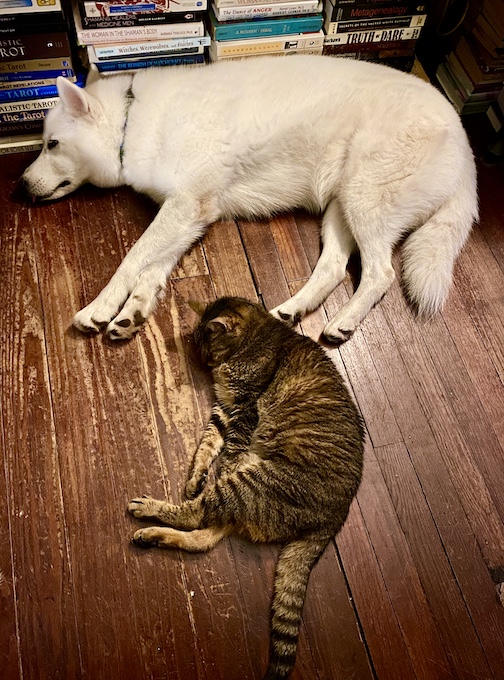 Snowy and Lowkey
Snowy and Lowkey
I hesitate to share this part, but I think it’s important, and I need to tell what happened, in the long saga of this badass brown tabby cat. (CONTENT WARNING: violence/gore/trauma) – I had to put Lowkey down because my wild white husky dog Snowy attacked him for trying to eat his food. Snowy has always had pretty bad resource guarding issues from being neglected before I got him, & Lowkey was basically blind and dealing with dementia & for some reason constantly tried to get into Snowy’s bowl (why did he ONLY want the food belonging to the one dog that would fuck him up, I have no idea). I was just thinking this exact thought, and had JUST moved him away from Snowy’s food & turned back to my own meal for a moment when it happened. I guess he went right back over there as soon as my head was turned.
It was bloody, shocking, & very traumatic. I didn’t see it happen, but I’m guessing it was a classic shake and toss. He had no external injuries, but likely internal damage to his lungs. Blood was coming out of his nose, and he was struggling to breathe. I won’t go into anymore of the gory details, but trust me – it was fucking awful. I held him and sobbed and wiped his bloody, bubbly nose and called my amazing vet friend TomCat to come and help him go. I’m so grateful to them for coming to help us – especially in a pandemic, and on such short notice.
Other than this incident, Snowy & Lowkey loved each other, & used to snuggle all the time. I don’t blame Snowy for what he did. He’s a husky, still fairly feral, and went through some stuff before he came to live with us. I blame myself for not paying closer attention. Normally I sit on a stool throughout feeding time to monitor for bad behavior from Snowy, but I was trying to finish my lunch before my tarot clients for the day, and made a bad call.
 Snowy and Lowkey snuggling
Snowy and Lowkey snuggling
Lowkey’s quality of life had been steadily diminishing pretty severely for a long, long time. He pretty much just lived on the heating pad I put on his bed, (and was constantly turning back on for him, because it shuts off after two hours). He was mostly blind, his back legs barely worked, and he wasn’t really making it into his litter box or grooming himself anymore. But – he was just SO tenacious! That cat lived through so many near death experiences. I had been long delaying making the call to put him down – until it was absolutely unavoidable. But Snowy made the call for me. I didn’t wanna put if down unless I could really tell he was in pain. And that day finally came.
I know it sounds odd or bad, but I’m kind of grateful I didn’t really have a choice. Or that my hand was forced. I’m trying to see that as a blessing in disguise, but it was just so rough. I know it was getting close to his time, but goddamnit – I’ve just never seen a creature cling so stubbornly to life. Even when getting his injection, it took several tries (old kitty veins blow out like whoa) and he clung on until the bitter end. Toughest cat, ever. It took some doing, his dying. It was a relief to see him finally at peace, not hurting anymore. But after TomCat left, I just sat on the floor in a sunbeam holding my dead cat and wailed for a long, long time. It’s still just so fucking hard to let him go.
It’s helping me, though – to think that Lowkey chose a warrior’s death for himself – that he was so determined to go on his own terms to Kitty Valhalla that he orchestrated a sort of “suicide by cop”, with Snowy unwittingly playing a part. He just had to go out with a bang, a big ruckus – no quiet passing in the night. I think on some level, I knew he wouldn’t go softly – though for months and months I’d wake up and peek into the kitchen, wondering if he’d still be alive that morning. He always was – though at times it seemed impossible that any creature so decrepit could continue to keep going, day after day. My kitchen has felt unbearably empty, ever since I returned my cat to the earth. It’s wild to realize what an enormous presence such a small animal commanded.
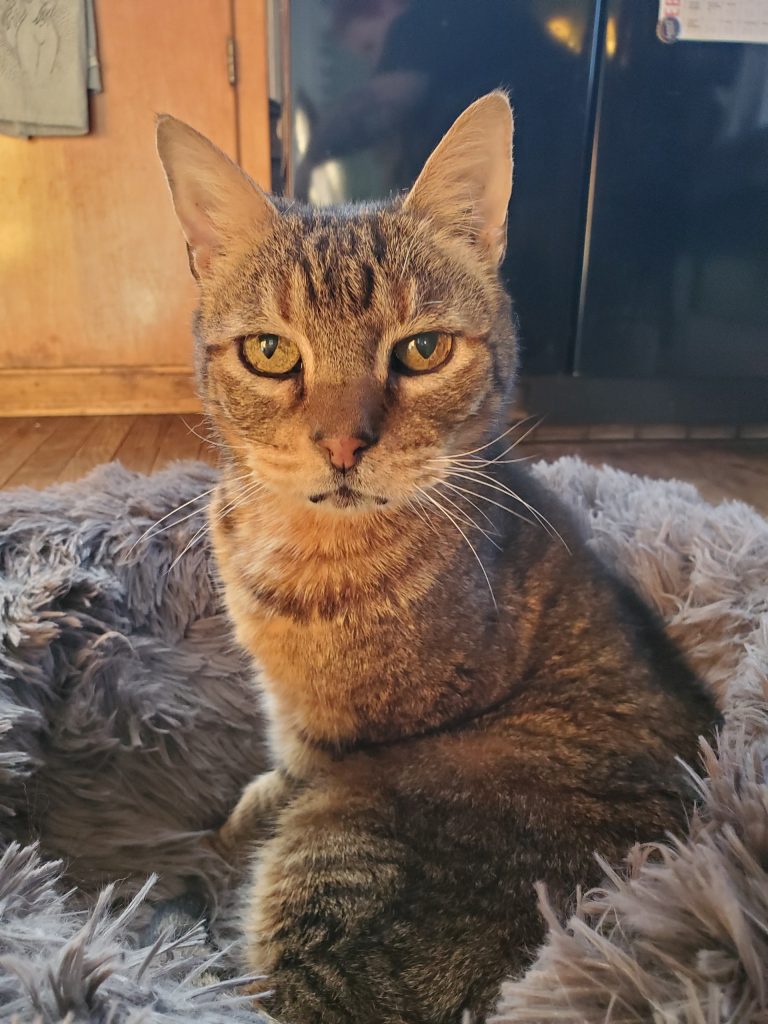 Before Lowkey, I thought of life as being very fleeting, and fragile – and, sometimes, it is. But he taught me that life protects life. Our spirits will keep fighting to be here, often long after our bodies have given up the ghost. That cat had no business being alive as long as he was – and yet… I think he just wanted to stick around for more lovin’, more sunbeam naps, more of everything. I didn’t want to get in the way of that. Not until I had to, anyway.
Before Lowkey, I thought of life as being very fleeting, and fragile – and, sometimes, it is. But he taught me that life protects life. Our spirits will keep fighting to be here, often long after our bodies have given up the ghost. That cat had no business being alive as long as he was – and yet… I think he just wanted to stick around for more lovin’, more sunbeam naps, more of everything. I didn’t want to get in the way of that. Not until I had to, anyway.
There were so many times I would just look at him in awe, and think – “HOW is he still alive?” His coat was stinky, because he’d stopped grooming himself, and tufts of tabby fur would sometimes just fall out in patches. He was like the Skin Horse, friend to the Velveteen Rabbit (if you haven’t read those books, or if it’s been awhile, I highly recommend having a good cry over both. They’re incredible.) Lowkey was always a real cat, rather than a stuffed animal, but – when I would pet his ratty coat, and love on him, I’d think – “Oh honey – you are becoming so, so very Real.”

“Real isn’t how you are made,’ said the Skin Horse. ‘It’s a thing that happens to you. When a child loves you for a long, long time, not just to play with, but REALLY loves you, then you become Real.’
‘Does it hurt?’ asked the Rabbit.
‘Sometimes,’ said the Skin Horse, for he was always truthful. ‘When you are Real you don’t mind being hurt.’
‘Does it happen all at once, like being wound up,’ he asked, ‘or bit by bit?’
‘It doesn’t happen all at once,’ said the Skin Horse. ‘You become. It takes a long time. That’s why it doesn’t happen often to people who break easily, or have sharp edges, or who have to be carefully kept. Generally, by the time you are Real, most of your hair has been loved off, and your eyes drop out and you get loose in the joints and very shabby. But these things don’t matter at all, because once you are Real you can’t be ugly, except to people who don’t understand.”
“I suppose you are real?” said the Rabbit. And then he wished he had not said it, for he thought the Skin Horse might be sensitive. But the Skin Horse only smiled.
“The Boy’s Uncle made me Real,” he said. “That was a great many years ago; but once you are Real you can’t become unreal again. It lasts for always.”
― Margery Williams Bianco, The Velveteen Rabbit

The day he died was so long, so traumatic, and so, so difficult. I felt like I got hit by a truck. I managed to get him buried by myself, though. I had my landscaper friends dig his grave at the beginning of the pandemic, so I wouldn’t be caught off guard when the day finally came. I cleared the hole of dead leaves, and put him in the earth, with flowers and herbs to bless him. I sang and cried over him, and pet his sweet black toe beans for a long time. Some wonderful mysterious person (who are you, sweet friend?) sent me a persimmon tree for my birthday, so I planted that over his resting place. He’s right near Rusty Jack Knife and Thelonious, now. I hope he’s with them somewhere across the rainbow bridge, cuddling and frolicking. If you’ve read this far, thank you for bearing witness to my and Lowkey’s journey. It was a lot to live through, for both of us – painful, scary, wonderful, but always, always worth it. I really needed to write all this out – for my own healing, and to bear testament to everything we went through together.

“Weeks passed, and the little Rabbit grew very old and shabby, but the Boy loved him just as much. He loved him so hard that he loved all his whiskers off, and the pink lining to his ears turned grey, and his brown spots faded. He even began to lose his shape, and he scarcely looked like a rabbit any more, except to the Boy. To him he was always beautiful, and that was all that the little Rabbit cared about. He didn’t mind how he looked to other people, because the nursery magic had made him Real, and when you are Real shabbiness doesn’t matter.”
― Margery Williams, The Velveteen Rabbit

Rest In Peace, Lowkums my love. You were the best, toughest, sweetest old man. I’m missing you so fucking much already – your grumpy little face, your short, curly white whiskers, your beautiful stripes that looked like the dark fudge-y ripple in Blue Bell Tin Roof ice cream. I miss your black lips, and your pale little chinny chin chin that loved getting skritches, and the way you used to drool on me when I’d pet you there. I miss your almost silent, raspy little meow, and your loud old cat snores. I miss all of you, buddy. Colonel Lowkenmuntz, fierce grizzled old sea captain. What a badass cat you were – tough as nails, and sweet as molasses. I love you forever. 💔
FALLING STARS + CACTUS FLOWERS
by angeliska on August 8, 2020
I don’t know whether I will ever be done writing about my mother. Last year, on this day, I thought I might be close. Close to being at peace, close to saying everything I’ve needed to say about her life, her death, and our brief and yet eternal relationship. Today, it feels endless again, boundless – the grieving, the writing, the call to honor her, to understand who she was to me and others who loved her in a deeper way. Maybe it’s this in-between time out of time that we’re in – the cascade of days marked less by happenings, travels, celebrations, events, or travels (all postponed, delayed, indefinitely canceled) and more by our ancient and eternal calendars – the ones our ancestors used to gauge the current of time: flowers blooming and going to seed, leaves greening, browning, falling, plants and animals growing, and the constant wheeling of celestial bodies overhead. Despite my adherence and attention to this more natural calendar, I still didn’t manage to get out to the country to dark enough night skies to witness the once in a lifetime passage of the comet Neowise, (or any of the spectacular meteor showers we’ve had this summer), but I found myself collecting incredible images capturing its passage across the heavens, fleeting, and yet – falling forever.
It reminds me of the comet birthmark carried by many of the characters in David Mitchell’s novels. That shooting star marked on their flesh somewhere in between the womb and whatever comes before, links the souls of these very different people over many stories, and many lifetimes. They are repeating reincarnations of one another, appearing again and again in different timelines, connected by that shooting star, forever falling. Fleeting. We are human, and the earthly envelopes we come in don’t last long, and usually don’t preserve well. But some part of us is eternal, is remembered, and is carried over to the next life, somehow. I do believe that. We leave little marks – scratchings in the stone that remain for centuries, our dearly-held mementos, our little legacies embroidered in DNA, embodied in our descendants.
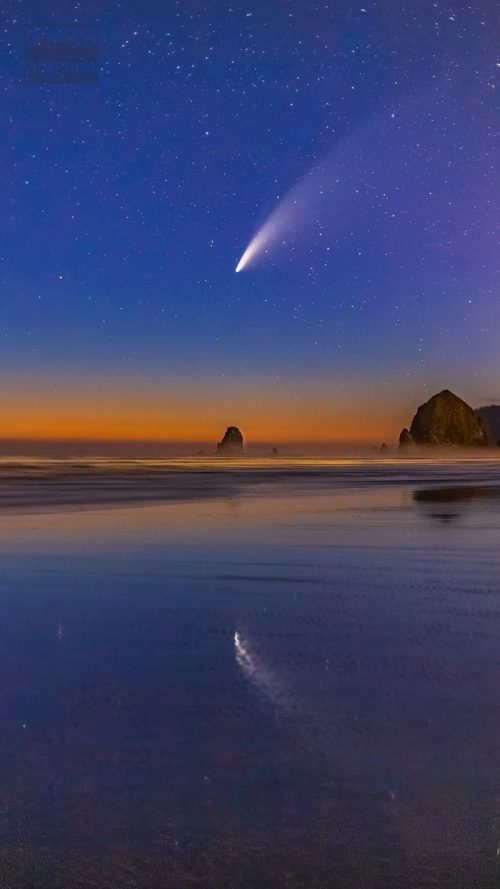
Bright star, would I were stedfast as thou art—
Not in lone splendour hung aloft the night
And watching, with eternal lids apart,
Like nature’s patient, sleepless Eremite,
The moving waters at their priestlike task
Of pure ablution round earth’s human shores,
Or gazing on the new soft-fallen mask
Of snow upon the mountains and the moors—
No—yet still stedfast, still unchangeable,
Pillow’d upon my fair love’s ripening breast,
To feel for ever its soft fall and swell,
Awake for ever in a sweet unrest,
Still, still to hear her tender-taken breath,
And so live ever—or else swoon to death.
– BY JOHN KEATS
I’ve seen the brilliant Jane Campion film Bright Star (based on the life and death of John Keats, and his ill-fated relationship with Fanny Brawne) a few times now – and recently recommended it to my dad, hoping we could discuss it after, since I knew he’d love it. He did, of course – and also brought up my mother’s obsession with both John Keats and Hank Williams – two star-crossed troubadours, who romantically, tragically died far before their time, “half in love with easeful death…” My dad and I have talked about this connection over the years – trying to understand why this woman we loved came to idolize these two geniuses that torched across the skies in a blaze of glory, only to gutter out prematurely – one in Rome with ruined lungs and mouthful of blood, and the other of morphine and whiskey induced heart failure in the back of a Cadillac in West Virginia on New Year’s Eve.
The woman who cherished
her suffering is dead. I am her descendant.
I love the scar tissue she handed on to me,
but I want to go from here with you
fighting the temptation to make a career of pain.
– Adrienne Rich, from “Twenty-One Love Poems”
When I watched the film the second time, what really hit me was what a fucking raw deal it was for poor Fanny Brawne – who’d found this deep true love with a doomed poet, and then lost him. The depiction of her grief is utterly wrenching, bottomless. I recognized myself in it – the hopeless fury of that immense loss that has ways of completely directing and shaping everything that comes after it – the course of your whole goddamn life. Meanwhile, Keats swans off into romantic immortality – and Hank too, leaving behind his own young bride, Billie Jean. Those two women were left to define themselves outside the shadow of their dazzling lovers’ arcs through life and death – how in the world did they manage it? How do I? Like this, I suppose.
Writing about my mother is one of the few ways I have to know her, to explore my relationship with her – and to know myself, through my loss of her. One of the other ways I get to know her is through the stories people who knew her tell me, about what it was like to know her. It helps me and heartens me to think that even thirty-four years after her death, my mother’s old friends who knew her back then still remember her, still think of her, and still carry these stories about knowing her.
I’ve been thinking a lot about friendship lately, particularly during these pandemic times, when most of us cannot be with our friends, can’t hang out, safely go to each other’s houses, or do any of the things together that we all used to take for granted. I really miss snuggling with my friends. I miss dance parties, and crowded concerts, and playing dominoes and drinking cocktails on patios. I miss it all – the physicality of friendship, of love. Sometimes I think that’s why I cling to and treasure earthly objects and mementos the way I do. I spent a lot of time alone as a kid, and really didn’t have many friends (like really, only one or two – and sometimes none) until I became a teenager. I learned to be self-sufficient early on, left at daycares and then was a latchkey kid for years.
You could say that my mom’s primary love languages weren’t touch or spending time – so even before she died when I was seven years old, I was already bereft of a lot of the affection and attention children really thrive on. It’s probably no wonder that transitional objects like teddy bears and dolls never managed to transition out of my arms even as I grew up (yes, I still sleep with a stuffed animal!) and that I still save every letter anyone’s ever sent me. The physical objects my mother left to me are as much of her body as I can ever be close to. If I finally learned to play her guitar and fiddle, perhaps I could hold them to my body and it would feel like holding her, or being held? I dreamt once that I got to hug her – but in the dream I was grown, and she was in her twenties, hair in a ponytail, wearing cut-off jean shorts. She was surprisingly small – more delicate than I remembered back when she was the biggest thing in my life, even as she was shrinking away to nothing – cancer eating her life-force, her body that bore me, that fed me, that made me.
There is the experience of knowing my mother when I was a baby, when she was my everything, and for nine months, my world entire – the bubble of her flesh enclosed around me, my first home. I imagine I can see her in my first year of life outside her body – my blurry vision resolving as our faces bumped, my unsteady stem of a neck bonking my head into hers like a top-heavy sunflower. Surely that happened, right? I’ve seen mothers and babies in that posture hundreds of times – so maybe my child self can remember being so near, up close – able to count her every freckle, every gingery eyelash. But now – she’s farther away, somewhere off in the distance, transparent, elusive. I grasp at threads, and and left holding palmfuls of petals and smoke. Sometimes I wake up from dreams where I’m trying to find her, but she’s nowhere. It feels like cactus spines, lodged in the tender meat of my heart – impossible to pull out.
“The mystical path is to return to our longing even when the pain of separation is excruciating. This is why longing is in the root of belonging. To be longing for what the soul hungers after, even when that hunger can not be satisfied, is to be truly alive. Paradoxically, it is in our deepest presence with those absences in our lives that we are returned to coherence.”
– an excerpt from “Belonging: Remembering Ourselves Home” by Toko-pa Turner

I’ve been leafing through my mom’s old scrapbooks again recently, as I often do when her death anniversary approaches. I have three of her glorious painstakingly collaged archives of life in early 1970’s psychedelic-folk era Austin. They are true treasures – time capsules of a lost Austin, replete with concert posters and ticket stubs, scraps of sketches, little paintings and love-notes, handmade valentines and incense wrappers, images of paintings cut from art books and magazines, and page after page of photographs of favorite musicians and old buddies and long dead beloved canine and feline companions interspersed with flowers cut from seed packet envelopes. They tell you so much – about what life was like, about what was important or exciting, what was worth saving, hanging on to, and remembering. I learned the hard way after Hurricane Katrina that a box of random scraps and photos stuffed in an old shoebox rarely survives the passage of time, or gets saved from the rubble. Scrapbooks like the ones my mom made, on the other hand, are rare documents – colorful testimonials to the zeitgeist of the wild and beautiful scene that existed here back then. They tell a coherent story, and preserve the memories of the dead.

This was the heyday of hippies and “heads”, of cool chicks and far-out folks congregating on colorful blankets at love-ins at the park, groovin’ at various shows and hang-outs, pickin’ parties and “red bean busts” in tiny Hyde Park bungalows – goofing off on front porches, smoking weed, listening to records, making art, and getting weird together. I lingered longingly at all the pictures of my mom and her pals hugging and rolling around, sitting smushed sardine-like on ratty sofas rolling joints, singing old country songs. Those were different days – before anyone knew what HIV or COVID-19 even were. Invincible days.
I wonder how many of the people in those faded photographs are still alive, now elders with many stories about living through those strange, heady times. My mother documented their vibrance, their flaming, glowing youth – all flowing long hair and bushy beards and big stoned smiles. She even managed to inscribe each of their zodiac sun sign symbols next to their names. For years, I’ve pored over those pages, and have been so curious about all the people so lovingly preserved within them. I’ve managed to track down a few of them, over the years – with varying degrees of successful warm connection. I’m going to share a few of those, below. I pray that the others I never managed to find, and who are still among the living will stay safe and healthy through this bizarre plague that is keeping us away from one another. I’ve been thinking about how many people will lose (and have already lost) beloved friends and family to the scourge that is this coronavirus. They say that you don’t know what you have until it’s gone.
I cling to the little snippets of casual knowledge about her, gleaned dearly from the people who knew her, who will occasionally drop a story or a reminiscence – a puzzle piece I can add to my forever unfinished portrait of who she was. Sometimes, it feels futile – knowing that I’ll never find all the scattered fragments that make up a whole, with the awareness that the big picture of her and who she was, who she still is, is always changing.

I must have gotten my passion for marbled paper from seeing the pieces of it she’d saved – and I realize over and over how much my sense of beauty and aesthetics was informed by my mother, by what she found to be marvelous and magical. I’ll never know what is nature or nature with us – what was her influence, and what are the ways we are just similar, the things I inherited from her, down to my taste in art and decor. I know that there are gestures I must make, postures that my body holds that retain an unconscious echo of her. It’s strange to think about. A couple of years ago, my Aunt Ruthie told me about my mom’s love of baths. I am also a dedicated bath taker, so it was fascinating to hear that my mother had to have her “soak” every day, no matter what. I like to imagine us communing somehow, in that bathing ritual.
I remember her friend Cathleen telling me that my mother’s favorite gemstone was the Mexican fire opal, (sometimes called a jelly opal) with its flashes of orange and violet, and that her favorite flower was the night blooming cereus. I would never have known that, otherwise. I would have guessed roses, or maybe irises. I knew she loved cactus flowers, and we had some that bloomed pink and fuchsia I remember her always being very proud of, and delighted by – but she never had a cereus (or any fire opals), I don’t think. There were a lot of things that my mother loved and wanted that she never got to have. Not in this life, anyway. Cactus flowers are usually quite ephemeral – even more than hardy wildflowers or garden blossoms. The night-blooming cereus often flowers only briefly, and in secret, under the cover of shadows. You have to be nocturnal to catch it making itself available to its pollinators, mostly moths and bats. I had a vision once where I shapeshifted into one of these outrageously beautiful beings – though I was a San Pedro cactus. It was wild – the sensation of being so extravagantly protected by my own sharp armor, shielding the moist green tenderness of me from the munching mouths of desert dwellers. A top my head, (or perhaps the flower was my head), I expanded my magnificent petals into enormous white lotus-like flower, attracting winged creatures to delicately sip my nectar. This vision made such an impression on me, that I’m turning it into a future Mardi Gras costume, if we ever get to frolic in the streets together ever again, that is… I want to embody that dazzling desert warrior queen – all intoxication, and fierce grit. So tough, and so exquisite.
It makes sense – my mother’s passion for cactus flowers, and that the cereus would be her favorite. Especially considering that she painted them into the two mystical portraits of Hank Williams she did, garlanding his image with their blossoms. The fleeting blooms forever fresh, immortalized along with Hank, framed like a Russian icon. An altar for her favorite country music martyr – the patron saint of lonesome cowboys.

“Hank Williams – Icon” by Maggie Polacheck
I sent a photograph of this painting to a man who knew my mother, briefly. He reached out to me with a memory of her he’d been carrying all these years, and told me he’d be honored for me to share it here:
“Please excuse me for intruding in your life, but I was thinking of your mom, Maggie, this morning. I knew her for a short time back in 1976, and I thought if you were amenable to the idea, that I might share my remembrance of her.
I lived in Austin for about a year and a half back in ’76-’77, or maybe it was ’75-’76, when I was stationed at Bergstrom AFB (now an airport of some kind). I don’t know what Austin was like before that, but I like to imagine that I was there at the pinnacle of its weirdness and that the decline began maybe ten years or so after that. I could see the change when I was there last, about fifteen years ago.
When I lived there, Half Price Books was located in an old ramshackle building on Lavaca near the Capitol, and they had a store cat named Toby, who curled up in a big plastic bowl of free bookmarks. There was this really nice arts & craft/flea market on weekends just off of The Drag, right across the street from the main campus of UT. You could still see classic movies at The Paramount. When the renovation efforts there reached a certain point, the movies stopped and they had ‘events’. Threadgills was still in the old filling station way out on Lamar, and hadn’t yet morphed into the upscale place near Barton Springs that it was the last time I was there. Schlotsky’s was still a funky little hole-in-the-wall on Lamar. And there were so many other places that don’t come to mind right at this moment.
Now, from what I hear and from what little I remember of my last trip there (about fifteen years ago, I think), it seems kind of like the entire city got gentrified. There’s a line in ‘Drifting Way of Life’ by Jerry Jeff Walker – ‘the real estate boom came roaring through my yard.’
And there were meetings of The Friends of Old-Time Music at The Split Rail (unfortunately no longer extant for some years), and fiddle lessons at Heart of Texas Music.
And since I’m here, and one memory triggers another…
There was the time my fiddle teacher invited me over to her house one Saturday. No, nothing like that, but you have to know that I was still young, twenty something, married only a year and a half or so, still pretty shy with women and strangers in general.
I was taking fiddle lessons at Heart of Texas Music from this lady, this girl, just a year or so (I think) older than I was. One day she invited me over to her house in the Hyde Park neighborhood to listen to records. At the time, as I remember, Hyde Park was an old neighborhood in decline, much like Fairmont in Fort Worth; it’s probably completely gentrified these days. I was really unsure about going. She had no ulterior motive, and it never occurred to me that she did, but I was still nervous, because, I suppose, one might say I was still working out all this man-woman stuff. Plus, I’ve never been one to, I don’t know, make friends at the drop of a hat the way some folks do.
So I went, and it is one of my fondest memories, not just of Austin, but of my whole life. She showed me around her house, and I remember a portrait of Hank Williams that she had painted. Based on a common photo of him that you would probably recognize, it was kind of stylized, with purple as a predominant color. I don’t know if it was her intention, but it brought to mind that line from ‘I’m So Lonesome I Could Cry’: ‘The silence of a falling star lights up a purple sky.’ I also seem to remember a painting of sunflowers, or maybe it was big white daisies. Or maybe I’m misremembering one painting as two different ones.
And her records. I remember one wall in a room that was solid LPs from floor to ceiling, mostly old-time music. Her husband (boyfriend or partner or whatever at that time, and who wasn’t present that morning) played old-time banjo, uilleann pipes, and fiddle.
So, the upshot of it was that we sat around and listened to records and talked music. Recently, at Doc’s Records (in Fort Worth), I came across one of those records that we listened to that day – Traditional Music For Banjo, Fiddle, and Bagpipes’ by Franklin George. I’d only seen it that one time, but I knew it as soon as I pulled it out of the bin, and, of course, I bought it; I would’ve snapped it up at twice or three times what they were asking.
A few years back, probably six or seven, I was thinking of making a trip to Austin, and I had it in mind to look her up while I was there. So I googled her, trying to find out if she was still in the area, and almost the first thing I found was a picture of her gravestone. I searched a bit more to try and make sure it was her. I didn’t find any specifics, but apparently she was stricken by something that was quick and bad, and she was gone in 1986. I will freely admit that I cried.
Truth is, I probably had somewhat of a crush on her. She was one of the prettiest girls I’ve ever known with a voice to match. Things happen as they happen, but one sometimes can’t help wondering how things might have been different.
That’s the end of the original remembrance.
I also remember hearing her and Dave play at a Friends of Traditional Music meetings at the Split Rail and at least one festival in Zilker Park. I remember showing her the new fiddle I had bought to take with me on my first tour in Korea in ’76, so I wouldn’t have to take my nicer one, neither of which I have now. I remember the fiddle lessons and trying to learn ‘Soldier’s Joy’ and ‘Flowers of Edinburg’.
I remember my Mom and Dad coming to visit from Fort Worth, and I took them to see her and Dave and, I think, her sister (on flute) play at a small cafe or bar. I just don’t remember exactly now, but it was someplace where one could have a Guinness. They called themselves something with “mule” in the name, I think. Or maybe the name of the establishment had “mule” in the name.
So, there it is, such as it is. It’s not much, but I sincerely hope that you find some value in it. Your Mom was a special person, and looking back, I think how nice it would have been to know her better or to know her still today, especially now that I have more music under my belt, so to speak..
I’m sure there are lots of other memories bubbling around in my mind, but what I remember most of all is how pretty she seemed to me at that time and how nice she was.
Memories are such slippery things, but I can almost remember standing in the hallway in Maggie’s house that day when she showed me this painting.”
– Clark Weddle
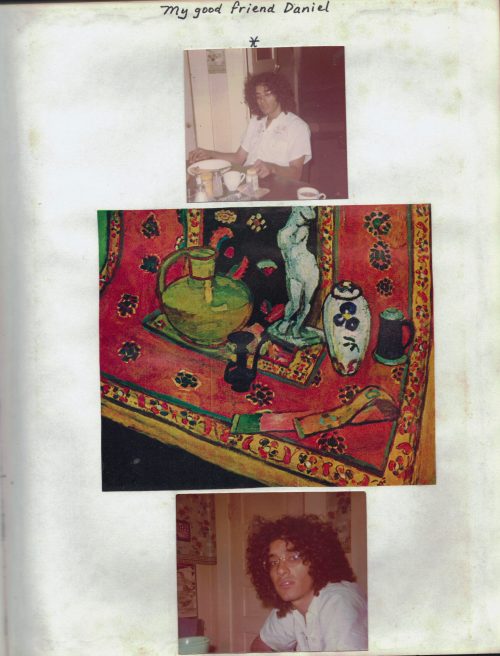
Back in 2011, around the time that I really started honoring my mother’s death day in earnest, I was thumbing through her scrapbooks and noticed a guy that seemed familiar to me. I’d recently been at a caucusing event for the upcoming election at the time, and had seen this person who just really caught my attention – Daniel Llanes, who is a local activist, dancer, mystic, and musician here in Austin. I reached out to him, and it turns out, he was indeed the one in the photographs. We’ve stayed in touch over the years, and on one Day of the Dead, he invited me to his house to sing and dance in traditional Aztec ceremony to honor our beloved dead with he and his daughter. I’ve never forgotten that experience, and was so grateful for his kind welcome, and to see the portrait my mother painted of him all those years ago in person.
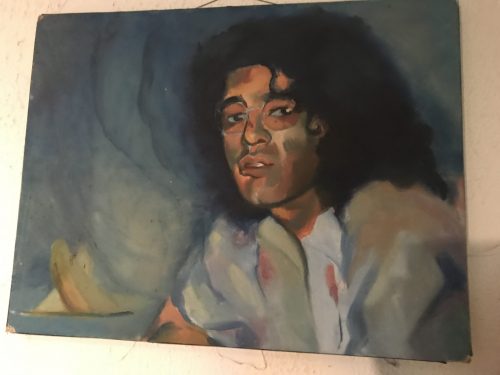
A portrait of Daniel Llanes – by Maggie Polacheck
During the quarantine, I found myself wondering how he was doing, as I’ve been worrying about all our precious community elders experiencing life during this pandemic. I reached out again the other day, and we had a wonderful long conversation about music and magic. Later that day, he sent me this letter (I’ve shared a portion of it here, with his permission):
Hi Angel,
Thank you for reaching out and talking with me today. So unexpected and surprisingly nurturing. Not only because of the isolation we are experiencing these days, but because it is you. You who I never see and has such a connection with my personal and intimate history.
Being an artist in America is unique and there are very, very few people who actually are that. Your mom and I became such cheerleaders for each other the moment we met. She immediately appreciated and matched my passion for the language and lifestyle of art. I can remember the first time we looked into each others eyes, brightness, wonder, enthusiasm – like, “ooh, what’s this about?”
Beside talking and feeling such commonality with you today, after our talk I actually missed you, and you have been in my thoughts all day. Missed you because you are part of one of the people who I felt so in sync with in so many ways, almost like missing her. She painted my portrait for god’s sake.
I knew your mom in her freedom and we had a lot of great times, fun public events and deep personal moments. That was one phase of our lives. Once she was married we didn’t see each other for a while, then I got to know your dad, and that started another era. And now you reach out. And of course, who you have become is even more fascinating now than when we first met, you and I.
Fascinating about bloodlines. We are the current versions of our bloodlines. When my grandmother died (raised by her) about a week later I started recognizing her in my gestures, mannerisms , speech patterns, laugh, and I noticed, even now, my yawn sounded like my grandfather’s yawn. Double fascinating…So even though they are now invisible, they are visibly embodied in me.
These days I’m of the opinion that all is happening as it needs to, and timing is everything. Last time you reached out, I felt that bloodline energy in you, almost a tease, too brief. I’ve thought of you over time and did invite you to sing and such, but that didn’t happen, and I did not want to be pushy or presumptuous. So thank you again for reaching our and sharing your light with me once again.
I see you in her, I see her in you.
Thank you for sharing your mom’s commemorance and making me aware of it. I read what you wrote, beautiful. I loved the pictures. You, like her have a very unique look, and feel. And yes to all that you touched on. And the passing of life, the days and nights with sun, moon and stars ever pulsing as we move towards perfecting our union with the Creator. That’s what art, the spiritual pursuit, is to me.
You are a unique person, and like her, one of those so few and far between. I am hopeful that we can get to interact and share some time and space going forward.
–Daniel
We talked the other day about this story I remember my dad telling me, about the time Daniel lost his precious vintage Martin tenor guitar, his main songwriting instrument, in the trunk of a hippie couple’s car he’d hitched a ride with from San Antonio. They dropped him off on the Drag, and drove away before he realized that he hadn’t gotten his guitar from them. There was no easy way to find those folks again (no mobile phones or social media!), and Daniel was totally distraught. He went to the garage apartment behind the duplex at 4302 Avenue G where he was living with my mom and their friend Lenore (or with my dad – everyone’s memories are a bit fuzzy on certain aspects of this story, it being over four decades ago now…) They all sat down and problem solved about how he would conduct a search for it, but this was long before internet, of course – so they were talking about flyers and knocking on doors. My mom then sat down at their kitchenette table and pulled out her Albano Waite (Pamela Colman Smith) deck – (the same deck that I would later inherit at age 11, sparking my path towards becoming a tarot reader!), and did a tarot reading for the situation using the standard (for the time) cross layout. The only card my dad remembers is the outcome, which was the Star (non-inverted). From this, my mother concluded that Daniel would recover the guitar, which relieved his mind greatly, and as it happened, he did get it back some weeks of effort later. My dad also cast an I Ching oracle at the time, which he concluded was saying the same thing as the cards. It’s funny, but Daniel didn’t remember anything about the readings my parents did, as he was probably too upset at the time – but a few weeks later, somebody called the house, and miracle of miracles – the precious Martin guitar was returned!
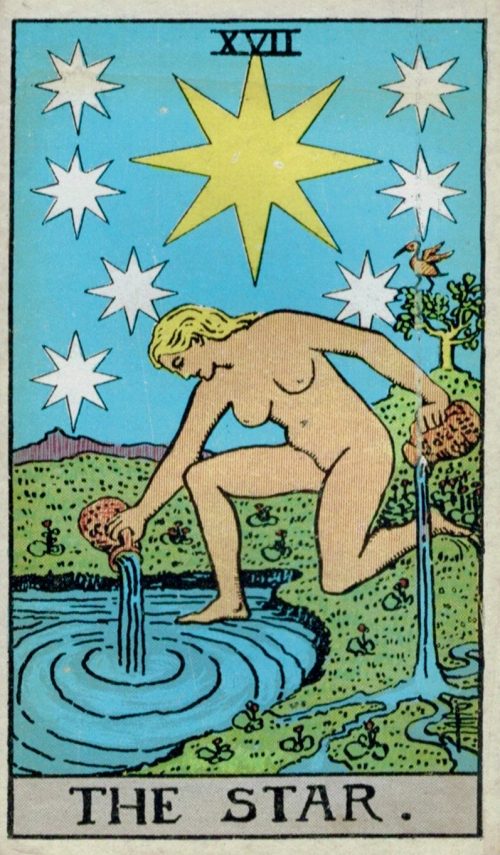
I’ve been thinking a lot about the voluptuous solitude of The Star card – and how even in the midst of this craving for connection, I’ve been finding so much solace in the poetic quietude of this alone time. The Star is all about the place we arrive at when everything else is stripped away, and all we have is ourselves. This card reminds us to have faith in who we really are, and to let our strange magic and beautiful light shine. There is a deep peace that can be accessed by learning to be truly present one’s self – and in knowing who you are and being entirely comfortable with that person. The Star is a powerful emblem and guide for artists, weirdos, and all non-conformists – people who have learned to let their freak flags fly! It’s a lot easier to do when we remember that we are all made of stardust, I’ve found.
Counting The Stars At Night
(별 헤는 밤, 윤동주)
Up where the seasons pass,
the sky is filled with autumn.
In this untroubled quietude
I could almost count these autumn-couched stars.
But why I cannot now enumerate
those one or two stars in my breast
is because the dawn is breaking soon,
and I have tomorrow night in store,
and because my youth is not yet done.
Memory for one star,
love for another star,
sorrow for another star,
longing for another star,
poetry for another star,
and oh! Mother, for another star.
Mother! I try to call each star by some such evocative word,
names of school children with whom I shared desks,
names of native girls like Pai, Kyunh, Ok,
names of maidens who have already become mothers,
names of neighbors who lived in poverty,
names of birds and beasts
like pigeon, puppy, rabbit, donkey, deer,
and names of poets
like Francis Jammes and Reiner Maria Rilke.
They are as far away
and intangible as the stars.
Mother!
You too are in the distant land of the Manchus.
Because I have a secret yearning,
seated on this star-showered bank,
I have written my name thereon
and covered it with earth.
In truth, it is because the insects chirp
all night to grieve over my bashful name.
But spring shall come to my stars after winter’s delay,
greening the turf over the graves,
so this bank that buries my name
shall proudly wear the grass again.

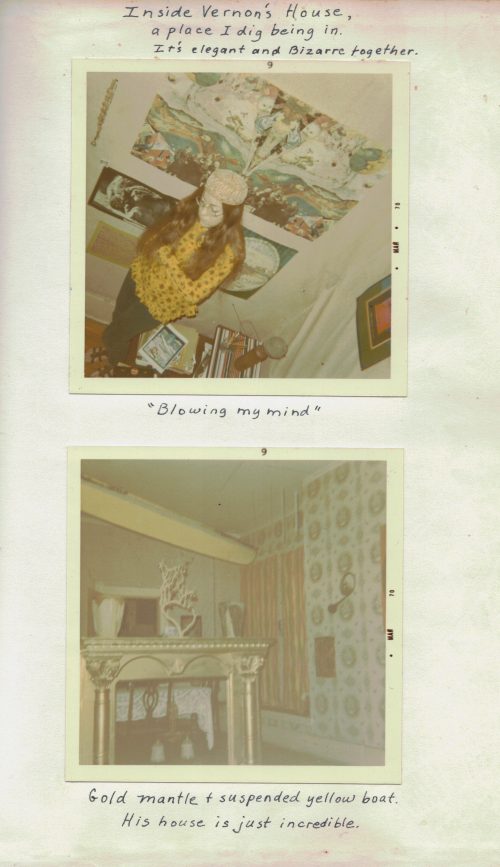
Vernon Reed was another one of my mom’s friends who made a profound impact on her life. My mother loved Vernon’s amazing house with his golden mantle and yellow boat suspended mid-air, and his trippy bathroom with the cocoons of plastic sheeting filled with fairy lights. I always heard stories about what a character he was from my Aunt Ruthie, who remembers him as being one of the most creative and fascinating people they’d ever met – a true one of a kind star!

He and my mom both made silver jewelry (which inspired me to become a silversmith, too), and years ago, Aunt Ruth gave me this pendant he’d made for my mom – a star and crescent moon, one of my most sacred symbols) inlaid with garnets, which was her birthstone – and is mine, too. It’s probably my most treasured possession, along with her fiddle. I wore it almost every day for many years, until the finding got worn out – I need to get it repaired, so I can safely wear it again without fear of losing it.
Vernon and I have emailed back and forth too, over the years. I pray that when it’s safe to, we can get together, and finally meet in person – and that I can see some of the paintings he has that my mother gave him. It’s something to look forward to. I see a kinship in my mom’s friends – they are my kind of people, too. In reaching out to them, and making connection, I’ve found some likeminded kindred spirits – artists, iconoclasts, poets, and wild-eyed dreamers. Through knowing each other, we get to repair a piece of the puzzle that got lost when she left this earth. We can re-form the constellation of spirits that still inhabit this plane of existence, connecting via the spirit of one who is no longer in her body. Her art, her photographs, her stories are the threads that join us together, the ways we keep from getting lost in the dark morass of time and forgetfulness. This is the alchemy of healing, of honoring that art and writing provide for us. I am so grateful for it, and for them – for these bright stars lighting up the horizons of my life, calling to me over great distances, constantly falling, illuminating, dying, shining – for eternity. In our lifetimes, and beyond.
“I think of you often. Especially in the evenings, when I am on the balcony and it’s too dark to write or to do anything but wait for the stars. A time I love. One feels half disembodied, sitting like a shadow at the door of one’s being while the dark tide rises. Then comes the moon, marvelously serene, and small stars, very merry for some reason of their own. It is so easy to forget, in a worldly life, to attend to these miracles.”
– Katherine Mansfield
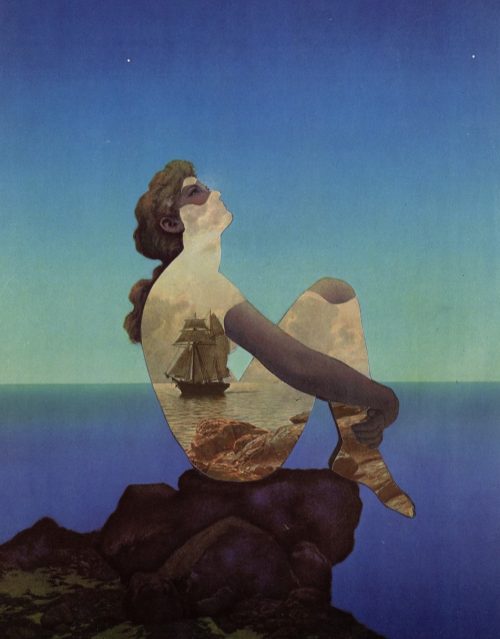
Artwork by ØJERUM
(the spirit likes to dress up)
The spirit
likes to dress up like this:
ten fingers,
ten toes,
shoulders, and all the rest
at night
in the black branches,
in the morning
in the blue branches
of the world.
It could float, of course,
but would rather
plumb rough matter.
Airy and shapeless thing,
it needs
the metaphor of the body,
lime and appetite,
the oceanic fluids;
it needs the body’s world,
instinct
and imagination
and the dark hug of time,
sweetness
and tangibility,
to be understood,
to be more than pure light
that burns
where no one is –
so it enters us –
in the morning
shines from brute comfort
like a stitch of lightning;
and at night
lights up the deep and wondrous
drownings of the body
like a star.
– Mary Oliver
If you’d like to read more about this journey
of grieving, honoring, and remembering my mother,
here is an archive of my writings about her:
DOUBLE ETERNITY
MY ANGELIC INHERITANCE / THE HOLOGRAPHIC WILL
38 ON AUGUST THE 8TH
30 YEARS – SEIZURES
888 – HONEY BABE, I’M BOUND TO RIDE – DON’T YOU WANNA GO?
WILD BLUE YONDER
NO ROOM IN MY HEART FOR THE BLUES
FAMILY VACATION – HANK WILLIAMS’ GRAVE
STAR-CROSSED TROUBADOURS
Foxes in the Rain
Triumvirate Lemniscate
Gustav + Mama – August 8th
DOUBLE ETERNITY
by angeliska on August 9, 2019
This morning found me doodling figure eights, looping curves of lemniscates making fanciful arabesques in the margins of my diary. I sat at my kitchen table on this bright summer morning with a candle lit, writing. My friend Sophia Rose brought me the most extravagant double stargazer lilies in a brown glass bottle, to honor what this day is for me. They are exquisitely fragrant, filling the room with their scent, and drifting russet pollen over my page, my arms. My eye and mind comes to rest on this picture that hangs next to me as I write, something I picked up at my favorite antique store, where I used to work. It’s a postcard set into a vintage frame over an old handkerchief decorated with cabbage roses. I took the frame down from the wall, and pried the backing loose to peer and see if anything was written on the back of the postcard (nothing was), but I learned the image was from a watercolor by the the Swedish Art Nouveau painter, Carl Larssen. Modellen skriver vykort – Model Writing a Postcard. A naked woman sits at her table, writing a postcard, papers spread out all over, a vase of peonies and pussy willows fainting in the bright air from the open window – a look of total absorption and contentment on her face. Her body and her hair are like mine – and so many mornings, I echo her pose, with my writing, at my table that is just for me. There’s a delightful solitude in this picture – in her mind, she is alone, totally comfortable, not being spied on by anyone. She has no responsibility, no need to wear any clothes – and the total freedom to concentrate completely on whatever interests her, without the distractions of a family, or of children. That’s what my life is like these days, and sometimes it feels a bit alarming, but mostly it’s wonderful.
This picture also reminds me of my mother. The woman has exactly the kind of furniture she loved – elegant arts and crafts style precursors to Art Deco. She had an original Stickley dining set that somehow got lost or sold somewhere along the way. When I showed this to my Aunt Ruthie, she told me a story I’d never heard before – about how my mom used to go around the house all the time wearing absolutely nothing but a pair of red Converse hi-tops and a plastic shower cap. So part of me wants to make a version of the woman sitting at the table wearing these accessories, too. I love contemplating this side of her that I never imagined – an irreverent, playful and silly version of Maggie that I don’t remember ever meeting. Mainly because, by the time she’d had me, her time for lounging around naked at the kitchen table writing postcards was long gone. It’s ironic that this was most likely one of the big sources of resentment and tension in our relationship – how little time she had while juggling motherhood and scraping by at work to just be a person, to hang out with no clothes on, doing whatever she damn well pleased. More ironic still, is that this is my life exactly, for the most part. I’m living my mother’s wildest dreams. I’m totally free.

Thirty-three years today, my mother died. She let go of her body in a little bedroom in her parent’s home, built for her grandmother, in a tiny ghost town in Texas. Where she went from there, it’s impossible to know. Lately, I like to think that even though she didn’t choose her death, that perhaps some part of her chose to leave this earth on August the 8th, a day touted by many spiritual teachers to be the Lion’s Gate, a portal that opens up every year on this day – through which we can step into some kind of fiery and passionate infinite empowerment. This year’s astrological alignment apparently also coincides with the the beginning of a new galactic cycle. The last one began about thirteen years ago, when I was twenty-seven. It was around that time that I really began this journey of actively grieving my mother’s death, and started inquiring into the dark passages of my memory, where I’d stowed so much I hadn’t been ready to deal with yet.
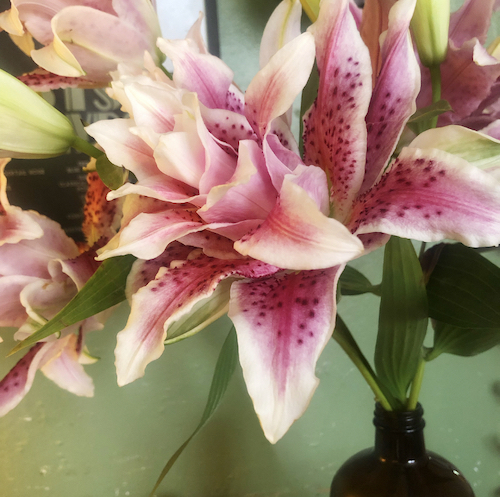
Throughout my entire childhood, since the day she became ill – when I was probably about five years old, I’d been running. After her death when I was seven, I started having recurring tidal wave dreams. I had them all the time, for years. They were terrifying, disorienting, and strangely captivating. I’d be standing on the beach, and notice something rising over my shoulder, over my head – a gargantuan, shimmering, moving wall of water, rushing towards me faster than I could outrun it. I’d wake up before it hit, with the panic and terror of trying to escape that total annihilation vivid in my mind, my heart beating fast. For awhile, I thought that perhaps I’d had a past life in Atlantis, or some other ancient place lost to a giant wave. When I started studying the language of dreams, I realized that water usually symbolizes feelings, I finally understood what I had been running from all those years – an enormous wave of emotion that I had no idea how to deal with, the fear of drowning in tears. For a long time, it remained too big, too much. When I started to delve into those overwhelming feelings, the dream started to change. Sometimes, the wave would crash over me, and I would come to, floating in the water, grasping for my sodden suitcases which I’d been running with. Papers and photographs drifted around me, and I’d try to gather them up. I was alive, though I had lost some precious things. The waves would take the photos and the letters before I could collect them all.

These dreams were trying to tell me that I could stop running – that it wouldn’t kill me to turn around and face that grief, let it crash over me. That I’d be still alive after the waves receded, though soggy with saltwater, tears – and that I’d lose things. That I’d be trying to not let all the memories, the words, the stories slip away from me once I became strong enough to remember. That’s why I started writing about her death, and all the ways that it changed me, altered irrevocably the course of my life. Through that process, I’ve been able to see how much the work of healing has also changed me, and changed the way I grieve. Writing gives me a way to remember, to learn how to put back together that which has been dismembered, shattered, lost. There’s so much I don’t remember – because the trauma of loss has blocked it out, or because time erased it, or because I was too young to be able to understand it in the first place. Most of the people who experienced this loss with me choose not to remember, or not to talk about it much. They are still too lost in their pain, and set in their ways. They’re getting older, and so am I. Soon, who will still remember? In remembering together, we make ourselves whole again. This is how we heal – if we’re willing go there, to feel it all, to do the work.
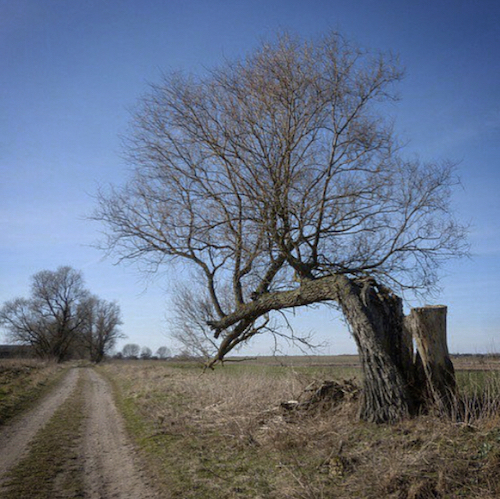
I recently came across an image of a lightning struck tree – with a description expelling the concept of traumatropism, or “a modification of the orientation of an organ (as a plant root) as a result of wounding.” It’s also described as the “regrowth of a plant or tree, often in a bizarre shape or direction, as a result of earlier damage or trauma, like a lightning strike.” I looked at that image of the broken tree, and recognized myself. I was forced to grow in a different direction, all my tender green sprigs coming in at odd angles – due to the trauma of my mother’s death, and to the trauma I experienced in our relationship before she died. That loss, that castastrophe – it shaped me in ways I had no control over. It determined the course of my path in many ways – but not how I choose to walk it. I could have let the new growth sprouting from my broken branches emerge twisted from lack of light, from thirst. It’s taken real effort to not let this wounding twist me, make me into a victim who chooses to blame every bit of their bad behavior on that terrible tragedy. I’ve loved people who chose that, and early on, saw the difference between us – in what we were choosing.
My first love had lost his mother at twelve. Our shared wound brought us close, and I loved him without reason – long before I’d ever heard of a trauma bond. He was extremely magical, shockingly beautiful, and totally evil. I was fourteen or fifteen when I fell for him, and for about five years on and off, tolerated him sleeping with all my friends, becoming a terrible junkie, stealing from me constantly, and beating the shit out of me in shockingly violent ways. It hit me that he was using the pain of losing his mother to make excuses for the monster he’d let himself become – and I knew then that I never wanted to do that, never wanted to walk that path where I made everyone else around me suffer because I didn’t know how to deal with my pain. Though I probably did, in subtler ways – ways that are more accepted and expected for a female bodied person. We are taught early on to inflict our pain on our ourselves, rather than to lash out with it. I sucked it up, and kept on trucking – pretending that I wasn’t wounded, hiding the shame that seeps out of old wounds and infects them.
I saw all this clearly in a series of visions that bowled me over like the tidal waves I’d long dreamt about. For many years, I’ve sought and found deep healing in working with plant medicines. Anyone who has worked with those medicines before knows that there’s no more deep and incisive form of healing available on this earth. There’s an intelligence in those plants that knows exactly where the pain is, and exactly how to disarm you. All the armor you’ve spent years building up suddenly falls to the ground, along with all your defenses.
Which is exactly how I came to find myself sobbing helplessly in a heap, in the middle of a large room in broad daylight, filled with about thirty or forty people. I had been walking back from the bathroom to my spot in the circle, when I was overtaken by an immense wave of grief that literally floored me. I couldn’t move, couldn’t manage the long crawl back to my mat and the blanket I longed to pull up over my head so I could stifle my sobs into my pillow, and hide. I didn’t want to make my pain the focal point for all these other people’s experiences. I wanted to hide, to run away, to have the earth open up and swallow me. At the same time, I was completely consumed with anger and sadness at the utter unfairness of my mother’s death. That someone so amazing, so brilliant and talented and interesting could just be eaten up by cancer and then cremated and gone forever. That I’d had to live my whole life without her, when I needed her so much.
I saw the image of the lightning struck tree in my vision – the hacked off limb, the terrible lack of symmetry. The horrible wrongness it – like seeing someone whose arm has been hacked off. It’s a shock, right? You stare, and then you feel gross about staring, and so you look away. There’s shame inherent in being wounded like that – in what seeing your wounding does to other people. It turns their stomach, it makes them afraid, reminds them that terrible things can and do happen. And so you do your best to hide it, to pin your empty sleeve to your shirt, or wear a heavy cloak so that no one sees, so that no one notices. So that you don’t disturb or upset anyone with what’s hurting you. And they tiptoe around you, in fear of saying the wrong thing, offending you by reminding you of what you’re missing. Pointedly avoiding bringing it up, averting their gaze.
Of course, the more you have to hide it, the more infected it gets – and the more shameful. I often say that losing a parent not like having a scar on your body, an old faded wound where your mom or dad used to be. It really is like having a limb chopped off. Having an essential part of you torn away, forever. You might learn to walk or dance, or comb your hair, or brush your teeth, all without that limb – but it’s harder. You’ll never have it again, and you’ll have to learn how to do everything without it. How to live your life without that essential part of you. How to hide it from everyone so that you don’t remind them of the immediate and permanent nature of death and loss.
“She thought of the women at Chicken Little’s funeral. The women who shrieked over the bier and at the lip of the open grave. What she had regarded since as unbecoming behavior seemed fitting to her now; they were screaming at the neck of God, his giant nape, the vast back-of-the-head that he had turned on them in death. But it seemed to her now that it was not a fist-shaking grief they were keening but rather a simple obligation to say something, do something, feel something about the dead. They could not let that heart-smashing event pass unrecorded, unidentified. It was poisonous, unnatural to let the dead go with a mere whimpering, a slight murmur, a rose bouquet of good taste. Good taste was out of place in the company of death, death itself was the essence of bad taste. And there must be much rage and saliva in its presence. The body must move and throw itself about, the eyes must roll, the hands should have no peace, and the throat should release all the yearning, despair and outrage that accompany the stupidity of loss.” – from Sula, by Toni Morrison, who died yesterday.
I remember hitting my fists on the cold concrete floor and screaming in rage and agony – at how fucked up it was that I had been so small, so young – just a little kid whose mother had been torn away. This felt like one of the tantrums I used to throw – my only way of dealing with the helpless grief and anger that constantly threatened to consume me, and yet had no outlet. When it’s happening to you, you don’t know how to stop it – and the awfulness of doing it in front of everyone feels like shitting yourself, like doing something totally unforgivable. Like kicking in someone’s favorite stained glass window. I remember wailing and kicking on the ground, with horrified adults all around me, murmuring about what an out of control child I was. It’s bizarre to me that no one realized that this was the only way I knew how to grieve, back then.
Those memories gave me even more reason to not be where I was, doing what I was doing – I mean, how mortifying! But as I slowly began to come back to myself, I peeked though my tangled hair and hands covered my face, and saw a circle full of people sitting up, beaming love and support at me. I couldn’t believe it. I looked around the room, and saw so many people offering smiles of encouragement and kindness – and I realized that I was exactly where I needed to be. That I had needed to allow my grief to be witnessed, supported and allowed, for so, so long.
Eventually, I picked myself up, and was able to slowly make my way back to my pillow and blanket – but I no longer felt like I needed to hide. Something deep in me had changed forever – and it’s still changing. I remember later that evening, after the circle had closed, a friend of mine coming up and hugging me, saying, “You’re so, so strong!” and I thought – what is he talking about? I just spent what felt like forever paralyzed in a crumpled pile on the ground, crying my eyes out in front of everyone! What’s so strong about that? I’ve since realized that it takes enormous strength to be that vulnerable – to be willing to surrender completely, to turn around and face the tidal wave that has been chasing you your whole life, and let it crash over you. To let yourself feel it all – and to survive it. To come out the other side, disheveled and tear-streaked, with missing limbs, with your branches growing in strange new directions – but alive!
I’m contemplating finality, and eternity. I’m wrapping my head around the idea that death is not an ending – not really. I’m learning to embrace change, in a way that I was terrified to try before. The changes in my body, in my face, in my heart, in my spirit. It’s harder to hold with the acceptance the changes that involve losing people, or losing the way I approach my life. I try to remember that the waves on this planet will still keep flowing in and out – even if they’re rolling in over places that once were coastal cities I loved. It’s hard to imagine Venice, New York, New Orleans – all submerged underwater, modern Atlantises. But that day is coming. Recently I had a moment, out in the country, on a quiet summer night – staring up at the night sky looming limitless and bright above me, spangled with stars more visible away from the city lights. I was crouching on the asphalt driveway of this little getaway ranchette I’d rented with friends, feeling the night breeze on my skin, listening to the laughter coming from the house, and the lowing of the farm animals tucked away for the evening.
It hit me how fleeting this all is – and not just in the regular way, in the acknowledgment that time is passing, as Andre Aciman writes in Call Me By Your Name, “I suddenly realized that we were on borrowed time, that time is always borrowed, and that the lending agency exacts its premium precisely when we are least prepared to pay and need to borrow more…” But that I wanted to remember this moment as leading up to what might be the last of the good times, the last days of it being easy, and simple. The last of not knowing quite how soon everything was going to change. At what point will our unthinking ease evaporate? Will it begin when the grocery stores we frequent start carrying fewer and fewer items? Or when the air conditioning we rely on is suddenly longer available? Or when all our neighbors are rounded up and taken away? At what point will we long for the little day to day problems we complain about now, like sitting in traffic, or hot weather when few of us lack climate control in our homes and cars. It makes me want to go back and read accounts of people living through similar changes and horrors, to understand how they survived it. But truly – there’s never been a time quite like this. Our obliviousness, despite being overly informed, feels like another luxury we’ll soon lose. It shifts they way I’m thinking about my own mortality – as we move out of our natural cycles, and into something else completely. I keep imagining the Skull and Bones gangs that go around in the wee hours of Mardi Gras morning, rattling chains, waking people from their drunken slumbers, carrying signs that say in dripping letters: TIME’S UP!

This is an anatomical skull given to me by a friend more than twenty years ago, now. During a recent harrowing journey to the underworld, and subsequent ego death (story for another time), I was given a message that it was time to pass this skull on. That it wasn’t right for me to keep it any longer, gathering dust in an unfinished room I rarely venture into. It needed to be given to someone who would honor it properly. I immediately knew who that was – my jewelry teacher, Bob. I also gave him a human hand (also from an anatomical model) that had been gifted to me by another friend.
It was an interesting moment for me, to give away things that had once been among my most treasured possessions, part of my collection of oddities. Being someone who works with death and grief in my own journey, and in the work that I do, it’s always felt natural to collect bones, taxidermy, and other morbid bits. But something shifted for me, during those long hours in the underworld. I don’t know if I’m able to put it into words, but it has to do with honoring life and death in a more immediate way now. It’s not just conceptual for me any longer. So I let them go. I forgot even to photograph them, so I can tell their stories better. Maybe it’s the stories that interest me now, most of all.
Bob sent me this image so I could share it as part of telling this story for myself, and I’m grateful for that. I do want to come back to all the many stories of that skull, at some point, and I hope that I’ll have to time and luxury to do so – but for now, I just want to honor whoever this person was. I want to honor the fact that I have no way of knowing anything about them, about what they thought about, or what their life was like – though I cradled the container for those thoughts and experiences in my hand. I want to honor the simple fact that every single one of us looks something like this underneath our skin. And that every single one of us will look like this one day. The message of the memento mori: fui quod es, eris quod sum – As you are, I once was – as I am, you one day shall be. I often feel like I’m grasping at threads of a fraying medieval tapestry, when I try to tell these stories. I’m feeling the urgency more and more, realizing that the tapestry of memory and my own personal history may give way to dry rot at some point, or that I may run out of the time and space to sit and give an entire day to writing, as I’ve allowed myself today.

This is me, a month or so ago, with feral locks about to be dyed into brighter rainbows by my alchemist-artist hairdresser, Iana.
It’s odd to arrive here at 40, as a woman – partnerless, childless, aging into an uncertain future. To a place that many women deeply dread arriving at. Not all that long ago, the idea would have stuck me as the most terrible tragedy imaginable – to never have children, to never find partnership. There are rare times when I still feel a twinge of that sadness, but for the most part, I am trusting that this is exactly how things need to be, for me. Sometimes I feel totally untethered – floating out in space. Yes, but very free – and grateful for all the luscious freedom I have, where I can choose how I spend my hours.
I have arrived at a place where I am more content and happy with who I am and the life I have created for myself than I ever was in my thirties, or twenties, or really ever. It’s pretty magical! I can honestly say that I am more excited about life and what lays ahead than ever. I feel more vibrant, present, full and healthy – emotionally, physically, and spiritually than I ever have before. I love and accept myself more than ever, and I love every single goddamn thing about my amazing, incredible, unbelievably beautiful life! I have the very best friends, and the best community I have ever had. I love my work beyond anything I ever dreamed of, and just feel so excited to keep growing and learning how to better be of service to people. I love my home, and my amazing family, and – I could keep going but my point is, I just feel so much gratitude for where I’m at in my life, and every step of the way it took to arrive here.
I keep trying to get my head around planning for the future, for some sort of retirement, for my longterm health – because I know these things matter – but what is it to try to build any kind of stability in these strange times? I went to India for my 40th birthday, and told myself that if I hadn’t made it to Japan in the next ten years, that I’d go for my 50th. But will Japan still be there by then? And what of the toll that traveling by airplane takes on the earth? The ten years from 30 to 40 went by fast, and my life changed so much in that decade. Where will we be in another ten, and what state will our planet be in, if we don’t start making major changes now?
This is where my mind is at most of the time, these days. I’m thinking about eternity, and about the idea of a half-life. Specifically, the half-life of plastics, (which is believed to be 400-800 years, or even 1000 years, though “no definite number has ever been proclaimed”). I can’t stop thinking about the idea that every cheap plastic trinket I’ve ever bought and thrown away still exists out there somewhere, right now – in the earth, and a landfill, or on a boat to China – or in the ocean, choking some hapless sea-creature. It’s painful to sit with that – the idea the recycling is a lie. That I can’t just blithely toss my single use plastics into my single stream blue recycling bin anymore and tell myself that I’m doing my part. I’m seeing that part of real maturity means seeing things as they truly are – and taking responsibility, doing something about it. Changing my behavior.
One of my friends and teachers, Ishmiel, said something that really stuck with me – I’ve been mulling it over constantly, ever since I heard it. He said, “The work we do on ourselves in our middle age, really affects the kind of elders that we want to become.” This deep cycle I’ve been moving through over the past few years has really initiated me into doing some deep shadow work, and major processing and healing of old wounds that I know would turn me into the kind of bitter, entitled old person I’m terrified of becoming. I look to the wise, serene elders, who know that they still don’t have it all figured out, and likely never will, for inspiration. And I think on all the old folks I know who’ve calcified into their victimhood, ossified into their fears and prejudices.
It’s never too late to change, but the older we get, the less flexible we are. My friend’s mom who’s pushing 70 always says about aging, “Move it or lose it!” and I think that applies to our attitudes as well as our joints. It takes work to stay agile in our spirits as well as our bodies. I want to grow wiser, kinder, gentler – less attached to my pain, to my ego, to the part of me that (internally, at least now) still stamps my foot and howls when I don’t get my way, or feels slighted by something that probably has nothing to do with me. I think about the elderly coots I’ve seen throwing a fit at Golden Corral, being absolutely hideous to their poor server – not about their iced tea or their dinner rolls or whatever, but because they are scared and angry and sad.
I think about all the people who voted for Trump, who are ruled by those shadow of fear and entitlement. I know I’m not immune to that shit – and that if I don’t work hard at helping myself feel less afraid, that I could turn into that kind of person. Not a racist Nazi per se, but a sour-hearted, lonely, greedy old thing, eaten up by past resentments and scarcity mentality. Maybe that sound kind of extreme, but the truth is – every one of us is in potential danger of ending up like that if we don’t find some way to be kinder and gentler with our own shadows. It is our responsibility to tend to our woundedness, so that we don’t create more suffering.
I read this piece on Midlife Unraveling from Brené Brown that gut-punched me, hard. Here’s an excerpt that I actually printed out to read over and over, because I fucking need to, and maybe you do too:
“Midlife is when the universe gently places her hands upon your shoulders, pulls you close, and whispers in your ear:
I’m not screwing around. All of this pretending and performing – these coping mechanisms that you’ve developed to protect yourself from feeling inadequate and getting hurt – has to go. Your armor is preventing you from growing into your gifts. I understand that you needed these protections when you were small. I understand that you believed your armor could help you secure all of the things you needed to feel worthy and lovable, but you’re still searching and you’re more lost than ever. Time is growing short. There are unexplored adventures ahead of you. You can’t live the rest of your life worried about what other people think. You were born worthy of love and belonging. Courage and daring are coursing through your veins. You were made to live and love with your whole heart. It’s time to show up and be seen.
And, just in case you think you can blow off the universe the way you did when you were in your twenties and she whispered, ‘Pay attention, or when you were in your early thirties and she whispered, ‘Slow down,’ I assure you that she’s much more dogged in midlife. When I tried to ignore her, she made herself very clear: ‘There are consequences for squandering your gifts. There are penalties for leaving big pieces of your life unlived. You’re halfway to dead. Get a move on.’”
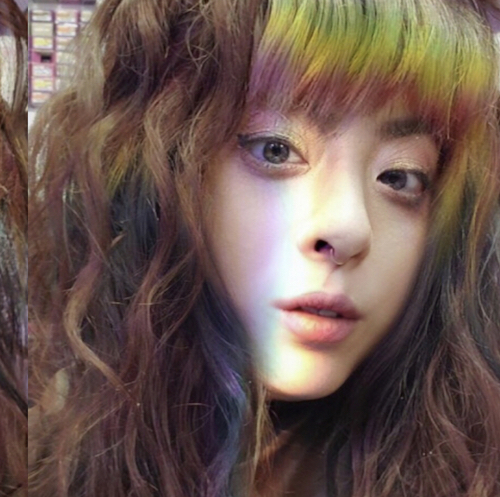
I looked nothing like this as a child.
Like so many others, I downloaded the app that can show you what you’ll look like as an old person, or as a fantastically perfect child, or as a different gender – before I realized with horror that I was giving some Russian entity access to tons of my private information. I deleted it as soon as I read about that, but honestly, whatever the Russians or whoever want to get from us, they probably can already, if we are on the internet and use social media. Something interesting happened though, in the interim before everybody got freaked out and stopped transforming themselves into old people. I saw people reckoning with aging, with the fluidity of gender, and via quite a few exuberantly snarky memes about climate collapse, with the reality that many of us may not live to see the visages of old age that FaceApp showed us. Will I look like the old woman the app’s algorithm showed me? It’s hard to say. The Russians don’t know that I slather my face in sunscreen and Korean beauty products made from snail slime and bee venom, so – we’ll see. I definitely didn’t look like an idealized Asian child when I was a kid, and neither did my mom – though it’s fun to see us all dewy and perfect in a way we never really were. What really struck me, was that I could see a version of my mother as an old woman – something no one ever got to see, because she never had a chance to become one. Most people who have moms get to see them as they age – and thus, get a glimpse of what might happen to their own faces as gravity and time have their way with sagging jowls, with the loose skin of necks, with eye bags, and heavy nasolabial folds.

So I wonder if perhaps I’ll look something like this when I’ve gone whole hag?
On a whim, I let FaceApp do its thing with an image of my mother, on her wedding day. It was a backyard hippie wedding, and she and my father were crowned with flower garlands. She holds her fiddle in one hand, and with the golden hour haze shining around her, she looks just like a painting of the kind of Pre-Raphaelite maidens she adored. The doctored image doesn’t look much like my Aunt Ruth, her sister, or my Nonnie, her mother. It’s impossible to say what kind of old woman she’d have become – but I am weirdly grateful to have this image, to imagine – my mother the crone. I remember my Nonnie’s crepe-like cheek and her wiry witch-whiskers brushing mine when she asked for a kiss. My Grampy Grover had wrinkles so deep he looked carved from a hunk of cedar like the ones here turned into tables and stool. Like the cedar table I sit at every morning, that he built with his hands. I trace its whorls and knots with my finger, though I was too shy to ever ask to trace his. And now that face is gone, that craggy visage that I loved, that fascinated me. Will I look like them? What kind of marvelous hag shall I become, I wonder. I’m planning to go full Vail Myers/Michelle Lamy, to celebrate living that long, if I get to – with thick kohl around my eyes, a hennaed tangle of curls, facial tattoos and gold teeth, like Baba Yaga (though I heard hers were made of steel.)

My mother never even got to be 40. Never made it “over the hill”, as they used to say. It’s fascinating to me that in just a few decades, that whole concept kind of just…disappeared. I remember that on my father’s 40th birthday, he showed up at the stereo and VCR repair shop (another bygone relic of a different era) where he worked to find a giant banner plastered on the front window that read “LORDY LORDY – DAVE’S TURNED 40!”. I didn’t understand the joke, or what was funny or embarrassing about turning 40. His friends and coworkers threw a birthday party for him that evening at our house, with black balloons and paper napkins that had gravestones on them and all read “OVER THE HILL”. Someone made him a big white sheet cake, with a beautiful tree limned out in black icing – but it read, “40’s NOT OLD… IF YOU’RE A TREE!” When he tried to cut it, it wouldn’t budge. He struggled with the knife, and everyone laughed, because it was made of styrofoam. All of this upset me a lot as a child, in a way I could never express to anyone. All the implications that my father was now closer to death freaked me out, as he was the only parent I had left. And all the joshing and jibing just seemed really mean. I didn’t get it, and I still don’t really. At what point did that whole turning 40 equals basically being dead stop being a thing? Maybe when people in their 50s and 60s and 70s started staying healthier and active for so much longer. Maybe we’ll see that trend shift backwards again as our quality of life changes. We might all end up looking like Dorothea Lange’s haggard and weathered Dustbowl women during the Great Depression – without a syringe of botox or a fancy snail slime sheet mask in sight.
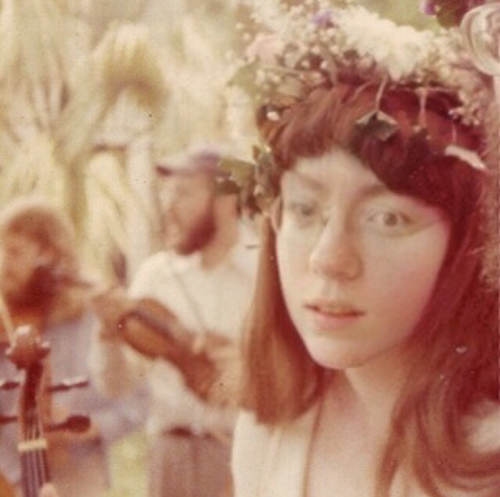
My mother looked nothing like this as a child.
One of my dear friend’s Grandpa died today, at the age of 74 (not much older than my dad is now) – and I found myself thinking, but that’s so young! And maybe now, it is. He went through the 8/8 Lion’s Gate today too – maybe to another dimension, like my mom. She and I stand face to face, on either side of that 8/8 Lion’s Gate, like the sphinxes at the Southern Oracle, uttering impossible riddles with no answers. Frozen in time, mother and daughter, eternal. Our souls looping into infinity, joined by an umbilicus – the double helix of our shared DNA, of her death and journey beyond, and my path without her – where I am becoming more and more of who I was always meant to be. Double eternity: both of us as mother, maiden, crone – forever, and never, ever and ever. Looking at these images of us, I can let my eyes fast forward and rewind on our faces – here you are as you were, as you never were, as you one day may be, or never will be. Time is more flexible than we realize. Here’s a magic mirror, that will show you how to fold the river of time like silk, like parchment – transcend it, and it all falls away.
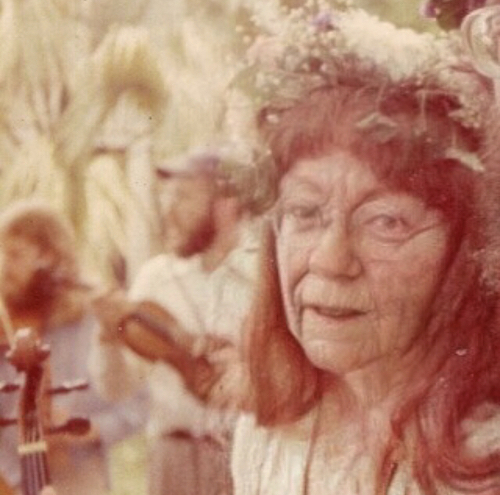
Is this what she would look like now, if she were still alive?
Jack Kornfield, the Buddhist practitioner, said that for the Lakota people, “grief was something to be valued. It brought a person closer to God. For when a person has suffered great loss and was grieving, they were considered ‘the most holy.’ Their prayers were believed to be especially powerful and others would ask the grievers to pray on their behalf.” I am starting to imagine my endless, ageless grief flowing through me and transforming into a multitude of blessings. The storm cloud of sadness and loss hovers over me, crashing lighting over my head, and pounding me with thunder. After the deluge, I am soaked with tears, that run down my face and radiate out of my eyes as rainbows. My Grampa Charlie used to say, “Tears are diamonds!” Which always made think of the folktales I read as a child about girls who cried jewels, who wept torrents of wildflowers. I’m starting to see the awful, heavy, black and smoking grief I’ve carried for so long, more like that thunderstorm that turns into rainbows, into a cascade of butterflies – because I’m learning to alchemize it. I’m learning to transform the pain I feel, the pain of those I work with, the pain of my loved ones, and the world pain felt by this planet – into something unexpectedly beautiful. Because it is all love. If grief is love with no place to go, what happens when you can send it through the glass crucible, the alembic of your heart and spirit, and like lead into gold, let it just be love again – knowing that death is an illusion, that time is an illusion, and that we are all part of each other, and everything. So, I’m not as ashamed by my grief any more as I once was. I can feel its grace now, feel it doing the necessary work. This journey of learning how to grieve, learning how to become whole, has been a long one already. May it continue long into my old age, and may I learn to do it more and more gracefully. I know I’m changing, and the way the I honor this day may change, in the years to come. I honor this journey of grieving, of remembering – this wounded tree that I am – who keeps growing in strange new directions, despite strong storms and rising tides.
If you’d like to read more about this journey of grieving, honoring, and remembering, here you go:
MY ANGELIC INHERITANCE / THE HOLOGRAPHIC WILL
38 ON AUGUST THE 8TH
30 YEARS – SEIZURES
888 – HONEY BABE, I’M BOUND TO RIDE – DON’T YOU WANNA GO?
WILD BLUE YONDER
NO ROOM IN MY HEART FOR THE BLUES
FAMILY VACATION – HANK WILLIAMS’ GRAVE
STAR-CROSSED TROUBADOURS
Foxes in the Rain
Triumvirate Lemniscate
Gustav + Mama – August 8th
My Angelic Inheritance / The Holographic Will
by angeliska on August 8, 2018
The 8th of August has rolled around again, as it is (thankfully) wont to do, and I am rolling my feelings around in my palms like the smooth sphere of pink rose quartz I meditate with – holding them gently, turning them this way and that, and just trying to sit with it all. As usual, it feels like a lot. This day holds so much for me, as death anniversaries tend to do. I’ve always used these special days to mark time, to examine my own emotional and spiritual growth and progress, and just to check in with myself. Where am I at? I feel: quiet, contemplative, heavy, grieving. My heart is full of longing and determination and love and sadness.
I’m thinking about inheritances, and what is passed down from generation to generation – intentionally and unintentionally. In the readings I give, I explain often about how lightworkers and healers have always known that pain is passed down through ancestral memory – but that only fairly recently, has it been acknowledged by the scientific community that trauma is passed down epigenetically, through our DNA. I’ve been working with my ancestors in a deeper way, in the past few years, and have found great peace in being able to integrate some of the painful stories that thread through my family line.
I’ve been focusing intently on healing, for myself, for my inner child, for the grief I carry, for my mother, and for all those that came before us. It’s a massive amount of psychic material to process, but I’ve had a lot of help along the way, from wise and generous teachers – and I’m so grateful for that. It’s been huge to step back and really take a look at how far I’ve come – how much I’ve moved through since I really became aware that if I didn’t, I might get seriously stuck in the sorrow, and in some really self-destructive patterns and coping mechanisms that I had no wish to hold onto. We inherit pain, and we inherit joy – or the capacity for it, and I’ve learned that when we protect ourselves from that pain, that we also protect ourselves from the joy.
I’ve been embracing joy more and more – and understanding that bliss is my birthright, is all of our birthrights. We didn’t come to this planet to suffer, believe it or not. We came here to love, and to be loved. So I’m holding that today – the love, and the sadness. I’ve discovered that it’s okay for them to hold hands, that it’s possible to feel them both at the same time, and came to understand that they don’t cancel each other out, but rather, support a deepening into both. There’s a saying about grief that I’ve been thinking about a lot lately – that grief is just love with no place to go. This is the place I come to every year, to put all my grief, and all my love. Thank you for coming to visit this place with me.
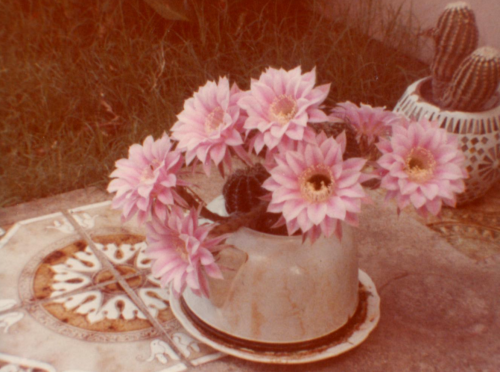
My mother’s prized cactus blossoming on our back patio
“Grief, I’ve learned, is really love. It’s all the love you want to give but cannot give. The more you loved someone, the more you grieve. All of that unspent love gathers up in the corners of your eyes and in that part of your chest that gets empty and hollow feeling. The happiness of love turns to sadness when unspent. Grief is just love with no place to go.” – Jamie Anderson
Here’s my mom waving from the open window of her pride and joy, her legacy, a white 1959 Buick Electra Sedan she named “Gertie”, after Gertie the Dinosaur. She was so proud of that car. It was the culmination of years of longing and fascination for classic cars that she’d had since she was a kid, most likely inherited from the deep appreciation her father, my Grampy. Grover was a mechanic, and the rusted hulls that became our inheritance still inhabit the back pasture out in Lone Grove, down the little dirt road named for him – “Grover’s Paradise Lane”.
My grandfather’s idea of paradise was definitely a place where he could haul all the gutted chassis of his beloved old Morris Minor trucks and Datsun pickups and Rabbit hatchbacks and tinker with them and all his other projects to his heart’s delight, which is pretty much exactly what he did, until his dying day. The steel bodies of those old cars loom like the fossilized shells of massive prehistoric armadillos that used to roam over the Hill Country, paint jobs flaking away into dust, backseats and wheel wells now home to snakes and scorpions. Gertie’s still out there too, with flat tires and lichen growing on her back bumper. My mom would be heartsick, furious to know that she hasn’t been driven or really dealt with probably since she drove her out there, and then died not long after. When I look at the photograph above mom waving goodbye, forever. If only she could have driven Gertie over the rainbow, through the clouds, into the land beyond. Or had a Viking funeral in that car she loved so much, instead of leaving it behind to sag and atrophy, the finned and rusted hulk reminding us how we failed her. No one had the money, the capacity, or the wherewithal to do anything with that legacy. We were all just trying to survive, to weather what a loss like that will do to you.
My mother’s death was a slow, inexorable hurricane that blasted our entire family to smithereens. Thirty-two years later, and some of us are still picking up the pieces, putting ourselves back together from the storm of her loss. My aunt Ruth dropped everything to take care of my mom as she was dying, and then she did the same for her parents, as they eventually became more and more frail. Her kids, my cousins, who were like siblings to me, got lost in the mix, I got lost in the mix – though I know that all of our folks just did the best they could to make sure everyone got what they needed, that the basics were covered. Illnesses and deaths wreak such havoc in families. We’re only now really fully grasping the impact of everything we lost in those years, and how hard it was on everyone. There are so many layers to that time that I’ve long wanted to understand – because there’s so little I remember, being as little as I was, and pretty severely disassociated from the very upsetting present reality that was happening then.
I remember one of these August 8ths, a few years back, I went out to Lone Grove to visit my mom’s grave, hoping Ruthie would be willing to talk to me, tell me stories about the months, weeks and days leading up to my mom’s death that are still just an amber blur to me. Three years ago, she just wasn’t ready. Maybe it wasn’t the right moment, or she wasn’t in a space to, or perhaps it was because we weren’t alone, there were other people there who wouldn’t be comfortable hearing those stories – or perhaps she wasn’t comfortable with them hearing them. I was so disappointed though – I really wanted to know, to get a better understanding of what it had been like for her, for my mom, for me – for all of us. In the past few years, the memories have been flooding back to my aunt, and she’s been opening up – telling stories rich with the kinds of details I’ve craved, that I’ve longed for. She paints a picture for me, of our shared history – and I help her hold it, now that I am grown, and strong enough.
Out of the blue last month, the floodgates opened, and we were sitting at the table in my kitchen that Grampy made from cedar, when my aunt told me that my mom had fallen into a coma before she died. I don’t think I ever knew that before, or if I did know, I’d either blocked it out or didn’t understand what I coma was. It’s strange, the way we talk about it – like a coma is something you could just trip and fall into, like a deadly puddle, or like quicksand. That it might suck you down deep and never let you come back up for air again. Well, that’s what happened. Aunt Ruth had driven the hour and a half back to Austin for the first time in weeks, and was at home, finally, trying to achieve some semblance of normalcy for her own little family unit. She had just made a meatloaf and put it in the oven when the nurse called from Lone Grove saying she needed to get back up there as soon as possible – that it might be hours, or a couple days, but that it wouldn’t be long. These stories told in flashback, me putting together the pieces, all the events leading up to August the 8th, 1986 – the freight train running on its course to one inevitable end: the tracks running out, a dark portal at the end of the line, the black hole that my mom fell through.
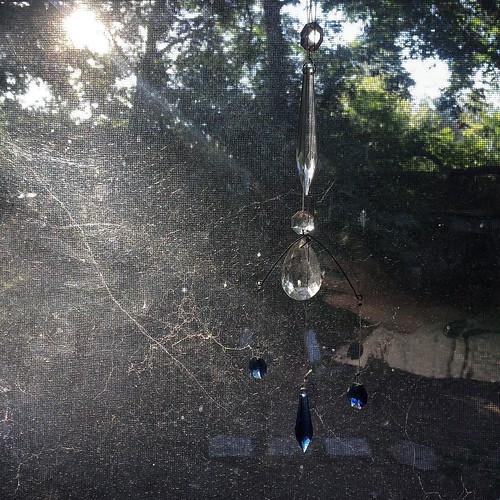
My bedroom window in the dawning, illuminating cobwebs & crystals.
Before that, there was the morphine in the big brown bottle my mom had to drink for the pain. It only could be procured at one pharmacy a few towns over, and one weekend, there was an emergency – it had been a rough week, and the bottle had emptied faster. My mom was frantic, inconsolable, and sent Ruthie on a mad dash to get the prescription refilled before the pharmacy closed for the next few days. My mother was horrified at the idea that she’d become a drug addict, and was really freaking out about it, until the lady from the hospice came by the house to talk to her, and explain that she really did need this medicine for the pain.
I didn’t know about this, or that my mom had become obsessed with the idea that all our food was was toxic, fast food and sugar and junk. She was terrified by the idea of cancer-causing pollutants in the air, in the water. She wasn’t wrong – but it wasn’t doing any good. By then, it was too late. I think that hit her one evening when she was taken by a craving for a cheeseburger and french fries. I guess she had maybe invoked the “holy fuck it”, and asked Ruth and Grampy to take to over the Marble Falls to the Sonic, because Llano didn’t have one of those back then. They decided to eat at the picnic tables instead of in the car, as they were finishing their dinner, a father and two little boys sat down at a table near by. The boys were dressed in cowboy costumes with had cap-guns in little leather holsters, and were chasing each other around the tables, making a ruckus. At one point, one of the boys turned to my mother and fired his cap gun at her, yelling “BANG BANG! YOU’RE DEAD!” It upset her so much, she totally let loose on the kid, yelling at him in a rage. Grampy was mortified, not understanding her reaction – saying “Cissie, now why’d you go off and holler at that little ol’ boy?” I can hear his voice in my mind, exactly, asking that question. The boys’ father didn’t get it either, until Ruth went over and quietly told him, “My sister has terminal cancer.” The man’s face turned white, mortified, and he gathered up his kids and left.
I don’t think I’d ever heard that phrase spoken aloud before I’d heard this story. Terminal cancer. Or, again – maybe I had, but I’d blocked it out, or didn’t really know what it meant. I think when you’re little, death is just an idea – a very foreign one. For many adults, it’s still a vague notion. Something we don’t often talk about, or address directly. There’s so much fear around it, and so much denial – which we think protects us from it, but really it doesn’t. I think it makes it worse. I think it’s better to look, with clear eyes, at the honest reality of it. I believe there’s more compassion in that way – in the way of truth.
My mother’s organs were shutting down, one by one. Ruth told me, “The heart is always the last to go.” She observed that with my mom, and from years and years of seeing animals make their exits, both at home and at the animal shelter where she used to work. She said, “That’s how it is when a living being dies – the rest of you can be completely shot, ready to go, but the heart holds on tight until its last beat.” Life preserves life, or tries to.
I’ve been digging deeper into the ugly reality of what it is to die from cancer – how debilitating, how incapacitating that process can be. I’ve needed to really absorb what it was like for my mom, because I was so protected from the process as a child, and so really couldn’t fathom how much pain and fear she was experiencing. I didn’t understand why she didn’t have the energy to talk to me, or engage with me. I took it hard, thought it meant I wasn’t lovable. I think I’ve always had this gothic, romantic idea of the invalid consumptive, coughing delicately into a bloodied lace hankie, languidly approaching death while still penning letters and posing prettily with hair fanned out on silk pillows like a Victorian painting. I was kept out of the sick-room, but I’m pretty sure now that my mom’s death wasn’t anything like that. Knowing this helps me forgive her for not preparing better, for not leaving any messages for me, for not talking to me about what was happening to her, where she was going. I always thought that was because she didn’t care. Now I know that it’s because she was too sick, too out of it, too scared and also – deeply in denial. Up until the very end, she was praying for, and believing in a miracle that would save her life. She appealed to Jesus Christ and the Virgin Mary, and even a faith healer quack doctor up in Houston. Instead, she went into a coma.
I guess I always assumed I’d go the same way – that there’s was only one real, concrete way to die that I’d seen firsthand, and eventually it would be coming for me, too. I’ve always pictured a long and agonizing convalescence for myself, ending up with the same cancer that killed my mom. It was never a matter of being morbid, really – it just seemed logical. Lately, I’ve been second guessing that forgone conclusion. I mean – I intend to live for a very, very long time (if I have my druthers), and would prefer to depart this plane of existence well into my as a nonagenarian if not (ideally) centenarian. I’ve been looking at my astrological chart, and given that I have Uranus in the 8th house, this would indicate that I will instead, one day die very suddenly (and potentially painlessly!) in very unusual circumstances. This placement is found in many of the charts of people you read about in the news who perish in bizarre situations. I think about this when I travel, when I’m doing something foolhardy, like climbing a rickety ladder alone in my house, or when I would fall asleep directly beneath my chandelier in New Orleans, from which radiated cracks into the crumbling plaster.
Despite those potential pitfalls, I’ve intentionally sought to make this one a fairly risk averse lifetime – I mean, I’ve done a lot of insane shit, and probably will continue to – but I’m not a thrill seeker. I don’t fly in tiny airplanes, go bungee jumping, skateboard, or parasail. I keep my feet mainly on the ground, and will try to hold off the reaper, hopefully for decades to come.
That being said, I’m finally doing something that I’ve said for years that I would do – something I’ve believed fervently that every adult person should do, but somehow never got around to quite yet: I’m writing my will. You’re really not a true adult until you do this. I’m embarrassed at how long I’ve known I needed to do this, and yet not done it. It’s such irresponsible, inconsiderate, avoidant bullshit to not to do it – and yet, we exist in a culture of denial around our mortality that supports a kind of superstition around actually talking about and preparing for your death, as if to do so might bring it closer. Death is coming for each of us, whether we prepare for it or not. To tiptoe around it or pretend like it won’t ever happen is to potentially put your loved ones into a world of misery and confusion when trying to figure out what to do with everything you’ve left behind, on top of the grief and sadness they’ll already be dealing with. It doesn’t actually take much to put your affairs in order, and so like a dutiful Capricorn (going through some major Pluto and Saturn transits), I’m gonna lay it out for y’all (and myself) as best I can.
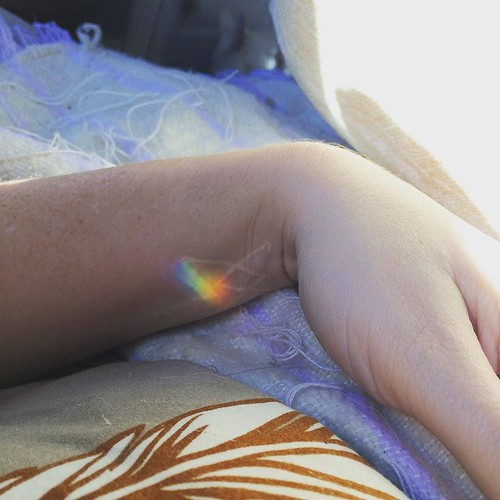
A rainbow prism appearing like a little benediction over scars on top of scars.
My mom always hung chandelier crystals in the windows of my childhood bedroom,
so that I would always be surrounded by rainbows on sunny days.
As I set out on my mission to cross this looming behemoth off my perpetual to-do list, I came across a term I’d never heard before: the holographic will. What a wondrous sounding thing! You might imagine a document made out of refracted light and prisms, or perhaps a glowing figure, the ghost of your loved one dictating their wishes from beyond, as a hologram. Strangely, it is neither of these things. A holographic will is just a handwritten document outlining your final wishes. These are not legal in all states, and of course it’s best to bite the bullet and have an official document drafted, witnesses and filed by a lawyer. But I know many of us might not get around to that, and something is better than nothing, right? Check and make sure holographic wills are accepted as legal where you live, and then sit down and write one out. Just do it, okay? Even if you think you have nothing. Chances are, you have some debt you’re leaving behind for your loved ones to deal with, plus all your stuff, and most likely, your body. What do you want done with all that? Don’t say you don’t care, or think that no one else willing. Somebody is going to have to reckon with you when you go, so make it easier on them – it’s just the right thing to do. Once you’ve dashed out (or calligraphed, or whatever) your holographic will in your own hand, being of sound mind, delineating what you would like done with your stuff and your body, and who’s in charge of all that, you’ll have a some kind of document to take to a lawyer when you’re ready to be even more official and adult. It can be really simple, if you want. It doesn’t have to be daunting, or sad, though it might feel that way. Feel those feelings, and DO IT ANYWAY.
“Holographic wills are common and are often created in emergency situations, such as when the testator is alone, trapped, and near death. Holographic wills often show that the requirements for making a valid will are minimal. The Guinness Book of World Records lists the shortest will in the world as ‘Vše ženě’ (Czech, “everything to wife”), written on the bedroom wall of a man who realized his imminent demise and made a swift attempt to distribute his chattels before expiring. It clearly meets the minimum requirements, being his own work and no one else’s. On 8 June 1948 in Saskatchewan, Canada, a farmer named Cecil George Harris who had become trapped under his own tractor carved a will into the tractor’s fender. It read, ‘In case I die in this mess I leave all to the wife. Cecil Geo. Harris.’ The fender was probated and stood as his will.”
So, at the very, very least – write something somewhere, and let someone know about it. As an additional note to creative people reading this – your writing, music, paintings et cetera are all part of your estate. What do you want done with that stuff? Who has the rights to it? Think on it, and then go read what Neil Gaiman wrote on the subject a while back on how to prepare. He even offers a template for a sample will that will help you figure out what to do with everything. As he says, “It’s a PDF file, which you can, and should, if you’re a creative person, download. Pass it on. Spread it around. And then, if you’re an author, or even a weekend author with just a few short stories published, or one thin book you don’t think anyone read or would want to republish, fill it out. Sign it and date it in front of witnesses. Put it somewhere safe. And rest easily in the knowledge that you may have made some anthologist, or some loved one, in the future, a bit happier and made their lives a little easier. Or better still, print it out and take it to your own lawyer/ solicitor or equivalent legal person when you get a formal will drawn up. Take it to a lawyer and discuss your choices. And the same goes for you artists, photographers and songwriters, although a few words may have to be changed or added.”
Here I am, in my beloved bedroom, a few birthdays ago. What will happen to that room, that house, that bed and that Art Deco lamp and those blue bottles (all inherited from my mother), that chandelier, that stuffed goat head, that bathrobe, that body when the spirit has left it? Who will take down all the crystals I’ve hung in the windows, like my mom hung for me when I was little? Someone will have to, eventually. Again, it’s not morbid to think like that. It’s just real. Someone’s always left behind to pick up the pieces – even when you think you don’t have anyone. Chances are, you do. I’ve got a lot to sort out, it turns out. Tons of stuff to leave behind, to be dealt with. All my collections, my precious accumulations. Someone will have to sift through it all, distribute it elsewhere. What will happen with all my creative work, my writing, my home, and my dogs, should I not outlive them? I have some ideas, and it’s time to sit down and consign them all to paper, even if it’s just roughest outline. What is the legacy we leave behind? This is a good, and necessary question to contemplate. I come from a family of earth signs. We like our stuff, and we tend to kind of end of with a lot of it. You could call us collectors, though there is a marked tendency towards hoarding, on both sides of my family line. It’s something I have to watch, be very mindful of. A kind of sickness around objects can grow when you’re not looking – a fear of losing that turns into a hunger for acquisition. Being an antique dealer for so many years, and an intuitive/psychic being, I became very aware of the resonance carried by objects, the memories they can hold. Trawling estate sales showed me the intense pathos of a home stuffed to the brim with junk and treasures, the meanings and stories lost – only to to be pawed and fought over by strangers. It’s a very invasive and strange process, and eventually turned me away from wanting to work with stuff and objects, and towards wanting to work with people and their hearts instead.
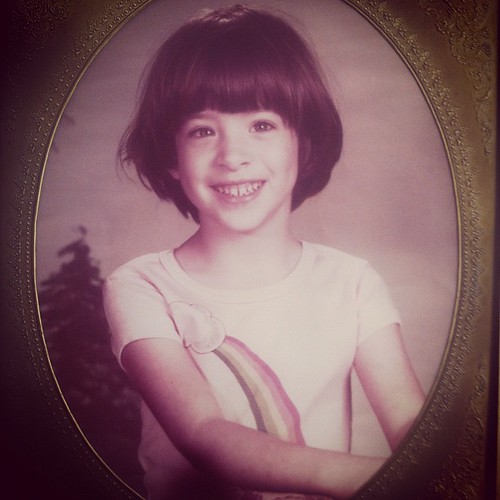
Little me, rockin’ a bowl haircut…
This picture was taken only a few years before my mom died. She was already sick, already struggling. I was so, so little. That pink shirt with the rainbow and the pot of gold was my favorite, and I was excited to wear it for picture day. It’s weird to think about someone this young not having their mom – and by weird I mean totally wrong and fucked up. I really needed her to be okay, and she couldn’t be. We didn’t have a choice in the matter. My mother made a holographic will, before she died. I’ve had a copy of it for a long time, since I was pretty young. My aunt gave it to me when I was a teenager, and I’ve pored over it endlessly, because it’s one of the only documents I have where my mother mentions me directly, aside from some letters, and the one journal entry I found. “The” List (as it is titled) was handwritten on a yellow-lined legal pad, in my mother’s clear and determined print that still reveals the pain she was in. It seeps into every line she inscribed. It’s only six pages, but holding it in my hands, it always feels very heavy. She wrote in these pages that she wanted us to treat her possessions as extensions of her, and she really meant it. I took this very literally.
When my Aunt Ruth started giving pieces of my mom’s jewelry and little things when I was just 13 or 14, of course an earring would fall by the wayside, the antique rosaries I wore to be punk rock disintegrated, rhinestone chokers fell away at raves and concerts, and I would feel this sinking sick dread in my stomach. I was losing her, pieces of her body, slipping away from me forever. And I thought she would be so mad, if she knew – that I wasn’t taking good care of her stuff, wasn’t respecting her treasures, her legacy. It was a lot of pressure. Sometimes it still is. After Hurricane Katrina, when people tried to tell me that line about everything I lost being “just stuff”, I tried to explain, usually fruitlessly, how it was for me. What if your mom told you that she lived on in the objects she left behind, and then died? How would you feel if any of those aspects of her were destroyed. It’s like losing her all over again. Thankfully, I have most of her beloved things intact, and I care for them and try to be a good steward for them, because I genuinely love and treasure them too. Not just because they were hers, but because I too find them beautiful and valuable.
This is my inheritance, from my mother. Her tarot deck, which has given me my life’s work, my livelihood, and one of my greatest passions. I inherited her banjo, her fiddle, her red cabbage teapot. Her perfume bottle collection, her rock and fossil collection, her car. The things that were most precious to her, and now are, to me. It’s a legacy I embrace, and have tried to uphold. I learned to silversmith, to make jewelry like she did, from her pottery shards turned into cabochons, like she did. One day, I hope to play the fiddle and her guitar, though her banjo was sadly stolen years ago. I’m working on the rest. It’s heavy, like I said. It’s a lot to carry, but I’m getting stronger and better at it, more able, every day. My cousin and I dreaming up a plan to get Gertie the Dinosaur Buick Electra converted to electric, and up and running again. I know that would make my mom happy, and I dream of the day I could cruise in that majestic boat down her favorite hill country backroads, in wildflower season.
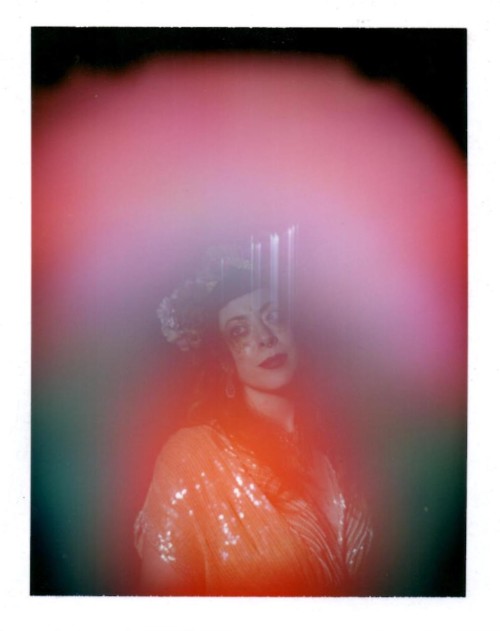
An aura photograph of me taken by MOOD by MOSS. It shows deep love, eros energy, and the rare white lights of protector spirit guides. My angels. My mama watching over me.
What else did I inherit from her? Angels to guide over me and protect me. My name. My face, my body, every bit of me that she made in her womb. She gave me every eyelash I’ll ever have, my nose, my bones, my kidneys, my eyes. From her, I have astigmatism, and an appreciation for antique roses and piña coladas and Pre-Raphaelite art and freckles on my knees. Even though we only had seven years together, I’ve inherited her gestures, her way of carrying her body. We stand in the same way, one hip cocked, head tilted, the same appraising gaze. The crooked, self-conscious, knowing smile. We both hate drafty winds and fans blowing directly on us. There are so many other things I’ll probably never know, but am always hungry to find out. There are probably so many things I’m unaware of, or that I’m forgetting. It’s overwhelming. How are we the same? What of her is left in me? Is it nature or nurture? The things I go wild for – do I love classic cars and old country music and Czech Art Deco glassware because my mom was gaga for those things, or because they speak to my heart on some core level? I’m gonna go with the latter, because that’s what feels true. I’m a part of her, and she is a part of me. We’ll never really get to know each other beyond what we got, and I think that’s the part that pains me the most. Because I think we’d have so, so much to talk about now. I think we’d be each other’s favorite person. I know she’d be mine.
This is my angelic, prismatic inheritance, received from the pages of a holographic, handwritten will. It shifts, like the crystals in my bedroom windows, it refracts light, and bounces rainbows off the inside of my eyelids. It is so big, and so vast and so heavy and so, so beautiful. It is made of memory and my mother’s whispering echoing voice, and the smell of her favorite perfume and the scent of the long gone cactus blossoms she grew. It is made of starlight and dawning, and thorns and tears. It is a totally psychedelic and transdimensional dodecahedron made out of sighs and rain and brilliant diamonds that is continuously serenaded by a chorus of baby angels wearing heart shaped sunglasses. It’s hard as hell, and heartbreaking and gorgeous and miraculous, and truly – I wouldn’t have it any other way. It is fractured and it is perfect and it is my life. There is no greater gift.
If you’d like to read more about this journey of grieving, honoring, and remembering, here you go:
38 ON AUGUST THE 8TH
30 YEARS – SEIZURES
888
WILD BLUE YONDER
NO ROOM IN MY HEART FOR THE BLUES
FAMILY VACATION – HANK WILLIAMS’ GRAVE
STAR-CROSSED TROUBADOURS
Foxes in the Rain
Triumvirate Lemniscate
Gustav + Mama – August 8th
